#Source: Cave Vol. 1 4
Explore tagged Tumblr posts
Photo


Nitro my beloved?! [1] [2] [3]
#I went overboard and made six of these but I don't like the format when they're all in the same post so I'm posting them two at a time#Nitro is thee beloved. If you couldn't tell#Nitro my Beloved#MakeSweet.com Heart Locket#Nitro#Nitro the Exploding Man#Nitro the Living Bomb#Robert Hunter#Robert L Hunter#Earth 616#Source: Omega the Unknown Vol. 1 8#Source: Cave Vol. 1 4#Marvel#Marvel Villains#Cosmic Marvel#GIF#GIFs#Heart Lockets#CinderNo
0 notes
Text


PingXie Moments Compilation
𝐇𝐚𝐩𝐩𝐲 𝟖𝟏𝟕 𝐃𝐚𝐨𝐦𝐢 𝐅𝐞𝐬𝐭𝐢𝐯𝐚𝐥!! 🎉
On this special day, let's reminisce about PingXie moments in the book∼ Fanfictions are indeed tasty, but the canon moments are also delicious, right? (≧▽≦)
Truthfully, I planned to compile all of them in one post, but I realized that there are too many PingXie moments, I'm afraid if I post them all, I will become a PingXie Bot, thus I picked some moments (and some jokes) that I thought were quite memorable and interesting. It's only 40 moments, it doesn't follow the timeline, perhaps only 80% of them.
Warning: Spoilers! Very long post! CP-oriented post! It's a compilation of PingXie moments in the book, naturally, there are spoilers. I added a little notes/meta/comments/related interviews as supplementary files. And I'm not an expert in the Chinese language (as you already know, I use mtl) so I put the source below, just in case you want to check the Chinese raw or other translations yourself. I apologize in advance if there is any mistake m(_ _)m
(Since there is a limit to insert images, I went with quoting them.)
Sources: Chinese Raw | MereBear's Translation | 瓶邪bot | Original Image by 刘巴布 | Divider by @anitalenia


1. Daomu Biji Vol. 1: Seven Star Lu Palace Chapter 2
As I was talking, I saw a young man walking out of the front door with a long thing on his back that was tightly wrapped in cloth. I knew at first glance that it was an ancient weapon. This thing was indeed very valuable, and if it sold well, the price could go for more than ten times its worth.
Note: In the book, it was their first meeting. But in an old Daomu Biji mobile game, NPSS added this line (it seems that he forgot about it later though):
“The first meeting with Zhang Qiling was not downstairs of Uncle Three's house, but at Wu Xie's full-month celebration, but they both forgot it.” ☆
2. Daomu Biji Vol. 4: Snake Marsh Ghost City (Part II) Chapter 18 | Chapter 47 (MereBear)
He continued, "I am a person without a past and a future. All I do is to find find my connection with this world. Where did I come from and why am I here?" He looked at his hands and said calmly, "Can you imagine that if someone like me disappears from this world, no one will find out, as if I have never existed in this world, without leaving any trace? Sometimes when I look in the mirror, I often doubt whether I really exist or am just a phantom of a person."
I was speechless and thought for a while before saying, "It's not as exaggerated as you say. If you disappear, at least I will find out."
3. Daomu Biji Vol. 6: Ancient Building Under the Dark Mountain Chapter 39
Pangzi gestured for me to ask Men You Ping. I looked at him and heard him say, "About five hours ago, you appeared where you are now, in a deep coma, barely conscious. We gave you a simple first aid, and then five hours later, you woke up."
I waited for Men You Ping to continue speaking, but he shut up.
"That’s it?" I asked in surprise.
"That’s it." He said in a muffled voice.
[....]
Pangzi nodded and said, "Xiaoge and I have been in another cave, which is relatively dry, but I will come here to get water every once in a while. When I found that there was suddenly another person in the cave, I was scared to death, but I recognized you immediately, called Xiaoge, and rescued you together. You were already dead, so if you really need to find someone to save your life, I, Pangye, was still qualified to make a guest appearance. Later, we were afraid that you might have broken bones, so we didn't dare to move and just waited here for you to wake up."
Note: Xiaoge gives Wu Xie mouth-to-mouth resuscitation here. Someone analyzed it and NPSS confirmed it. Here is the analysis:
“If you want to perform CPR on a person who is not breathing without moving the body, the most basic and important thing is artificial respiration. Judging from Pangzi's tone, the whole rescue process was completed by him and Men You Ping. But there is a key word here: "guest appearance". Pangzi did not play the main role in the rescue process. So who played this main role? I think everyone should understand.” ☆
4. Daomu Biji Vol. 6: Ancient Building Under the Dark Mountain Chapter 49
He leaned against the stone wall behind him and said calmly: "He and I can't leave."
"What nonsense are you talking about?" I cursed.
He suddenly smiled at me and said: "Fortunately, I didn't kill you..."
I was stunned. He spat out a mouthful of blood.
"You--" My head buzzed.
He still smiled at me, his head slowly lowered, and sat there, as if he was just taking a rest. However, the surroundings were completely silent.
Note: There once was a typo in the first draft, but it was edited later.
Edited version: “还好,我没有害死你……”
Unedited version: “一汀烟雨杏花寒好, 还好, 我没有害死你......”
“一汀烟雨杏花寒” comes from an ancient poem “戴叔伦:燕子不归春事晚,一汀烟雨杏花寒”, it describes the scenery of late spring and expresses the feelings of melancholy and separation. ☆
5. Daomu Biji Vol. 7: Stone Shadow in Qiong Cave Chapter 18
Men You Ping did not answer her. Instead, he turned to me and said, "Take me home." Then he walked out without looking back.
6. Daomu Biji Vol 8: The Finale Book 2 Chapter 3 | Part 2 Chapter 54 (MereBear)
I was stunned for a moment, and then froze. At that moment, my mind became blank.
I couldn’t describe the emptiness in my heart. I suddenly didn’t know what I should do.
Dead? You’ve got to be kidding me.
Is he really dead? Hey, what kind of international joke is this?
"Wake up. Let's go home." I patted his face, suddenly finding it all very funny. I turned to Pangzi and laughed. "Look at Xiaoge."
"I know." Pangzi said on the side, his voice was very low.
Then, my hands began to tremble uncontrollably. I looked at my hands and found that there was no sadness in my heart. My consciousness did not react, but my body instinctively felt despair.
I thought to myself, he’s really fucking sitting there, he’s really fucking dead. Men You Ping is really fucking dead!
There were actually such things in this world, and Men You Ping could actually die.
[....]
My instincts were collapsing under the pressure, but all kinds of uncomfortable feelings were still leaking out of the "pressure cooker" of emotions. I felt that I couldn't let my emotions run wild, because if I got sad, I might die here. I feel very strange in my heart, not just sad. I don’t know if others can understand my complicated feelings. First there was despair, then more of a distrust of what I saw. My mind went blank for a long time before all the emotions in my heart came to the surface.
I have always wondered how I would feel if Men You Ping died. I thought that maybe I was extremely sad, or maybe I had thought about it too much and done too much mental preparation, so I became numb and felt that I could totally bear it. Now that it has really happened, it has turned into a strange mood that I can’t even deal with.
After that, I was in a dilemma, not knowing whether I should be sad or pretend to be calm and endure the pain. In the end, the former gradually prevailed. I did nothing beside his body, just stared blankly.
But just when I felt that tears were about to fall, I suddenly saw Men You Ping's hand move and scratch the floor!
Comment: I feel like "Wake up. Let's go home." is the answer to Xiaoge's "Take me home." in the previous moment, don't you think so? And here is the description of Wu Xie's feelings when he thought that Xiaoge died. It's quite long and depressing... T_T
7. Daomu Biji Vol. 8: The Finale Book 2 Chapter 25 | Part 2 Chapter 76 (MereBear)
"I came to say goodbye to you." He said, "It's all over. I thought about my connection with this world, and it seems that the only one I can find now is you."
Comment: Is this the kind of connection that Xiaoge was looking for in Daomu Biji Vol. 4?
Note: In the Live Broadcast Interview on June 11, 2021, there was a question about what "嫩牛五方" Nenniu Wufang (Iron Triangle + HeiHua) think of Wu Xie, and this is Xiaoge's part:
NPSS: For Zhang Qiling, Wu Xie is his only connection with the human world. He can live without any connection with the human world. After so many years, Wu Xie was the opportunity that made him willing to connect with the human world, which was also something that required courage for him, because connecting with Wu Xie means connecting with other people. At the beginning, Wu Xie was just one of the many people he had saved, but Wu Xie reached a state of transcendence through his own qualities. He was able to attract another person who was not a mortal. There is such a person, when you look him in the eye, you will have this feeling-
Host: This is that person, this is the person I am looking for.
NPSS: Yes. ☆
8. Daomu Biji Vol. 8: The Finale Book 2 Chapter 27 | Part 2 Chapter 78 (MereBear)
That night, we found a relatively dry place and lit a fire. Sitting in front of the fire, he silently looked at me for the first time.
I also stared at him for a long time. Since he kept looking at me like this, I began to wonder whether the focus of his gaze was actually on me. When I found that he was really looking at me, however, I felt very strange. I said, "Is something wrong with me? Is there a monster behind me?" I asked him several times, but he didn't respond. I thought this person was not very normal at ordinary times. Now in this situation, I definitely couldn't understand and didn't need to understand. But after a while, he suddenly asked me for a cigarette.
9. Daomu Biji Vol. 8: The Finale Book 2 Chapter 28 | Part 2 Chapter 79 (MereBear)
I screamed as I rolled all the way down the hillside. I knew it was a very steep cliff with a drop of at least thirty meters, so even if there was snow below, I would never be safe.
[....]
Just when I was about to despair, I suddenly heard a movement outside. Then, my flailing hands were grabbed by someone, and I was pulled out of the snow pit. I gasped for breath, and saw Men You Ping grabbed the back of my collar and pulled me out of the snow with force.
My eyes still saw a pink color, which was quite blurry. I looked at him, and I was so angry that I asked him: "Why did you come back again?"
He looked at me, then at the cliff above his head, and said to me, "I heard your cry for help."
Note: This is one of the famous PingXie moments, which later someone brought up this scene again in the comment section of the online version of Sand Sea 3 Chapter 5 (Chapter 116 on MereBear's site: Like a Red Bean in the Exquisite Dice, My Love for You is Deep in My Bones) in 2014. Here is the famous comment that is still circulating around in the DMBJ fandom:
“The moment I fell, holding my neck, I thought I couldn't speak anymore. The sky of Motuo was still empty, just like the Changbai Mountain. But this time, no one would jump down thirty meters to pull me up. I asked him why he came, and he said he heard my voice.” ☆
However, people still doubt where this quote actually comes from. As someone said, what I've mentioned before is the most likely source since it is the earliest one that can be found. The site was closed down, so I can't check it myself.
10. Daomu Biji Vol. 8: The Finale Book 2 Chapter 28 | Part 2 Chapter 79 (MereBear)
"That’s fine, do whatever you want. If you really knock me out, I have nothing to say, but I hope you know that if you need someone to accompany you to the end, I won’t refuse." I said, "I want to accompany you. This is my own decision, so don't worry about it."
Top comment: One is a confession that travels thousands of miles away, and the other is a stumbling pursuit. ☆
11. Daomu Biji Vol. 8: The Finale Book 2 Chapter 29 | Part 2 Chapter 80 (MereBear)
Men You Ping nodded, and I asked him: "If this is not the case, according to the promise, who should be the next in line for the Old Nine Gates?"
"You." Men You Ping said.
Me? I was stunned for a moment: "You mean, I was supposed to stay behind this bronze door for ten years?"
Men You Ping nodded, and just as I was about to ask him to clarify, Men You Ping suddenly reached out and pressed the back of my neck, and I lost consciousness."
12. Excerpt from 《与邪共予起灵书》 or see more here
I saw Menyouping standing in the dazzling light of the bronze door, as if waiting for me. It turns out that not everyone has left me. He is right here, behind this mysterious bronze door, looking forward to meeting me again just like me. Ten years, it sounds like a long time that cannot be passed, but when that moment comes, we will definitely feel the brevity of time. Its brevity may just be because you are looking forward to a reunion. You use your ten years to exchange my lifelong innocence, then I will use the next ten years and more ten years to exchange your ten years.
The passage above is related to the famous quote “用我一生换你十年的天真无邪” (I'll give you my whole life in exchange for your ten years of innocence).
According to this post, this sentence first appeared in a forum interview in 2010. When NPSS talked with readers about the final ending of the characters in the main story (Daomu Biji Vol. 1-8), he used the sentence "用自己的一生,再换你十年的天真无邪" (I'll give you my whole life in exchange for another ten years of your innocence) to summarize the ending of Zhang Qiling and Wu Xie in the main story.
NPSS's interview with Nangong Ling, the owner of PingXie Bar on Baidu Post Bar or Tieba (a popular Chinese forum) at that time: The Long-Delayed New Year Interview on March 11, 2010 ☆
Q: Is Wu Xie the most miserable person in the whole book? Is it true that one of him and Pingzi (Xiaoge) will die in the end?
A: Wu Xie is the most miserable, his life is a doomed tragedy, but Lao Zhang is not easy either.
Q: Then?
A: It delayed the occurrence of the whole tragedy.
Q: Then they suffered a tragedy together?
A: I use my life to exchange for your ten years of innocence.
And there is a follow-up. On November 1, 2011, NPSS participated in a symposium at Shenzhen University and interpreted the meaning of this sentence. ☆
Q: How do you understand "用我一生换你十年天真无邪" (I will give you my whole life for your ten years of innocence)?
A: On a very quiet night, I was sitting in front of my computer, chatting with an online friend who was my reader. She asked me if I could describe the whole story in one sentence. Then I thought about it and realized that the story could be described in one sentence: "用我一生换你十年的天真无邪" (I will give you my whole life for your ten years of innocence). It is not a very equal exchange. It is an infinite sacrifice of one person for another in exchange for a limited benefit.
13. Tibetan Sea Flower Part 1 Chapter 39
I said, "I don't know. I always feel that it's safer to be around Xiaoge. If he's not around, at least having his statue is better than having no statue at all."
14. Sand Sea 2 Chapter 53 | Chapter 92 (MereBear)
"Are you really willing to bear it?"
"I have no choice."
"You have a choice, you just can't see it."
"That means there is no choice."
Sigh
"Then will you tell him all this?"
"No."
"Then what will you tell him?"
"I will tell him that he is just a patient, and from now on, he can rest."
"They won't let you say these words."
"I won't allow them to stop me."
15. Sand Sea Part 3 Chapter 5 | Chapter 116 (MereBear)
玲珑骰子安红豆,入骨相思知不知
A dainty die with red beans engraved in it, don't you know, is a love yearning that penetrates to the bone?
(—Rediscovering Wen Tingyun by Mou, Huaichuan)
Note: As we know, this candy is only a title, but it has a deep meaning. “玲珑骰子安红豆,入骨相思知不知” is a passage from a poem by Tang Dynasty poet, Wen Tingyun (温庭筠), it's the second poem of two love poems in his collection of poems 《新添声杨柳枝词二首》/《南歌子词二首》.
井底点灯深烛伊,共郎长行莫围棋
玲珑骰子安红豆,入骨相思知不知
The poem is written in the voice of a woman, expressing her attachment to her lover, in the first line, it means she earnestly asked her husband not to miss the return date when he travelled far away. It is the woman's deep longing for her husband and the strong love she has for him that is hard to let go. The second line means the lovesickness that goes deep into the bones, revealing -once again- the woman's strong love that is hard to let go. And the words "Don’t you know?" (知不知) vividly expresses the woman's long separation, the difficulty of reunion, the deep pain of missing him, and even the fact that she wants to talk to no one. It can be said that the ending is natural and the aftertaste is endless. What the readers feel is the sincere and passionate love in the woman's heart —Baidu Encyclopedia
Since there is no way for me, a complete novice, to explain it through semantic and syntactic analysis, please visit here or here for more explanation.
In WeChat interview on August 6, 2013, NPSS said the reason why he chose that title:
Q: Sanshu, I would like to ask you, in Sand Sea series, when Wu Xie was slashed in the throat by the man in white, why was the chapter titled "玲珑骰子安红豆,入骨相思知不知"?
A: I chose that chapter title because that was the emotion I felt at the time. ☆
16. 2014 Chinese New Year Special "Fantasy" Chapter 27 (Epilogue) | Chapter 2.31 (MereBear)
When the sun absorbed the fog and dispersed it, the black fog completely dissipated. I turned my head to see where Men You Ping was, but saw the sunset shining in from the window next to me.
It was over, I was stunned for a moment and realized.
I was back in the small power station.
My hands and feet slowly revived, and the severe pain in my nasal cavity began to attack. The throat was full of the smell of blood, and all the blood turned into a paste in my throat.
In all the moments of coming back, I always felt a very sad emotion in my heart, which would make me silent for a moment.
Don't make the illusion too beautiful because it will eventually disappear. You think you have obtained and grasped it, but in fact there is nothing. This kind of memory is no different from my real memory. People themselves cannot really own anything.
17. Ten Years Chapter 31
This was written for me, he knew I would fulfill my promise. He hid the clue in Chen Pi Ah Si's nose, which really gave me face.
I clenched my fists, and a sense of security that I hadn't felt for many years suddenly rose from the bottom of my heart.
Note: The bolded sentence is an additional sentence in the physical book of Ten Years.
18. Ten Years Chapter 36
In the past ten years, I have had many dreams. I dreamed of him when he was young and I met him when I was young.
19. Ten Years Physical Book
"Not only that, if you can truly believe that you can do this, you can do anything." The voice in my heart answered me, "But, believing in yourself may be the most difficult thing in the world."
"What's so difficult about believing in yourself?" I asked.
"Just like you can't believe that you can walk on the water, only a very few people can truly believe in themselves." The voice in my heart answered me, "You can't even believe that you really entered here and heard these words."
A vast pool of water suddenly appeared in front of me, and the water surface was as calm as a mirror.
I looked at the surface of the pool and touched it with my feet. It was cold water. The waves spread and quickly disappeared at the end of the visible range. I saw a figure appearing very, very far away.
It was a familiar back, it was Xiaoge.
I stepped on it and fell into the water.
Then, I woke up. I looked up at the bronze door.
It was a dream, the door was still closed tightly.
I looked at my hand, and the wound was not cracked.
Comment: I really like the implication here, Wu Xie trusts Xiaoge more than himself...
20. Ten Years Chapter 41
"The people in that village make a dessert from glutinous rice and brown sugar. Since there’s plenty of rain in the village, a special weed called Yuzai ginseng grows there. The petals of this weed are put into the dessert, and are said to help with memory. Of course, it’s only a local legend."
I kept yawning as I spoke. My consciousness began to blur, but I didn’t stop talking.
I don’t know how long I stayed up, but in my hazy state, I suddenly felt someone slowly sit down beside me.
I hesitated for a moment, turned my head to look, and the other person also turned his head to look at me.
Pangzi slowly woke up and looked at us.I saw a familiar face, indifferent eyes, reflecting the light of the campfire.
People say that when you forget someone, the first thing you forget is their voice. But when he spoke, it wasn’t unfamiliar at all.
"You are old." He said
The music was still flowing, in this place closest to hell.
Pangzi came up, hooked his arm around Men You Ping's shoulder, and caused him to stumble: "How can we compare with you, Xiaoge? And you were willing to come out!!"
Men You Ping swayed from all the jostling.I pulled down my sleeve, covered the scars on my arm, and stood up.
He smiled at me and I lifted my bag: 'Let’s go."We just…haven’t seen you for a long time.
....
I live at the North Sea and you at the South Sea,
I asked the wild goose to pass a letter but was told they could not.
Each of us held a cup of wine and talked amid spring wind with peach and plum blossom,
For ten years we missed each other before lamps during night rain outside.
Note: About the poem, MereBear has already explained here. This is the Chinese version:
我居北海君南海,寄雁传书谢不能;
桃李春风一杯酒,江湖夜雨十年灯。
In short, it's about friendship, a happy gathering and how deeply they missed each other after they parted.
There is an interesting meta about Xiaoge's "you're old", read here.
Top comment: So when Xiaoge explained the amnesia brought by the heavenly gift in Sea of Lights, he looked into Wu Xie's eyes and said "there will be a little left", which means that Xiaoge faced endless darkness in the door, lost his perception of time, and had to use his remaining memory to try to recall Wu Xie's appearance. The words "you are old" in the past ten years contains Xiaoge's deep and heavy longing for Wu Xie.
21. Daomu Biji Extra: 2019 Mid-Autumn Festival
If Men You Ping said something, then it was fine, but he wouldn’t say anything. Instead, Zhang Haike kept telling me that as an outsider follower of Zhang Qiling, I should take care of these things. Fuck that shit, I thought to myself. I’m a guardian, not an outsider follower. He said that if I did well, I could start the special procedures that would give me the surname Zhang. I could be called Zhang Xie or Zhang Wu Xie in the future. Of course, I could also follow my master and be called Zhang Qixie.
I was so angry that day that I thought my liver was going to burst.
22. Daomu Biji Extra: The Other Shore | The Other Shore (MereBear)
It was too cold here, so after I died, I wouldn't be degraded. I would exist here for thousands and millions of years. I could sit here and let the wind and snow freeze me. According to my experience, hundreds of years later, Men You Ping would see the moment he was seeing now.
I seemed to be seriously ill and chose this ending myself. I was surprisingly calm and had no regrets. Although I could not be truly eternal like him, I found a way to coexist in the same time and space as him.
[....]
I didn't expect it to be so romantic. In this world, there was no other person who could use death as a romantic condiment so naturally.
Note: I think almost the whole short story is candy with a knife, but I can't possibly put it all here. There is a good PV about this short story, you can see it here or here.
Top comment:
”When we first begin to truly love someone, our greatest fear is that the person we love no longer loves us. What we should be afraid of is that even though they are dead, we still can’t stop loving them.”
23. A joke that is written by NPSS and posted on the official blog on Weibo
I hope this letter finds you well, I have heard that Wu Xie is well-informed, has a strong memory, is wise in all things, knows everything about the world like a little snow falls on a red stove and melts immediately, and often stays by the side of the patriarch as the two musical instruments strike the same note. I will come on the moon to meet you.
I looked at the letter, and Pangzi also looked at it, looking at me with an awkward look. I touched my nose and said, "What is this, Chu Liuxiang?"
Note: This joke was about the Zhang family sending a letter to Xiaoge and Wu Xie. “笙磬同音” (the two musical instruments strike the same note) is a metaphor for harmonious relationship as a family, but is often used in wedding congratulations. ☆☆
24. Thousand Faces Part 1-001 | Part 1-Introduction 2 (MereBear)
She looked at me and said, "Wu Xie, what is the secret in your heart? Is there anything you will never let anyone know until you die?"
I looked up at him, and a thought moved in my heart. She tilted her head and caught it: "Ah, you have it in your heart."
I smiled awkwardly. Yes, my thoughts moved just now.
I did have one.
I asked Ah Tuo: "Isn't this embarrassing?"
"That's something only you know." Ah Tou looked at some group photos I had hanging in my study room. "If I tell you a secret that I think is the most incredible. You have to tell me the thought you just had."
[....]
She looked at me, "Let me guess first, do you want... to live forever?"
[....]
"I do, but this is not my secret." I said to Ah Tou, "If there is no afterlife, then I want to live forever. I still have a lot of things I want to do with my friends, but I am not afraid of death. The richness of my life is second to none. I have enough. However, I agree to your conditions."
Note: In the second line, "我抬眼看着他" (I looked up at him), if it was referring to Ah Tou, "他" should be "她". I don't know whether it's a typo or not, some say it's not, and I check the Chinese raw, it still hasn't changed. If it's not a typo, "him" in "I looked up at him" can actually refer to Xiaoge, someone explained it on MereBear's site. Nevertheless, it doesn't change the meaning of "if there is no afterlife, then I want to live forever". Later, in Notes in Rain Village: Courtyard Chapter 12 or Notes in Rain Village: Part 2 Chapter 17, it was emphasized again:
Maybe I don’t believe in the afterlife.
Moreover, the afterlife is meaningless to me. I will not have a more thrilling life than this one.
On the ancient road, I met the ancient soul.
25. Restart Part 1-Not a Chapter | Restart Part 1 Chapter 112,5 (MereBear)
I drank to my heart's content that night. In the past ten or twenty years, I spent my days alone imagining things, panicking and being cowardly. At this moment, I understood the meaning of all of this.
I said to Bai Haotian, "I always hope not to disappoint others. Although it is difficult, I have finally reached the point in my life where I will be satisfied if I can just not disappoint one person."
[....]
I dreamed of the Tibetan Lama Temple, the floating ribbons in my dream, and I dreamed of everything, where I belonged, where my life belonged to, but I dared not touch, emphasize, or solidify it. I was afraid that I was not worthy of those memories, those times. Even though I had done so many things and controlled so many other people, I still did not dare to say any beautiful words.
26. Restart Part 1 Chapter 141 | Part 1 Chapter 141 (MereBear)
What was so important about me? I was a person who would have to say goodbye to Men You Ping one day in his life. I was a person who delayed Pangzi for getting rich and getting married. I made Xiaohua bankrupt, separated Xiuxiu from her closest relatives, and made my parents live in fear that I would follow Uncle Three’s path. I was far from worthy of the name "innocent (无邪)" my grandfather had given me. But in my confused first half of life, I lived an incredibly wonderful life. I had seen countless wonders in the world. I had the most amazing partner with the most stories in the world. We sang loudly on the cliffs, chanted the sutras on the snow-capped mountains, drank wine in the Gobi Desert, and watched the moon on the sea.
I've had enough in this life.
In Sina Weibo micro interview on August 03, 2018, NPSS talked about the bolded sentence:
Q: In the past ten years, Wu Xie's inner demon was Xiaoge. Ten years later, is Wu Xie's inner demon the life span? In the Reboot, he mentioned it many times. I feel depressed when I think of "I am a person who will have to say goodbye to Men You Ping one day in his life".
A: Most people in life will eventually say goodbye. For the one who leaves first, everything will return to peace. The one who leaves later will feel a little painful. It's not that scary. It's just unwilling to accept it.
27. Restart Part 1 Chapter 204 & Chapter 208
"...You have to understand what love is. Love is like a ghost. You can't see it when it comes, and it makes no sound when it leaves. Even if it's there, it's moving around. This thing doesn't make sense, it's fucking haunted. When you see it, it'll just pat its butt and leave. You ask it if it wants to leave or not. If it doesn’t go, you’ll have to light three pillars of incense. If it goes away, you can't find it back even if you burn down the house..."
[....]
"I just want to know what's behind the bronze door. If I'm about to die, can you please whisper something in my ear?" I said in the direction of Men You Ping.
There was no response from the other end, so I said, "If I am about to die, just say something in my ear, and then I will leave with peace of mind. Otherwise, you can't send me away even with three pillars of incense.
28. Restart Part 2 Chapter 12 | Chapter 12 (MereBear)
...But when I saw the look in Men You Ping's eyes when he looked at the rain, I didn't know what year or century he was thinking about.
It was so annoying to partner with a god.
29. Notes in Rain Village Chapter 5
Men You Ping looked at the snow. The wind was blowing in the wrong direction, and the snowflakes kept drifting in. His hair quickly turned white.
I wonder what he would look like with white hair.
30. Notes in Rain Village Chapter 15
"If I were your child*, would you not allow me to smoke?"
"Ah, I don't know, but you fell into a crack in the ground in the middle of the night. I don't have a daughter with night blindness." I glanced at Men You Ping, who was leaning against the door and looking at the two of us. His expression seemed to say, "You two both fell into a crack in the ground, what's there to discuss?"
Note: "If I were your child" is “如果我是你生的” in Chinese raw. There is a comment saying:
“The sentence "if I was born by you (如果我是你生的)" is very interesting. Children usually only use the word "birth (生)" to their mothers, and should say "if I were your child (如果我是你的孩子)" to their fathers. Xu Lei (NPSS) used the word "birth (生)" to Wu Xie through the girl's mouth, and I dare not think about it too much.” ☆
Comment: It's not the first time NPSS used the "birth" joke to Wu Xie, and I still remember how Wu Xie's word in Restart "我他妈能生四个" (I can give birth to four) is like a well-known joke in the fandom. So, I can only blame NPSS for how normal I feel about PingXie Mpreg fics and how many there are.. (ᵕ—ᴗ—)
31. Notes in Rain Village Chapter 17
Men You Ping walked towards us, one step, two steps, three steps, six or seven steps.
He walked to our side, and I looked back at where he was just now, and he was no longer there.
Don't worry about it, I thought to myself, we couldn’t go up, so he walked down.
32. Notes in Rain Village Chapter 23
The two dismantled caissons were finally put up with a simple scaffolding. Men You Ping was so damn cool, I had no idea how he dismantled it. Apart from the movements, I found his extreme concentration and skill really enviable.
33. Notes in Rain Village Chapter 24
I felt a little dizzy after drinking and had a very long dream that night. I dreamed of snow-capped mountains and my own ending.
It was the first time I had this kind of dream, but I knew that I would often dream about this moment from now on.
In this world, everyone was a circle and Men You Ping was the only eternal straight line. We were strung on this straight line like Buddhist prayer beads, heading for the other side that Buddha could see. It was just that the other side was an infinite time and space.
34. Notes in Rain Village: Courtyard Chapter 4 | Chapter 9 (MereBear)
At about 9 o'clock, I was looking at the yard from the window and saw Men You Ping tidying up the moss in the yard alone. I leaned on the windowsill, he sorted it out for more than two hours, and I watched him for more than two hours.
I didn't know if he liked my plan or not, but I thought if Pangzi liked it very much, he might like it a little.
35. Notes in Rain Village: Travel Chapter (Physical Book Version)
That night I had a dream. I dreamed that all the happiness here turned into little elves, flying around people. There was also one behind Deren. His face was constantly changing, but the elf was still shining.
"Don't worry, it's okay." In the dream, Men You Ping said to me. The elf behind him hid in his hair and looked at me shyly.
36. Notes in Rain Village: Travel Chapter 43
It just happened to be the last moment of sunset, and the sunset glow on the sea turned colorful. We parked the car and unloaded the poultry and livestock. Pangzi went in to prepare dinner with his friends, and Men You Ping and I sat on the embankment by the sea.
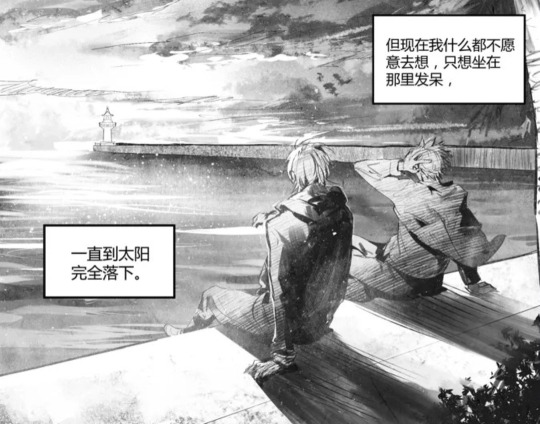
Source: Here
37. Notes in Rain Village: Pastoral Chapter 8
Then I saw a very magical place: there was a place far away in the starry sky, where the stars were very dense, and those stars were like waterfalls sliding down from the sky, rushing all the way to the clouds below the train.
"The stars are falling," I said to Men You Ping, sounding like a nonsensical child. "Falling, falling down."
38. Notes in Rain Village: Pastoral Chapter 33
When I was halfway up, even though I was wearing a raincoat, I was completely soaked and looked very miserable. I knew I would not give up, but I still felt a little desperate. As if I had sensed something, I suddenly stopped and looked back.
Men You Ping was standing behind me.
I didn't know when he came, but it was just like ten thousand times before.
39. Looking for the Dead in the Sea of Lights Chapter 24
As soon as I walked out of the circle of light from the bonfire, Men You Ping rushed out from the darkness on the other side of the camp, in the opposite direction from me. He jumped on his horse, leaped over the bonfire, rushed behind me, and lifted me onto the horse with one hand. Then, two men and one horse rushed towards Pangzi.
40. Queen Mother's Ghost Banquet Chapter 82
"I, I, I..." I tried to describe it, but I couldn't see clearly with my eyes squinting. I murmured, "I need Xiaoge. I really need him this time."
That's it. Obviously, it's not all of them, but I'm spent haha. People in the Chinese fandom often said that PingXie is a Chinese-style cp and pure love “纯���” type of ship, which I think it's indeed true. Their heartfelt moments are often hidden between allusions and metaphors, and the strong bond between them mostly relies on the emotional attachment rather than just physical touches or skinships. To me, it makes them so unique and interesting. What's more the taste of pure love that people often associate with this cp/ship is actually pretty rare itself. In the end, they did care for each other regardless of what people used to define their relationship (人*´∀`)。*+♡
𝐇𝐚𝐩𝐩𝐲 𝟖𝟏𝟕!ヾ(・ω・*)ノ
#pingxie#dmbj#daomu biji#817 rice festival#special 817#happy 817#盗墓笔记#瓶邪#pingxie only#瓶邪only#congratulatory post
55 notes
·
View notes
Text
Bad FSYY English translation
The four-volume Library of Chinese Classics bilingual edition of Creation/Investiture of the Gods (Fengshen yanyi, c. 1620) published in 2000 is the only full-length translation of the story available in English. I've had a PDF of the entire set archived on my external blog since May of 2020. It is serviceable for the general reader, but it is not great for hobbyist researchers like myself.
I'd like to provide an example showing how it is not very accurate and/or comprehensive. Chapter 12 describes how young Nezha inadvertently causes havoc in the underwater realm when washing himself in a river with a powerful magic sash. This eventually leads to Li Gen (李艮), a yaksha water-spirit soldier, to attack him with an ax. Gu Zhizhong's (2000) translation reads:
Nezha, naked and empty-handed, dodged the vicious blow, raised his Universal Ring and struck Li Gen on the head. How could the Yaksha withstand the magic weapon from Fairy Primordial! His skull broke open and he fell dead on the river bank (Gu, 2000, vol. 1, p. 239).
However, the full Chinese reads:
Standing there naked, Nezha dodged the advancing warrior's attack and upraised the Universal Ring in his right hand. This treasure was originally bestowed by the Jade Emptiness Palace of Mt. Kunlun to the Perfected Man of the Grand Monad to secure the items of his Golden Light Cave. How could the yaksha withstand the magic weapon as it struck downward on his head? His brains exploded from the blow, and he fell dead on the shore. 哪吒正赤身站立,見夜叉來得勇猛,將身躲過,把右手套的乾坤圈望空中一舉。此寶原係崑崙山玉虛宮所賜太乙真人鎮金光洞之物,夜叉那裏經得起,那寶打將下來,正落在夜叉頭上,只打的腦漿迸流,即死於岸上。 (I don't consider myself a translator, so please forgive any errors.)
You can see that quite a bit of information was left out. This happens throughout the entire novel. This makes me angrier the more that I think about. Why even bother to translate something if you are only going to paraphrase or even skip over passages? It seems like a pointless enterprise.
Source:
Gu, Z. (2000). Creation of the Gods (Vols. 1-4). Beijing: New World Press.

#Creation of the Gods#Investiture of the Gods#Fengshen yanyi#FSYY#English translation#bilingual#Nezha#Third Prince#Lotus Prince
70 notes
·
View notes
Video
youtube
❄️VMII - Vapormas Winter VGM Mix Vol.1❄️
0:00 Christmas NiGHTS - Intro 4:20 Christmas NiGHTS - Introduce Dream (Jingle) 5:30 Christmas NiGHTS - Winter Sleep 7:40 Bomberman 64 - White Glacier 11:30 Sonic 3D Blast - Diamond Dust Act 2 17:10 Napple Tale - Spring’s Petal 19:00 Paper Mario - Crystal Palace Crawl 21:10 Magic Knight Rayearth - Cavern of Eternal Ice 24:45 Tales of Vesperia - Thousand Year Slumber of Blastia 27:20 Secret of Mana - A Wish 29:15 Sonic Adventure - Limestone Cave 32:30 Paper Mario - Snow Road 36:00 Sonic 3D Blast - Diamond Dust Act 1 38:10 Tail Concerto - Coolant 44:00 Final Fantasy VII - Buried in the Snow 51:05 Jazz Jackrabbit 2 - A Cold Day In Heck 57:50 Paper Mario - Starborn Valley Trail 59:50 Phantasy Star Online 2 - White Summit Probe Naberius 1:13:40 Napple Tale - Snowball| 1:17:25 Phantasy Star Universe - Christmas 1:23:00 Final Fantasy X - People of the North Pole 1:29:30 Tales of Vesperia - Source of the Seething Silence 1:35:20 Skies of Arcadia - Ice Dungeon 1:41:00 Seiken Densetsu 3 - Another Winter 1:43:55 Phantom Brave - Snowberry| 1:49:05 Napple Tale - Skipper 1:54:00 Napple Tale - October Child 1:58:15 Mario Kart 64 - Frappe Snowland / Sherbet Land 2:02:00 Tomba 2 - Kujara Ranch 2:04:15 Pokémon D/P - Snowpoint City (Day) 2:07:00 NiGHTS Into Dreams - Take the Snow Train 2:19:20 Pokémon Mystery Dungeon: Rescue Team - Escape Through the Snow 2:22:45 Tales of Symphonia - A Snow Light (Flanoir) 2:26:00 Mega Man 8 - Frost Man Stage 2:29:20 Zelda: Ocarina of Time - Ice Cavern 2:32:30 Tales of Phantasia - Freeze 2:36:10 Super Monkey Ball - Arctic 2:41:45 Kirby’s Return to Dream Land - Snowball Scuffle 2:46:05 Christmas NiGHTS - New Year’s ‘9th’ 2:47:25 Shenmue - Silent Night, Holy Night 2:51:50 Croc - The Ice of Life 2:54:00 Mega Man X - Chill Penguin Stage 2:56:25 Advance Wars Duel Strike - Sasha’s Theme 3:01:15 Astal - The Crystal Palace 3:05:30 Shenmue - Sha Hua Christmas 3:12:25 Yoshi’s Wooly World - Frozen Solid & Chilled 3:17:00 Christmas NiGHTS - Dreams Dreams (Nightopian Ver.) 3:20:00 Christmas NiGHTS - Ending 3:23:10 Magic Knight Rayearth - The Sparkling Ice of Rosen 3:25:15 Yume Nikki - Snow World
#annual christmas present to you all til i make a new winter VGM mix#so maybe next year#winter music#winter vibes#VGM#VGM mix#chill#cold#chilly#frozen#atmospheric VGM#relaxing VGM#my mixes#VMII#vaporwave#vaporambient#ambient#ambient music#christmas music#christmas#winter
40 notes
·
View notes
Text
Additional Readings on it all, both popular and academic - An ‘Ism’ Overview - Perspectives Comparing And contrasting art movements
Prehistoric Art:
Palaeolithic Art (40,000 BCE - 10,000 BCE)
Clottes, Jean. Chauvet Cave: The Art of Earliest Times. University of Utah Press, 2003.
Guthrie, Dale. The Nature of Paleolithic Art. University of Chicago Press, 2005.
Vanhaeren, Marian, et al. "Middle Paleolithic shell beads in Israel and Algeria." Science, vol. 312, no. 5781, 2006, pp. 1785-1788.
Marshack, Alexander. "Upper Paleolithic notation and symbol: a provisional framework." Man, vol. 16, no. 1, 1981, pp. 95-122.
Neolithic Art (10,000 BCE - 2,000 BCE)
Renfrew, Colin, and Paul G. Bahn. Archaeology: Theories, Methods and Practice. 7th ed. London: Thames & Hudson, 2016.
Hodder, Ian. The Leopard's Tale: Revealing the Mysteries of Catalhoyuk. New York: Thames & Hudson, 2006.
Whittle, Alasdair, and Vicki Cummings. "Going over: People and things in the early Neolithic." Proceedings of the British Academy 144 (2007): 33-58.
Soffer, Olga. "The Upper Paleolithic and the Neolithic in the Russian Plain: Problems of Continuity and Discontinuity." Journal of World Prehistory 4, no. 4 (1990): 377-426.
Ancient Art:
Egyptian Art (3100 BCE - 30 BCE)
Wilkinson, Richard H. The Complete Gods and Goddesses of Ancient Egypt. Thames & Hudson, 2003.
Robins, Gay. The Art of Ancient Egypt. Harvard University Press, 2008.
Freed, Rita E. “The Representation of Women in Egyptian Art.” The Journal of Egyptian Archaeology, vol. 81, 1995, pp. 67-86.
Redford, Donald B. “The Heretic King and the Concept of the ‘Golden Age’ in Ancient Egypt.” Journal of Near Eastern Studies, vol. 33, no. 4, 1974, pp. 365-371.
Greek Art (800 BCE - 146 BCE)
Boardman, John. The Oxford History of Greek Art. Oxford University Press, 2001.
Pollitt, J. J. Art and Experience in Classical Greece. Cambridge University Press, 1972.
Neer, Richard T. "The Emergence of the Classical Style in Greek Sculpture." American Journal of Archaeology, vol. 105, no. 2, 2001, pp. 255-280.
Osborne, Robin. "Greek Art in the Archaic Period." The Journal of Hellenic Studies, vol. 115, 1995, pp. 118-131.
Roman Art (509 BCE - 476 CE)
Beard, Mary. SPQR: A History of Ancient Rome. New York: Liveright Publishing Corporation, 2015.
Brilliant, Richard. Roman Art. New York: Thames & Hudson, 2012.
Kleiner, Diana E. E. "Roman Sculpture." Oxford Art Journal 26, no. 1 (2003): 49-63.
Stewart, Peter. "The Social History of Roman Art." Cambridge Archaeological Journal 7, no. 1 (1997): 83-96.
Medieval Art:
Early Christian Art (200 CE - 500 CE)
Robin Margaret Jensen, Understanding Early Christian Art (New York: Routledge, 2000).
William Tronzo, The Oxford Handbook of Early Christian Art (New York: Oxford University Press, 2014)
Herbert Kessler, "The Spiritual Matrix of Early Christian Art," Representations, no. 11 (1985): 96-119, doi:10.2307/2928505.
Jas' Elsner, "What Do We Want Early Christian Art to Be?" Religion Compass 2, no. 6 (2008): 1118-1138, doi:10.1111/j.1749-8171.2008.00091.x.
Byzantine Art (330 CE - 1453 CE)
Cormack, Robin. Byzantine Art. Oxford: Oxford University Press, 2000.
Mango, Cyril. The Art of the Byzantine Empire, 312-1453: Sources and Documents. Englewood Cliffs, NJ: Prentice-Hall, 1972.
Mango, Cyril. "Byzantine Architecture." The Grove Dictionary of Art Online. Oxford Art Online. Oxford University Press, accessed March 19, 2023. https://www.oxfordartonline.com/groveart/view/10.1093/gao/9781884446054.001.0001/oao-9781884446054-e-7000002606.
Evans, Helen C. "Byzantium and the West: The Reception of Byzantine Artistic Culture in Medieval Europe." The Metropolitan Museum of Art Bulletin, vol. 58, no. 4 (Spring, 2001): 3-44. JSTOR, https://www.jstor.org/stable/3269056.
Islamic Art (7th century CE - present)
Grabar, Oleg. Islamic Art and Literature. Princeton, NJ: Princeton University Press, 1984.
Bloom, Jonathan M. and Sheila S. Blair. Islamic Arts. London: Phaidon Press, 1997.
Blair, Sheila S. "The Mosque and Its Early Development." Muqarnas 10 (1993): 1-19.
Carboni, Stefano. "The Arts of Islam." The Metropolitan Museum of Art Bulletin, vol. 58, no. 4, 2001, pp. 5-6, 17-65.
Romanesque Art (11th century - 12th century)
Conrad Rudolph, "Artistic Change at St-Denis: Abbot Suger's Program and the Early Twelfth-Century Controversy over Art," (Princeton, NJ: Princeton University Press, 1990).
George Henderson, "Early Medieval Art: Carolingian, Ottonian, Romanesque," (London: Thames & Hudson, 1972).
C. R. Dodwell, "The Dream of Charlemagne," The Burlington Magazine 118, no. 875 (1976): 330-341.
Gerardo Boto Varela, "The Iconography of the Lamb and the Role of the Temple in the Creation of the Romanesque Architectural Sculpture in the Kingdom of León," Gesta 43, no. 2 (2004): 171-186.
Gothic Art (12th century - 15th century)
Camille, Michael. Gothic Art: Glorious Visions. New York: Harry N. Abrams, 1996.
Conrad Rudolph. Artistic Change at St-Denis: Abbot Suger's Program and the Early Twelfth-Century Controversy over Art. Princeton, NJ: Princeton University Press, 1990.
Kemp, Simon. "The Uses of Antiquity in Gothic Revival Architecture." The Art Bulletin 73, no. 3 (1991): 405-421.
Snyder, James. "Gothic Sculpture in America: The Late 19th Century." The Journal of the Society of Architectural Historians 34, no. 4 (1975): 286-304.
Renaissance and Baroque Art:
Renaissance Art (14th century - 17th century)
Gardner, Helen, et al. Gardner's Art Through the Ages: A Global History. 16th ed., Cengage Learning, 2019.
Greenblatt, Stephen. Renaissance Self-Fashioning: From More to Shakespeare. University of Chicago Press, 1980.
Baxandall, Michael. "The Period Eye." Renaissance Studies, vol. 1, no. 1, 1987, pp. 3-20. JSTOR, www.jstor.org/stable/24409669.
Freedberg, David. "Painting and the Counter Reformation." Journal of the Warburg and Courtauld Institutes, vol. 32, 1969, pp. 244-262. JSTOR, www.jstor.org/stable/750844.
Mannerism (1520 - 1580)
Freedberg, S. J. (1993). Painting in Italy, 1500-1600. Yale University Press.
Shearman, J. (1967). Mannerism. Penguin Books.
Cole, B. (1990). Virtue and magnificence: Leonardo's portrait of Beatrice d'Este. Artibus et historiae, 11(21), 39-58.
Baxandall, M. (1965). "Il concetto del ritmo" in Michelangelo's Entombment. Journal of the Warburg and Courtauld Institutes, 28, 9-29.
Baroque Art (1600 - 1750)
Gombrich, E. H. The Story of Art. 16th ed. Phaidon Press, 1995.
Harris, Ann Sutherland. Seventeenth-Century Art and Architecture. 2nd ed. Laurence King Publishing, 2005.
Haskell, Francis. "The Judgment of Solomon: Poussin's 'The Sacrament of Ordination' and the Critics." The Burlington Magazine, vol. 124, no. 948, 1982, pp. 275-284.
Brown, Jonathan. "The Golden Age of Dutch Art: Painting, Sculpture, Decorative Art." The Metropolitan Museum of Art Bulletin, vol. 64, no. 4, 2007, pp. 36-44.
Rococo (1715 - 1774)
Gauvin Alexander Bailey, The Spiritual Rococo: Décor and Divinity from the Salons of Paris to the Missions of Patagonia, (New York: Cambridge University Press, 2014).
Alastair Laing, ed., Rococo: Art and Design in Hogarth's England, exh. cat. (London: Victoria and Albert Museum, 1984).
Alina Payne, "Fragile Alliances: Rococo and the Enlightenment," Art Bulletin 85, no. 3 (2003): 540-564.
Melissa Lee Hyde, "Fashioning the Bourgeoisie: A History of Clothing in the Nineteenth Century," Journal of Design History 21, no. 3 (2008): 219-23
19th Century Art:
Neoclassicism (1750 - 1850)
Wölfflin, Heinrich. Principles of Art History. Translated by M. D. Hottinger, Dover Publications, 1932.
Rosenblum, Robert. Transformations in Late Eighteenth Century Art. Princeton University Press, 1967.
Praz, Mario. "The Eighteenth-Century Elegiac Mood: Some Clarifications and Distinctions." Eighteenth-Century Studies, vol. 2, no. 3, 1969, pp. 295-318.
Honour, Hugh. "The Ideal of the Classic in the Visual Arts." Journal of the Warburg and Courtauld Institutes, vol. 22, no. 1/2, 1959, pp. 1-25.
Romanticism (1800 - 1850)
Abrams, M. H. The Mirror and the Lamp: Romantic Theory and the Critical Tradition. Oxford University Press, 1971.
Bloom, Harold. The Anxiety of Influence: A Theory of Poetry. Oxford University Press, 1973.
Frye, Northrop. "Towards Defining an Age of Sensibility." Studies in Romanticism, vol. 1, no. 1, 1962, pp. 1-14.
Mellor, Anne K. "Possessed by Love: The Female Gothic and the Romance Plot." PMLA, vol. 102, no. 2, 1987, pp. 134-150.
Realism (1830 - 1870)
Mearsheimer, John J. The Tragedy of Great Power Politics. New York: W.W. Norton, 2001.
Walt, Stephen M. The Origins of Alliances. Ithaca: Cornell University Press, 1987.
Waltz, Kenneth N. "The Theory of International Politics." International Security 15, no. 1 (Summer 1990): 5-17.
Morgenthau, Hans J. "Politics Among Nations: The Struggle for Power and Peace." Foreign Affairs 28, no. 4 (July 1950): 566-583.
Impressionism (1860 - 1900)
Herbert, Robert L. Impressionism: Art, Leisure, and Parisian Society. New Haven: Yale University Press, 1988.
Moffett, Charles S. Impressionist and Post-Impressionist Paintings in the Metropolitan Museum of Art. New York: Metropolitan Museum of Art, 1985.
Smith, Paul. "Monet's Impressionism: Aesthetic and Ideological Dilemmas." The Art Bulletin 68, no. 4 (1986): 595-615.
Dumas, Ann, and Anne Distel. "Monet at Vetheuil: The Turning Point." The Burlington Magazine 124, no. 953 (1982): 350-58.
Post-Impressionism (1886 - 1905)
Paul Smith, ed., "Post-Impressionism" (New York: Rizzoli International Publications, 1988).
Richard R. Brettell, "Post-Impressionists" (Chicago: University of Chicago Press, 1987).
John House, "Post-Impressionism: Origins and Practice" in "Oxford Art Journal" vol. 6, no. 2 (1983): 3-16.
Patricia Mainardi, "The End of Post-Impressionism" in "Art Journal" vol. 43, no. 4 (1983): 308-313.
20th Century Art:
Fauvism (1900 - 1910)
Elderfield, John. Fauvism. New York: Museum of Modern Art, 1976.
Shanes, Eric. The Fauves: The Reign of Color. New York: Harry N. Abrams, 1995.
Hargrove, June. "Matisse, Fauvism, and the Rediscovery of Pure Color." The Art Bulletin 63, no. 4 (1981): 689-704.
Rewald, John. "The Fauve Landscape." Gazette des Beaux-Arts 79, no. 6 (1972): 287-304.
Cubism (1907 - 1914)
Cooper, Douglas. The Cubist Epoch. Phaidon Press, 1970.
Green, Christopher. Cubism and its Enemies: Modern Movements and Reaction in French Art, 1916-1928. Yale University Press, 1987.
Shiff, Richard. "Cézanne and the End of Impressionism: A Study of the Theory, Technique, and Critical Evaluation of Modern Art." The Art Bulletin, vol. 58, no. 4, 1976, pp. 529-555.
Barr, Alfred H. "Cubism and Abstract Art." The Museum of Modern Art Bulletin, vol. 1, no. 3, 1934, pp. 6-7.
Futurism (1909 - 1916)
Marinetti, Filippo Tommaso. Futurist Manifestos. Edited by Umbro Apollonio, translated by Robert Brain and Others, Thames and Hudson, 1973.
Leighten, Patricia. Futurism: An Anthology. Yale University Press, 2019.
Perloff, Marjorie. "Futurism's 'Futuricity'." Modernism/modernity, vol. 19, no. 2, 2012, pp. 247-263.
Santoro, Marco. "The Politics of Speed: Futurism and Fascism." The Journal of Modern History, vol. 87, no. 4, 2015, pp. 821-856.
Dadaism (1916 - 1924)
Hulsenbeck, Richard. Dada Almanach. Berlin: Erich Reiss, 1920.
Gale, Matthew. Dada & Surrealism. London: Phaidon, 1997.
Naumann, Francis M. "Dada and the Concept of Art." The Art Bulletin 69, no. 4 (1987): 634-651. https://www.jstor.org/stable/3051041.
Dadoun, Roger. "The Dada Effect: An Anti-Aesthetic and its Influence." October 66 (1993): 3-16. https://www.jstor.org/stable/778760.
Surrealism (1920 - 1940)
Breton, André. Manifestoes of Surrealism. Translated by Richard Seaver and Helen R. Lane. Ann Arbor: University of Michigan Press, 1972.
Ades, Dawn. Dada and Surrealism Reviewed. London: Arts Council of Great Britain, 1978.
Martin, Alyce Mahon. "Surrealism and the Spanish Civil War." Oxford Art Journal 20, no. 2 (1997): 77-89.
Weisberg, Gabriel P. "Surrealism in America: The Beginning." Art Journal 28, no. 3 (1969): 222-29.
Abstract Expressionism (1940 - 1960)
Greenberg, Clement. Art and Culture: Critical Essays. Boston: Beacon Press, 1961.
Rosenberg, Harold. The Tradition of the New. New York: Horizon Press, 1959.
Alloway, Lawrence. "Networks, Names and Numbers." Artforum 1, no. 2 (1962): 29-33.
Hess, Thomas B. "Abstract Expressionism." Art News 51, no. 9 (1952): 22-23, 45-46, 48-49.
Pop Art (1950s - 1960s)
Foster, Hal. The First Pop Age: Painting and Subjectivity in the Art of Hamilton, Lichtenstein, Warhol, Richter, and Ruscha. Princeton University Press, 2012.
Livingstone, Marco, ed. Pop Art: A Continuing History. Thames & Hudson, 2013.
Alloway, Lawrence. “The Arts and the Mass Media.” Architectural Design and the Arts and Crafts Movement, vol. 31, no. 9, 1961, pp. 346–349. JSTOR, www.jstor.org/stable/4228719.
Lippard, Lucy R. “Pop Art.” Art International, vol. 12, no. 8, 1968, pp. 24–31. JSTOR, www.jstor.org/stable/24889088.
Minimalism (1960s - 1970s)
Judd, Donald. Complete Writings, 1959-1975. New York: The Press of the Nova Scotia College of Art and Design, 1975.
Fried, Michael. Art and Objecthood: Essays and Reviews. Chicago: University of Chicago Press, 1998.
Lippard, Lucy. "Eccentric Abstraction." Art International, vol. 12, no. 2, 1968, pp. 24-27.
Krauss, Rosalind. "Sculpture in the Expanded Field." October, vol. 8, 1979, pp. 30-44.
Conceptual Art (1960s - 1970s)
Kosuth, Joseph. Art after Philosophy and After: Collected Writings, 1966-1990. Cambridge, MA: MIT Press, 1991.
Lippard, Lucy R. Six Years: The Dematerialization of the Art Object from 1966 to 1972. Berkeley: University of California Press, 1997.
Buchloh, Benjamin H.D. “Conceptual Art 1962–1969: From the Aesthetic of Administration to the Critique of Institutions.” October 55 (Winter 1990): 105-143.
Graham, Dan. “The End of Liberalism.” In Dan Graham: Rock My Religion. Edited by Brian Wallis, 31-59. Cambridge, MA: MIT Press, 1993.
Performance Art (1970s - present)
Abramovic, Marina. The Artist Is Present: Essays. New York: Museum of Modern Art, 2010.
Phelan, Peggy. Unmarked: The Politics of Performance. New York: Routledge, 1993.
Goldberg, RoseLee. "Performance Art: From Futurism to the Present." October 56 (1991): 78-89.
Jones, Amelia. "Presence in Absentia: Experiencing Performance as Documentation." Art Journal 56, no. 4 (1997): 11-18.
Postmodernism (1970s - present)
Jameson, Fredric. Postmodernism, or, the Cultural Logic of Late Capitalism. Durham: Duke University Press, 1991.
Lyotard, Jean-Francois. The Postmodern Condition: A Report on Knowledge. Minneapolis: University of Minnesota Press, 1984.
Butler, Judith. "Contingent Foundations: Feminism and the Question of ‘Postmodernism’." The Journal of Philosophy, vol. 86, no. 10, 1989, pp. 571- 577.
Harvey, David. "The Condition of Postmodernity: An Enquiry into the Origins of Cultural Change." Blackwell Publishers Ltd, 1990.
Digital Art (1980s - present)
Lev Manovich, The Language of New Media, (Cambridge, MA: MIT Press, 2001).
Christiane Paul, Digital Art, (New York: Thames & Hudson, 2008).
Sarah Cook and Beryl Graham, "From Periphery to Centre: Locating the Technological in Art History," Art History 28, no. 4 (September 2005): 514-536, https://doi.org/10.1111/j.1467-8365.2005.00442.x.
Oliver Grau, "The Complexities of Digital Art," in MediaArtHistories, ed. Oliver Grau (Cambridge, MA: MIT Press, 2007), 45-67.
Street Art (1980s - present)
Chaffee, Lyman, and Chris Stain. Walls of Heritage, Walls of Pride: African American Murals. Jackson: University Press of Mississippi, 2011.
Harrington, Steven. Street Art San Francisco: Mission Muralismo. San Francisco: Chronicle Books, 2009.
Schacter, Rafael. "The World Atlas of Street Art and Graffiti." The Journal of Aesthetics and Art Criticism 73, no. 4 (2015): 385-387.
Riccini, Raffaele. "Street Art as a New Form of Urban Governance: A Comparative Perspective." Urban Affairs Review 52, no. 5 (2016): 723-746.
Contemporary Art:
Neo-Expressionism (1980s - 1990s)
Storr, Robert. 1986. "Dislocations: Themes and Meanings in Post-World War II Art." New York: Museum of Modern Art.
Harrison, Charles, and Paul Wood. 1991. "Art in Theory 1900-1990: An Anthology of Changing Ideas." Oxford: Blackwell Publishers.
Bois, Yve-Alain. 1986. "Painting: The Task of Mourning." October 37 (Summer): 15-63.
Krauss, Rosalind E. 1985. "The Originality of the Avant-Garde and Other Modernist Myths." Cambridge, Mass: MIT Press.
Installation Art (1990s - present)
Bishop, Claire. Installation Art: A Critical History. New York: Routledge, 2005.
O'Doherty, Brian. Inside the White Cube: The Ideology of the Gallery Space. 2nd ed. Chicago: University of Chicago Press, 1999.
Schneider, Rebecca. "The Explicit Body in Performance." TDR: The Drama Review 46, no. 2 (2002): 74-91. doi:10.1162/105420402320980586.
Bishop, Claire. "Antagonism and Relational Aesthetics." October 110 (2004): 51-79. doi:10.1162/0162287042379787.
Relational Aesthetics (1990s - present)
Bourriaud, Nicolas. Relational Aesthetics. Dijon: Les presses du réel, 1998.
Bishop, Claire. Artificial Hells: Participatory Art and the Politics of Spectatorship. London: Verso, 2012.
O'Doherty, Brian. "Inside the White Cube." Artforum 5, no. 1 (1967): 12-16.
Bishop, Claire. "Antagonism and Relational Aesthetics." October 110 (2004): 51-79.
New Media Art (1990s - present)
Manovich, Lev. The Language of New Media. Cambridge, MA: MIT Press, 2001.
Paul, Christiane. Digital Art. London: Thames & Hudson, 2003.
Gere, Charlie. "Digital Culture." In The Oxford Handbook of New Audiovisual Aesthetics, edited by John Richardson, Claudia Gorbman, and Carol Vernallis, 491-506. New York: Oxford University Press, 2013.
Drucker, Johanna. "The Century of Artists' Books." Art Journal 56, no. 3 (1997): 20-34.
Superflat (1990s - present)
Murakami, Takashi. Superflat. New York: MADRA Publishing, 2000.
Schimmel, Paul. Color and Form: The Geometric Sculptures of Donald Judd. Los Angeles: Museum of Contemporary Art, 1991.
Krajewski, Sara. "Superflat and the Politics of Postmodernism." Postmodern Culture 14, no. 3 (2004): 1-18. doi:10.1353/pmc.2004.0046.
Nakamura, Lisa. "Cuteness as Japan's Millennial Aesthetic." Journal of Aesthetics and Art Criticism 65, no. 2 (2007): 137-147. doi:10.1111/j.1540-6245.2007.00207.x.
Post-Internet Art (2000s - present)
Hito Steyerl, The Wretched of the Screen (Berlin: Sternberg Press, 2012).
Karen Archey and Robin Peckham (eds.), Art Post-Internet: INFORMATION/DATA (Berlin: Sternberg Press, 2014).
Gene McHugh, "Post-Internet: Art After the Internet," Artforum International 52, no. 1 (2013): 366-71.
Nora N. Khan and Steven Warwick, "Fear Indexing the X-Files," e-flux Journal 56 (2014): 1-9.
Afrofuturism (2000s - present)
Sheree R. Thomas, ed., "Dark Matter: A Century of Speculative Fiction from the African Diaspora" (New York: Aspect/Warner Books, 2000).
Ytasha L. Womack, "Afrofuturism: The World of Black Sci-Fi and Fantasy Culture" (Chicago: Lawrence Hill Books, 2013).
Nettrice R. Gaskins, "Afrofuturism and Post-Soul Possibility in Black Aesthetics," "Journal of Black Studies" 40, no. 4 (2010): 699-710.
Reynaldo Anderson and Charles E. Jones, "Introduction: The Rise of the Afrofuturist," "Black Magnolias Journal" 5, no. 2 (2018): 1-11.
Socially Engaged Art (2000s - present)
Bishop, Claire. Artificial Hells: Participatory Art and the Politics of Spectatorship. London: Verso, 2012.
Kester, Grant. Conversation Pieces: Community and Communication in Modern Art. Berkeley: University of California Press, 2004.
Kester, Grant. "Dialogical Aesthetics: A Critical Framework for Littoral Art." in Theory in Contemporary Art since 1985. Ed. by Simon Leung. Oxford: Blackwell, 2005.
Thompson, Nato. "Living as Form: Socially Engaged Art from 1991-2011." Art Journal, Vol. 71, No. 1, 2012, pp. 101-102.
Environmental Art (2000s - present)
Schama, Simon. Landscape and Memory. New York: Alfred A. Knopf, 1995.
Kastner, Jeffrey, and Brian Wallis, eds. Land and Environmental Art. London: Phaidon, 1998.
Kagan, Sacha. "The Nature of Environmental Art." The Journal of Aesthetics and Art Criticism 51, no. 3 (1993): 455-67.
White, Edward. "Earthworks and Beyond." Art Journal 39, no. 4 (1980): 326-32.
NFT Art (2010s - present)
Belamy, Christies. (2018). Portrait of Edmond de Belamy. Paris: Obvious Art.
Harrison, P., & Weng, S. (2021). The NFT Bible: Everything you need to know about non-fungible tokens. United States: Independently published.
Liu, Z., Wang, J., & Lin, L. (2021). From NFT to NFA: The Implications of Blockchain for Contemporary Art. Journal of Cultural Economics, 45(2), 245-264. doi: 10.1007/s10824-021-09421-6
Schellekens, M., & Zuidervaart, H. (2022). On the Importance of Being Unique: An Analysis of Non-Fungible Tokens as a Medium for Digital Art. Leonardo, 55(1), 56-63. doi: 10.1162/leon_a_02179
3 notes
·
View notes
Text
Todays rip: 21/12/2023
Lifelike Waterway
Season 4 Episode 1 Featured on: FIRST STRIKE ~ SiIvaGunner: King for Another Day Tournament Original Soundtrack VOL. 1
Ripped by l4ureleye
youtube
Every since the year the King for Another Day tournament came to a close, the Christmas season has always brought back memories of it. It was such a huge event, and only really happened to land around the Christmas season due to delays in production, yet it all felt so befitting - the kind of comforting, communal feel of the holidays just fit a tournament of this ilk so well. And while yesterday, with 11 Minutes of City Pop, I wrote about the tournament's beloved silver medalist, today we're going lower down in the ranks - to a combatant many thought went out before he could've shown his true potential.
To say that Cave Story means a lot to me would be an understatement - I alluded to it earlier this month with Whip Fortress, but its a game whose aesthetics and music have stuck with me and thousands of people all over the world for so many years. We all knew Quote would have bangers in the tournament, yet by the time he was up to bat, he'd barely had any arrangements up on the channel to truly show his stuff. That's not to mention the fact that his source list even included other early-2000s indie games, yet...before that could be taken advantage of, the voting was settled and he was out for the count. When his catalogue of arrangements started to finally be rolled out, there was an era of...sorrow, in their comment sections. And Lifelike Waterway was no exception to that - to me back then, it was the moment that it truly sunk in that Quote was down and out.
The dour circumstances of the rip were not something that the team could've ever planned around - the arrangements were obviously made far in advance before the voting actually happened. Yet as also happened with Geno and DEARLY BELOVED..., his loss added a magical form of ambience to the music, a secret spice to turn a chill arrangement into a full-on tribute in his memory. I've talked at length about l4ureleye's ripping prowess on the blog before with rips like Hopes and Divinity+ and SICKO TALE - she has an unparalleled ability to create entire worlds and galaxies in your mind, out of nothing but her sound. From the mashups to the remixes, she's uncontested in the art of lo-fi, music that sounds relaxing yet simultaneously gives off the feeling of venturing into an endlessly-deep cavern. With KFAD, she was able to flex her powers to absurd levels, and if you've been listening along you may already know what I mean.
The original Lifelike Waterway already marked one of the most intense emotional points of Cave Story, yet Lifelike Waterway is able to spin that melody, that soothing yet haunting tune into something else entirely. Its far from a faithful arrangement, yet the new atmosphere it creates is just so...gripping. Its hard to put into words the emotions it makes me feel, yet its palpably a blend of the feelings I still have from Cave Story, and the feelings from Quote's fallout in the tournament - yet, the arrangement doesn't fill me with sadness, either. Its more like...the feeling of taking long, deep breaths. The feeling that everything's going to be okay.
...Look, it's difficult to find many specifics to comment on with an arrangement that's as thorough and all-encompassing as this. All of this is really just to say, that Quote's part played in the tournament really highlighted just how emotionally attached many of us have become to this silly little music project, how SiIvaGunner has brought new emotional meaning to characters they didn't even create - and, most of all, that l4ureleye is a genius.
#todays siivagunner#season 4 episode 1#siivagunner#siiva#l4ureleye#cave story#quote cave story#curly brace#indie games#indie#metroidvania#indie game music#cave story music#nicalis#king for another day tournament#kfad#kfad2#siivagunner kfad#Youtube#Bandcamp
9 notes
·
View notes
Text
WORKS CITED:
Chocolate in the Underworld Space of Death: Cacao Seeds from an Early Classic Mortuary Cave (Keith M. Prufer and William Jeffrey Hurst) Chocolate: Cultivation and Culture in pre-Hispanic Mexico Author(s): Margarita de Orellana, Richard Moszka, Timothy Adès, Valentine Tibère, J.M. Hoppan, Philippe Nondedeo, Nezahualcóyotl, Nikita Harwich, Nisao Ogata, Quentin Pope, Fray Toribio de Benavente, Motolinía, Guadalupe M. Santamaría and Daniel Schechter Source: Artes de México, No. 103, CHOCOLATE: CULTIVO Y CULTURA DEL MÉXICO ANTIGUO (SEPTIEMBRE 2011), pp. 65-80 The Power of Chocolate Author(s): Blake Edgar Source: Archaeology, Vol. 63, No. 6 (November/December 2010), pp. 20-25 Published by: Archaeological Institute of America Tasting Empire: Chocolate and the European Internalization of Mesoamerican Aesthetics by MARCY NORTON CHOCOLATE II: Mysticism and Cultural Blends Author(s): Margarita de Orellana, Quentin Pope, Sonia Corcuera Mancera, José Luis Trueba Lara, Jana Schroeder, Laura Esquivel, Jill Derais, Mario Humberto Ruz, Clara Marín, Miguel León-Portilla, Michelle Suderman, Marta Turok, Mario M. Aliphat Fernández, Laura Caso Barrera, Sophie D. Coe, Michael D. Coe and Pedro Pitarch Source: Artes de México, No. 105, CHOCOLATE II: Mística y Mestizaje (marzo 2012), pp. 73- 96 The Introduction of Chocolate into England: Retailers, Researchers, and Consumers, 1640- 1730 Author(s): Kate Loveman Source: Journal of Social History, Vol. 47, No. 1 (Fall 2013), pp. 27-46 Published by: Oxford University Press Stable URL: https://www.jstor.org/stable/43306044 Encomienda, African Slavery, and Agriculture in Seventeenth-Century Caracas Author(s): Robert J. Ferry Source: The Hispanic American Historical Review, Vol. 61, No. 4 (Nov., 1981), pp. 609-635 Published by: Duke University Press Stable URL: https://www.jstor.org/stable/2514606 Accessed: 12-07-2019 16:34 UTC The Cacao Economy of the Eighteenth-Century Province of Caracas and the Spanish Cacao Market Author(s): Eugenio Pinero Source: The Hispanic American Historical Review, Vol. 68, No. 1 (Feb., 1988), pp. 75-100 Published by: Duke University Press Stable URL: https://www.jstor.org/stable/2516221 Accessed: 12-07-2019 17:03 UTC Establishing Cacao Plantation Culture in the Western World - Timothy Walker The Ghirardelli Story Author(s): Sidney Lawrence Source: California History, Vol. 81, No. 2 (2002), pp. 90-115 Published by: University of California Press in association with the California Historical Society Stable URL: https://www.jstor.org/stable/25177676 The Evolution of Chocolate Manufacturing Rodney Snyder, Bradley Foliart Olsen, and Laura Pallas Brindle The Emperors of Chocolate - Inside the Secret World of Hershey and Mars by Joel Glenn Brenner (Random House, 1998) Bitter Chocolate by Carol Off (The New Press, 2006) "Cocoa's child labrorers", Whoriskey, Peter; Siegel, Rachel, The Washington Post, June 10 2019 The Harkin-Engel Protocol (Chocolate Manufacturers' Association, 2001) "Role of Trade Cards in Marketing Chocolate during the Late 19th Century", Virginia Westbrook "Chocolate at the World's Fairs, 1851-1964", Nicholas Westbrook Edible Ideologies by Kathleen LeBesco (SUNY 2008) Cosmopolitan cocoa farmers: refashioning Africa in Divine Chocolate advertisements Author(s): Kristy Leissle Source: Journal of African Cultural Studies, Vol. 24, No. 2 (December 2012), pp. 121-139 Published by: Taylor & Francis, Ltd. Stable URL: https://www.jstor.org/stable/42005280 Chocolate Nations: Living and Dying for Cocoa in West Africa by Orla Ryan (Zed Books, 2011) Cocoa by Kristy Leissle (Polity, 2018) How Mars Inc., maker of M&Ms, vowed to make its chocolate green. And failed. Mufson, Steven . The Washington Post (Online) , Washington, D.C.: WP Company LLC d/b/a The Washington Post. Oct 29, 2019.
0 notes
Note
I'd like to add that a lot of readers (myself included at one point) forget that Sun Wukong is bald because he took the tonsure as a Buddhist monk. This feature is mentioned several times in the novel.
Ch. 20
An old man asks Monkey, “[W]hy did you shave your hair to become a monk?” (Wu & Yu, 2012, vol. 1, p. 395).
Ch. 27
Sun Wukong laments:
But ever since Nirvana delivered me from my sins, when with my hair shorn I took the vow of complete poverty and followed you [Tripitaka] as your disciple, I had this gold fillet clamped on my head… (Wu & Yu, 2012, vol. 2, p. 24). 自從涅槃罪度,削髮秉正沙門,跟你做了徒弟,把這個金箍兒勒在我頭上…
Ch. 34
The fiend then gave the rope a tug and pulled Pilgrim down before he gave that bald head seven or eight blows with the sword. The skin on Pilgrim’s head did not even redden at all (Wu & Yu, 2012, vol. 2, p. 128). 那怪將繩一扯,扯將下來,照光頭上砍了七八寶劍。行者頭皮兒也不曾紅了一紅。
Ch. 75
A conversation between Monkey and a demon reads:
“You come over here,” said the old demon, “and act as my chopping block first. If your bald head can withstand three blows of my scimitar, I’ll let you and your Tang Monk go past. But if you can’t, you’d better tum him over quickly to me as a meal.” When he heard this, Pilgrim smiled and said, “Fiend! If you have brush and paper in your cave, take them out and I’ll sign a contract with you. You can start delivering your blows from today until next year, and I won’t regard you seriously!” Arousing his spirit, the old demon stood firmly with one foot placed in front of the other. He lifted up his scimitar with both hands and brought it down hard on the head of the Great Sage. Our Great Sage, however, jerked his head upward to meet the blow. All they heard was a loud crack, but the skin on the head did not even redden (Wu & Yu, 2012, vol. 3, p. 373). 老魔道:「你過來,先與我做個樁兒,讓我盡力氣著光頭砍上三刀,就讓你唐僧過去;假若禁不得,快送你唐僧來,與我做一頓下飯。」行者聞言笑道:「妖怪,你洞裡若有紙筆,取出來,與你立個合同。自今日起,就砍到明年,我也不與你當真。」 那老魔抖擻威風,丁字步站定,雙手舉刀,望大聖劈頂就砍。這大聖把頭往上一迎,只聞扢扠一聲響,頭皮兒紅也不紅。
Source:
Wu, C., & Yu, A. C. (2012). The Journey to the West (Vols. 1-4) (Rev. ed.). Chicago, Illinois: University of Chicago Press.
Ok, so Tang Sanzang was a monk, so all of his pilgrims, Zhu Bajie, Sha Wujing, Ao Lie and Wukong would be monks too? also Wukong was a monk at the final?
Well, I think you might got that a bit backward.
Wukong was a monk at the start of the journey when he became a Buddhist disciple. They are pilgrims, which is just another way of saying they are monks. Wukong says multiple times how is a monk within the novel and how he has taken his vows, he is the most serious about his vows from how he learns scriptures and wishes to learn the ripe fruit. Wukong was a monk for all 14 years, the same as Bajie, same as Wujing. The only one that could be argued that isn't a disciple is Bailong because he never got a Buddhist name. He is just called Bai Long Ma.
Wukong was a monk the entire time and in the end, he is a Buddha, the same as Sanzang who also became a Buddha. Bajie because a janitor of the altar in Western heaven and Wujing becomes an arhat. Bai Long Ma became a golden dragon of Western Heaven as well so they all in the end proud buddhist monks.



Wukong is a very proud monk since the start.
60 notes
·
View notes
Text



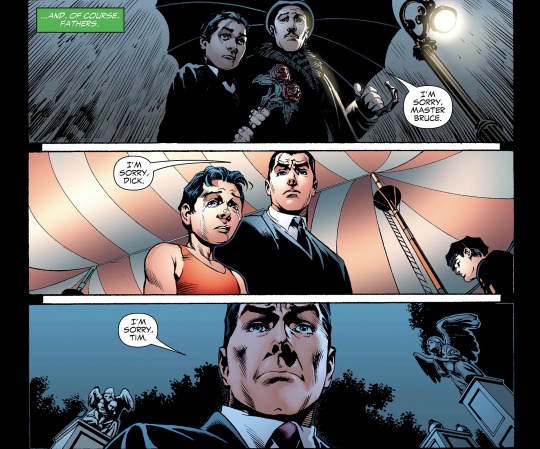

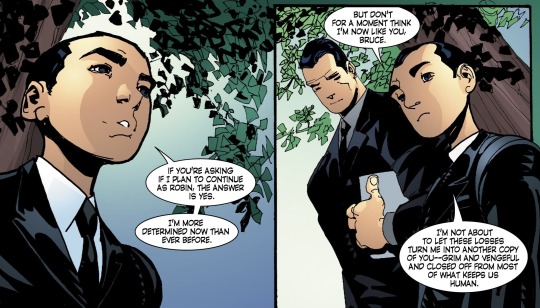
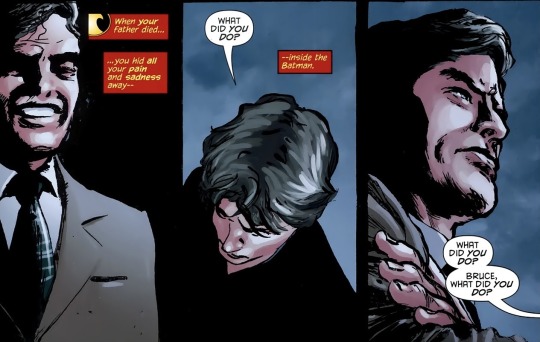
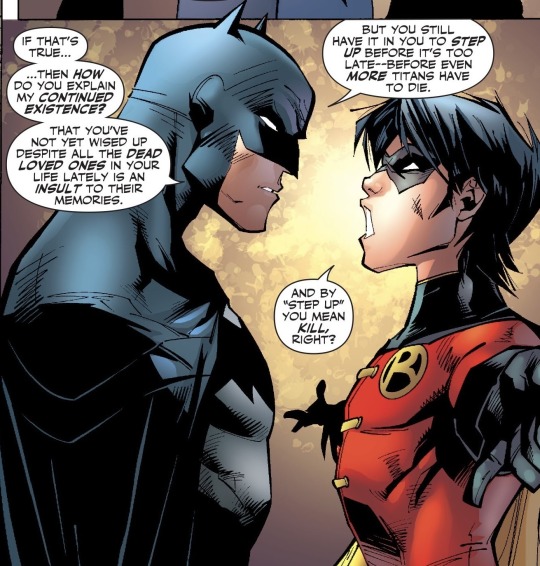
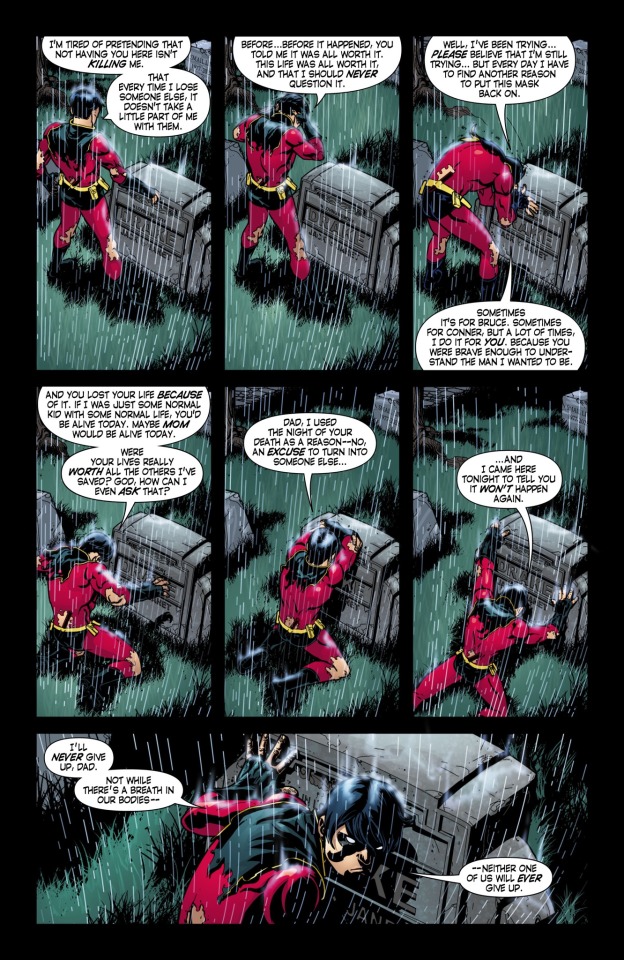

Tim Drake on trauma and tragedy: what makes a hero, and what destroys one.
Comic sources:
Robin Vol. 2 #101
Red Robin #22
Detective Comics #619
Identity Crisis #6
Robin Vol. 1 #1
Robin Vol. 2 #132
DCU Halloween Special 2009, “Our Father’s Sins”
Teen Titans Vol. 3 #51
Robin Vol. 2 #167
DCU Halloween Special 2009, “Our Father’s Sins”
Image descriptions in alt text are also copied below read more.
1. Tim Drake’s narration box from Robin #101, that says: “Does it take more than just the desire to be a hero—do you have to have the trauma and the tragedy to go with it?”
2. Two comic panels from Red Robin #22. The first shows Tim Drake in a cemetary at night, wearing a maroon dress shirt and dark slacks with his hands clasped behind his back as he stares down at a grave that says “Janet Drake, wife” on it. The second panel shows a hand laying in a pool of blood. Reflecting in the blood is a scene of Batman holding Tim Drake in his arms. Tim is not wearing a mask but he’s crying and gripping tightly to Bruce’s arms wrapped around him. It is drawn similar to the scene where Jack Drake dies.
3. Comic panels from Detective Comics #619. The silhouettes of Tim Drake and Alfred Pennyworth stare up at a glass case holding Jason Todd’s Robin costume. Alfred has his hand on Tim’s shoulder as Tim says, “Strange…Dick Grayson’s parents died…and gave the world Robin. And poor Jason…his parents, too.” Alfred leads Tim away from the case, toward the Batcave stairs, as Tim continues, “Maybe…maybe it’s something we all have to go through before…before we put on the suit!” Alfred says, “Heaven forbid, sir! Don’t ever think like that! Not ever!” The last panel shows the solitary glass case with the Robin suit, surrounded by a small circle of light before the rest of the cave is in darkness.
4. Comic panels from Identity Crisis #6. A green narration box says, “…and, of course, fathers.” It shows a scene of young Bruce Wayne in a suit holding two roses with a desolate expression as Alfred Pennyworth stands behind him in a thick, dark coat holding an umbrella. It’s night, there’s a lamppost to the right, and it’s raining as Alfred looks down at Bruce with concern and says, “I’m sorry, Master Bruce.” The scene changes to an adult Bruce Wayne with a young Dick Grayson, standing next to each other in a large circus tent as a police officer walks by. Tears are streaming down Dick’s face as Bruce looks down at him and says, “I’m sorry, Dick.” The scene changes again to Bruce in a suit, standing in a cemetary at night as he looks down and says, “I’m sorry, Tim.”
5. A comic panel from Robin Vol. 1 #1 showing Tim Drake holding Jack Drake’s limp hand as Jack lays in a hospital bed. Tim looks tired and numb as he thinks, “His hand is so small in mine. I remember when I thought it was the biggest hand in the world.” The scene shifts to Tim in the back of a car as Alfred, looking concerned in the driver’s seat, glances back at Tim. Tim has his hand on his forehead as he stares out the window. Tim continues to think, “It’s strange to be leaving them. So many times they travelled the world and left me behind. But more than anything else, this journey is for my parents.”
6. Comic panels from Robin Vol. 2 #132 showing Tim Drake in a dark suit standing under a tree with a despondant but serious expression as he says, “If you’re asking if I plan to continue as Robin, the answer is yes. I’m more determined now than ever before.” The next panel shifts to show how Bruce Wayne is standing beside Tim in a similar suit, holding something under his arm and looking sad. Tim continues saying, “But don’t for a moment think I’m now like you, Bruce. I’m not about to let these losses turn me into another copy of you—grim and vengeful and closed off from most of what keeps us human.”
7. Comic panels from DCU Halloween Special ‘09 #1, which shows three panels, the first of Bruce Wayne in a light brown suit smiling with his face partially in shadow. Tim Drake’s narration boxes say, “When your father died…you hid all your pain and sadness away—” it cuts off to show Tim looking forlorn as he says, “What did you do?” His narration box continues from the previous, “—inside the Batman.” The last panel shows Bruce with his arms folded and a grim expression as Tim asks again, “What did you do? Bruce, what did you do?”
8. A comic panel from Teen Titans Vol. 3 #51 which shows Tim Drake as Batman from the side, facing off against a younger Tim Drake as Robin. Batman Tim says, “If that’s true…then how do you explain my continued existence? That you’ve not yet wised up despite all the dead loved ones in your life lately is an insult to their memories. But you still have it in you to step up before it’s too late—before even more Titans have to die.” Robin Tim looks angry and spreads his arms, getting up in Batman Tim’s face as Robin Tim says, “And by ‘step up’ you mean kill, right?”
9. A comic page from Robin Vol. 2 #167 showing Tim Drake in a tattered red-and-black Robin suit standing in the rain in front of a gravestone that says, “In loving memory: Drake. Jack and Janet.” Tim says, “I’m tired of pretending that not having you here isn’t killing me. That every time I lose someone else, it doesn’t take a little part of me with them.” Tim clutches his own head and continues, “Before…before it happened, you told me it was all worth it. This life was all worth it, and that I should never question it.” Tim bends over, forehead and hands pressed against the top of the gravestone, and continues saying, “Well, I’ve been trying…please believe that I’m still trying… but every day I have to find another reason to put this mask back on. Sometimes it’s for Bruce. Sometimes for Conner, but a lot of times, I do it for you. Because you were brave enough to understand the man I wanted to be.” Tim falls to his knees in the mud and raises his arms as he continues saying, “And you lost your life because of it. If I was just some normal kid with some normal life, you’d be alive today. Maybe mom would be alive today. Were your lives really worth all the others I’ve saved? God, how can I even ask that?” Tim crosses his arms over the top of the gravestone and lays his head against it as he continues, “Dad, I used the night of your death as a reason—no, an excuse to turn into someone else…” Tim drops lower, almost laying down but with his hands still clutching the gravestone as he says, “…And I came here tonight to tell you it won’t happen again.” Tim finally turns his head to look behind him, a hand still on the grave as shadows and light play across his fierce expression. He says, “I’ll never give up, dad. Not while there’s a breath in our bodies—neither one of us will ever give up.”
10. A cropped comic panel from DCU Halloween Special ‘09 showing Tim Drake’s sillhoette in his Red Robin suit, walking away in the foggy night, toward a tall gate and fence past rows of gravestones. Behind him, the angle of the lighting makes a long shadow in the rough shape of a bat.
#tim drake#batfam#bruce wayne#batman#dc comics#okay so. this is why I like tim comics. also btw that last one is from a story about Bruce’s death. just to tie everything together#heroesriseandfall#bonds: someone alone like me#dc meta#edits#jack drake#janet drake#dc#death mention#my edits
624 notes
·
View notes
Text
Tony Stark and Arthuriana
Coming to you by special request, a very long post about 616 Tony's interest in Arthuriana, with a focus on all of Tony's run-ins with Morgan le Fay!
I feel like I should disclaim the extent of my knowledge here, which is that I still haven't managed to read anywhere near every issue of Iron Man -- at least, not yet, anyway -- so I'm just going by the things I know I've read, and Morgan le Fay's Marvel wiki entry is frustratingly under-cited, so it's very possible I've missed something relevant, but I'm pretty sure I've got the big stuff down. My other disclaimer here is that I'm not as big an Arthurian nerd as Tony is, which is to say that most of my familiarity comes from modern retellings -- T. H. White's The Once and Future King, Marion Zimmer Bradley's The Mists of Avalon, Mary Stewart's The Crystal Cave, Rosemary Sutcliff's Sword at Sunset -- and not so much the usual classic sources on the Matter of Britain, though I've read bits and pieces of them.
(This is because I wanted to read versions of them that were as close to the original as possible but so far have not ended up finishing any of them because, well, that's hard. So I've never read the Mabinogion because I do not know Welsh. I've got the Norton Critical Edition of Malory's Le Morte d'Arthur, which is probably the best student edition if you're looking for something without modernized spellings, as I was. I've also got -- well, okay, it's my wife's but I'm borrowing it -- a relatively recent Boydell & Brewer edition (ed. Reeve, tr. Wright) of Geoffrey of Monmouth's Historia Regum Britanniae (History of the Kings of Britain), which is, you guessed it, in Latin with a facing English translation. I haven't gotten very far in it because, in case you didn't know this about Latin texts, the beginning is pretty much always the hardest, so I gave up and read some Plautus adaptations instead. Anyway, if for some reason you too want to read Geoffrey of Monmouth in the original Latin I'd recommend that one, but I can't recommend any particular English translations because I've never read one by itself. I bet you didn't think you'd be getting Latin prose recommendations in this post. I mean, maybe you did; it is me, after all.)
Okay. Right. King Arthur. Here we go.
We've got:
Flashbacks to Tony's childhood in late Iron Man volume 1
A brief discussion of Morgan's origin story and Avengers #187
Iron Man vol 1 #149-150: Doomquest
What If vol 1 #33: What if Iron Man was trapped in the time of King Arthur?
Iron Man vol 1 #249-250: Recurring Knightmare
Iron Man: Legacy of Doom #1-4
Avengers vol 3 #1-4: The Morgan Conquest
Civil War: The Confession
Mighty Avengers vol 1 #9-11: Time Is On No One's Side
In terms of universe-internal chronology, we know from Iron Man #287, from 1992, that Tony has been a fan of King Arthur since childhood. This is an issue of a fandom-favorite arc which features Tony having a lot of childhood flashbacks, including the famous "Stark men are made of iron" line (in #286) that for some reason MCU fandom decided it loved; I mean, seriously, I've seen that quoted in way more MCU fic than 616 fic. But slightly later, in #287, we get an entire page devoted to Tony's love of King Arthur.
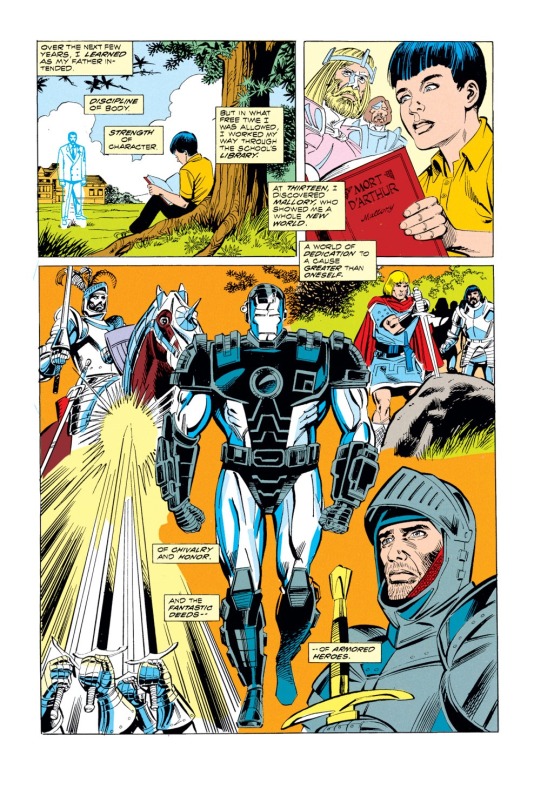
The narration reads: "Over the next few years, I learned as my father intended. Discipline of body. Strength of character. But in what free time I was allowed, I worked my way through the school's library. At thirteen, I discovered Mallory [sic], who showed me a whole new world. A world of dedication to a cause greater than oneself. Of chivalry and honor. And the fantastic deeds -- of armored heroes."
The art shows Tony as a child sitting under a tree, reading a book labeled Mort D'Arthur by Mallory [sic] -- no, don't ask me why nobody at Marvel checked how to spell either the name of the book or its author -- and daydreaming of King Arthur, the Sword in the Stone, knights, et cetera. Just in case you somehow missed the extremely blatant hint that we are meant to understand that Tony's knight obsession heavily influenced him becoming Iron Man as an adult, we see one of his armors mixed in with all the drawings of knights. So, yes, canonically Tony is Iron Man at least partly because he's a giant King Arthur nerd, which I think is so very sweet. I love him. He's such a dork!
(This issue is currently in print in the Iron Man Epic Collection War Machine, should you need your own copy.)
This isn't actually the only reference to Tony as a King Arthur fanboy in this era of canon, either; a little later, in IM #298, we see that one of Tony's passwords is actually "Mallory." (Yeah, no, they still couldn't spell. But it's cute.)
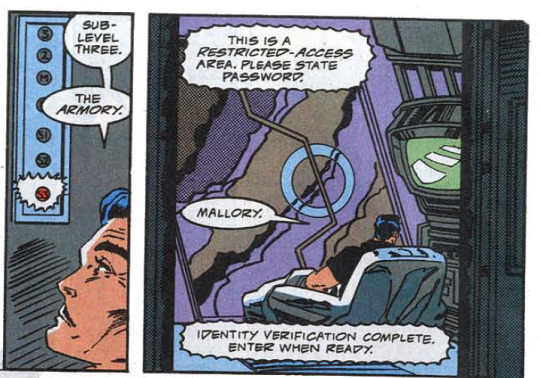
But in terms of actual publication order, this is definitely not the first time we have seen in canon that Tony is into Arthuriana, as I'm sure you all know. I would assume, in fact, that giving Tony a childhood interest in Arthuriana is because Doomquest is one of the most beloved Iron Man story arcs of all time, and that all started at least a decade before IM #287 here was published.
The villain of Doomquest -- the one who isn't Doctor Doom, at least -- is Morgan le Fay. Yes, that Morgan le Fay. Yes, Arthur's evil half-sister Morgan le Fay. Yes, all of this King Arthur stuff is canonically real history on Earth-616. Morgan's first appearance in Marvel, per the wiki, was in Black Knight #1 (1955), which I have not read, and judging by the summary I feel like this is probably just supposed to be a straight-up comic retelling of Arthurian legends for kids; I don't think Marvel really had the whole Marvel Universe in mind as a concept in 1955, so I'm not sure this was meant to connect to anything else. I feel like this is another one of those instances of Marvel discovering that they can write comics about characters in the public domain for free -- like, I'm pretty sure that's how we also ended up with, like, Norse, Greek, and Roman mythology wedged into 616.
As far as I can tell from the wiki, the first time Morgan tangled with the Avengers (or indeed the larger 616 universe) in any way actually predated Doomquest -- it was in an early arc in Spider-Woman (#2-6) and then Avengers #187, which came out in 1979, actually right when Demon in a Bottle was happening over in Iron Man comics. If you read #187, Iron Man is not in it because he's off the team due to his drinking problem and also his accidentally murdering the Carnelian ambassador problem. So Wonder Man's filling in instead. This issue is part of Michelinie's rather sporadic Avengers run, which makes sense, I guess, considering where we see Morgan next.
Anyway, Avengers #187 is the classic issue where Wanda is possessed by Chthon, but what you may not remember from Chthon's backstory (I sure didn't!) is that he was summoned by Morgan le Fay because she was the first person who tried to wield the Darkhold to summon him. As you can imagine, this did not work out especially well for her and her followers and they had to seal Chthon away in Wundagore Mountain, which was where Wanda found him. (The Spider-Woman stuff is only slightly earlier and also appears to be about Morgan and the Darkhold; the Darkhold is not one of the areas of 616 canon I am especially conversant with, alas. It's on my to-read list.)
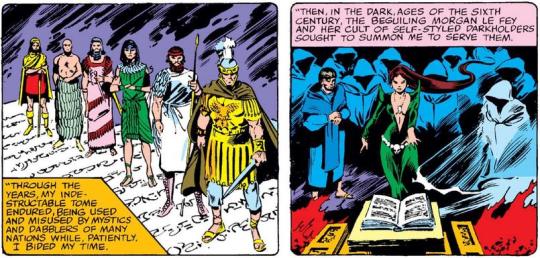
Doomquest, as you probably know, was a classic Iron Man two-parter in Layton & Michelinie's first Iron Man run that set up Tony and Doom as rivals; Doomquest itself was IM #149-150, in 1981, and then in their second IM run they came back and did a sequel in 1989, Recurring Knightmare (IM #249-250), and then the much later four-part sequel to that was the 2008 miniseries Iron Man: Legacy of Doom, which was also by Layton & Michelinie but generally does not seem to be as popular as the first two parts. They've all been reprinted, if you're looking for copies; I have a Doomquest hardcover that collects the first four issues and then a separate Legacy of Doom hardcover. Currently in the Iron Man Epic Collection line there's a volume called Doom, which confusingly only collects the 249-250 part of the storyline (as well as surrounding issues), because for some reason the first Layton & Michelinie run isn't in Epics yet but the second one is. So the beginning of Doomquest isn't currently in print, as far as I can tell. I'm sure you can find it anyway.
So what's Doomquest about? Okay, so you remember how Doctor Doom's mother's soul is stuck in hell for all eternity? Well, Doom's obviously interested in getting her back, and the strategy he has embarked on is to try to team up with other powerful magicians who can help him out, and he thinks Morgan le Fay would be a good choice, for, uh, his quest. Doom's quest. A Doomquest, if you will. (If you've ever read Doctor Strange & Doctor Doom: Triumph & Torment, you're familiar with the part where he later ends up waylaying Strange for this and they go to hell together. And if you haven't read Triumph & Torment, you really should, because it's amazing.)
So Doom is off to his time machine to go team up with Morgan le Fay and Tony thinks Doom is up to something -- Doom has been stealing components for his time machine from a lot of people, including Tony -- and he follows him and it turns out one of Doom's lackeys has a grudge and wants to trap Doom in the past forever, and Tony gets caught up in it. Now they're both in Camelot. Surprise! #149 is actually all setup; they don't get to Camelot until #150.
IM #150 begins with Doom and Tony thrown back into the past; there's a fandom-famous splash page of them locked in combat, only to realize that they have found themselves in Camelot.

They are then discovered by knights; Doom would very much like to attack them, but Tony, who naturally would be happy to LARP Camelot forever, persuades him to play nice. Also Doom thinks Iron Man is only Tony's bodyguard so he keeps referring to him as "lackey," much to Tony's annoyance. Somehow everyone thinks they're sorcerers. Can't imagine why. The knights take them to meet King Arthur himself, and Tony has clearly had his introduction all ready to go, as he introduces himself in a timeline-appropriate manner, says he's here to apprehend Doom, and demonstrates his "magic" by levitating Arthur's throne. Doom's response is essentially "I'm the king of Latveria," which is, y'know, also valid. So they're guests at Camelot for the night while Arthur figures out what to do with them.
We then have a page devoted to Tony alone in his room, musing sadly about how alien he feels, how he doesn't know if he'll ever get home, how he could never fit in here without his beloved technology. Then a Sexy Lady shows up to keep him company for the night, and he decides maybe it's not all bad. Thanks, Marvel. I guess they can't all be winners.
Doom is using his evening much more productively; he compels one of the servants to tell him where Morgan's castle is, because he's still interested in having that team-up. Then he jets off. Literally. He has a jetpack.
The next morning Arthur's like "one of you is still here and one of you has punched a hole through the castle wall and flown off to join Morgan so I guess I know which of you is more trustworthy." He then explains to Tony who Morgan is, because Tony professes ignorance, because clearly we had not yet retconned in Tony's love of Arthuriana. Tony offers to go fight Doom and Morgan with Arthur; meanwhile, Morgan and Doom have teamed up and Morgan has offered to help get Doom's mother out of hell if he commands her undead armies against Arthur because for Reasons she can't command them herself anymore. So that's a thing that happens.
So, yes, it's Tony and Arthur versus Doom and Morgan. Fight fight fight!
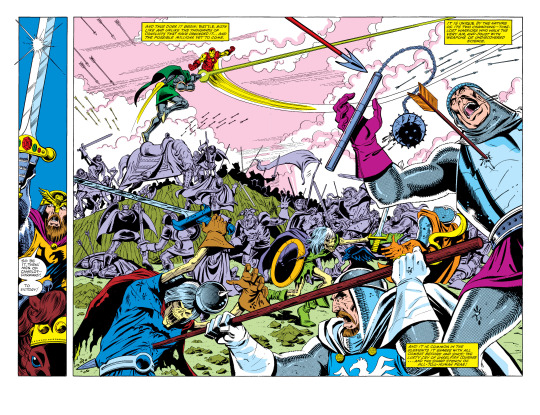
Tony tries Doom first but then decides to hunt Morgan down, and in the ensuing fight we get what I think is Tony's first ever "I hate magic," a complaint that we all know he still makes even to this day.
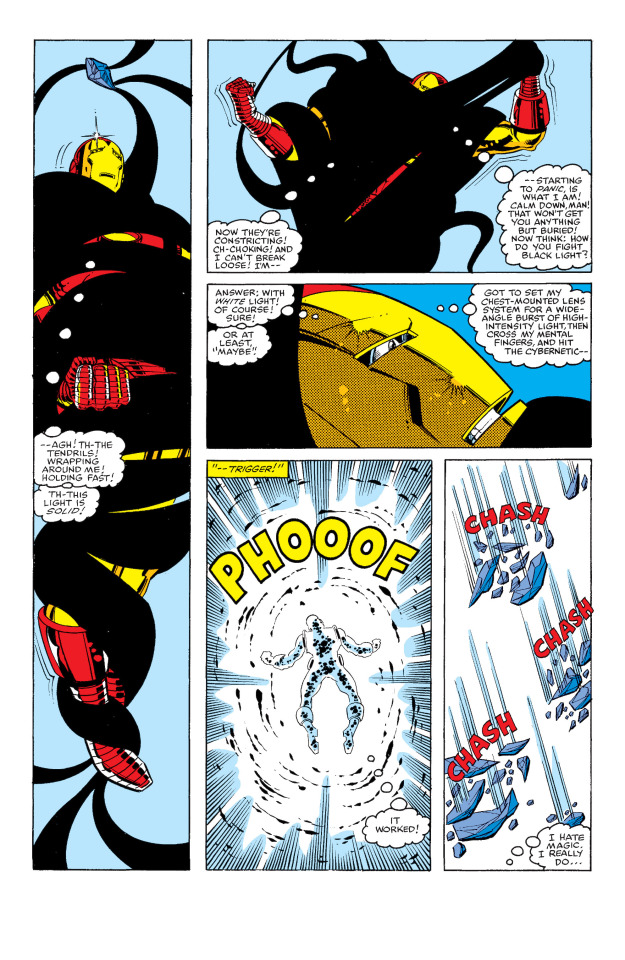
Anyway, Tony freezes a dragon with Freon (mmm, technology) and Morgan gets upset and disappears, so the battle comes to an end, and of course Doom is extremely mad at Tony because he blames Tony for Morgan not sticking around to save Doom's mom, because I guess Doom trusted her to keep her word? Weird. (Like I said, for the next chapter of Doom saving his mother, go read Triumph & Torment.)
Doom says if he and Tony work together, the components in both of their armors can send them both home. So Tony has to trust Doom. Which he does, because he really has no other choice. They build a time machine and Tony makes Doom agree to a 24-hour truce when they get back, so they can both get home. So it all works out okay, and they end up in the present, and Doom tells him, ominously, that they will meet again. Okay, then. That concludes the original Doomquest. It's fun! You can see why fandom likes it.
So that's all well and good, but you might have noticed that Tony's ability to get home hinged on Doom actually being trustworthy. And Doom was. But what if Doom hadn't been? What if he'd just stranded Tony in Camelot forever As you may have surmised from the form of that question, that is in fact a question Marvel asked themselves, because, yes, there's a What If about this! What If v1 #33 is "What if Iron Man was trapped in the time of King Arthur?"
The divergence point from canon, as you can probably guess, is the very end of Doomquest. Instead of Doom bringing Tony home, he deceives him and leaves him in Camelot. And since Tony cannibalized a lot of the tech from his armor to make the time machine, he doesn't have a way to go home.

This is not a story where Tony comes up with a way to go home after all. He really doesn't get to go home. But instead of drowning his sorrows in mead -- because, remember, Demon in a Bottle has already happened and Tony is sober now -- he decides he might as well just play the hand he's dealt. So with what's left of his armor, he defeats some enemies that Morgan rounds up to send against Camelot. And for his services, he's knighted. He is now Sir Anthony.
Tony acknowledges that he is both living the dream and would also like very, very much to go home.
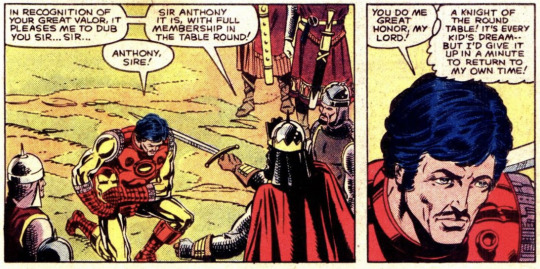
He does end up having some fun in Camelot; it's not all miserable. But he obviously doesn't want to be there.
So if you're at all familiar with King Arthur, you know how this goes, right? Arthur fights Mordred and Mordred kills him. And that does happen in this version. Except Tony is right there, and with his dying words, Arthur asks Tony to rule Camelot... and Tony agrees.
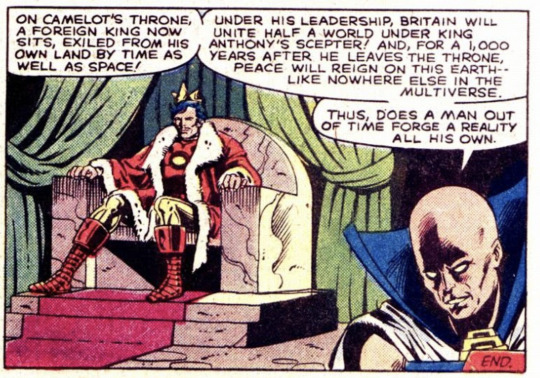
So, yes, Tony Stark becomes king of the Britons after Arthur's death and he never goes home again. The end. Man, I love What Ifs.
Heading back to main 616 continuity, there is still more of this arc to go. The original Doomquest was only two issues, yes, but it was popular enough that Layton & Michelinie did a sequel a hundred issues later, in their second run of Iron Man, and that's Iron Man #249-250, Recurring Knightmare. (In the intervening issues were Denny O'Neil's IM run, specifically the second drinking arc (#160-200), and then Layton & Michelinie came back and most famously gave us Armor Wars (#225-232). I would have to say that Armor Wars is definitely the standout fandom-favorite arc of their second IM run; for their first one, I think a lot of people would have a hard time choosing between Doomquest and Demon.) But anyway, yes. Recurring Knightmare.
Recurring Knightmare is... well, the best way I can describe it is "a trip." It is definitely a sequel to Doomquest, and it is also definitely not a sequel you would ever have expected to see for Doomquest.
Much like #149, #249 is pretty much just setup. Fun setup, but the big action is in the next issue. We open with Doom in Latveria, on his throne, pondering which of his servants he should have disintegrated. Anyway, he's just hanging out there when a mysterious object appears. In California, Tony is suited up and entertaining the crowd at a mall opening when the same object also appears! He takes it to his lab. Please note that this is after the Kathy Dare incident, so Tony is still recovering and is walking with a cane. Doom sees on the news that Iron Man has found the same object, which cannot be carbon-dated, and he shows up at Tony's house. He criticizes Tony's taste in art.
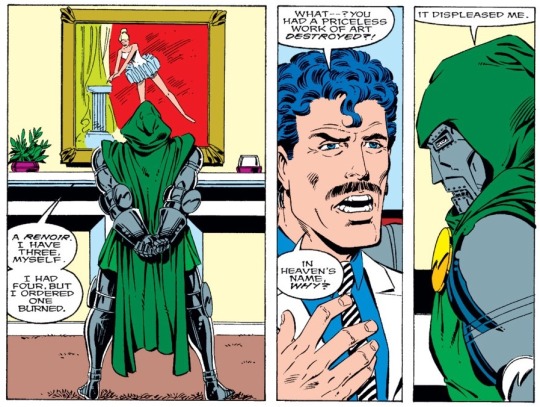
Anyway, Doom basically orders Tony to work with him. Tony refuses, and then Doom sends some robots to attempt to steal Tony's version of the object because he thinks if he has them both he will be powerful. Doom manages to steal it, and when he puts the pieces together, both he and Tony disappear.
So where do they go, you might ask? Camelot?
Not exactly. The future! There is a great callback to the Doomquest splash page.
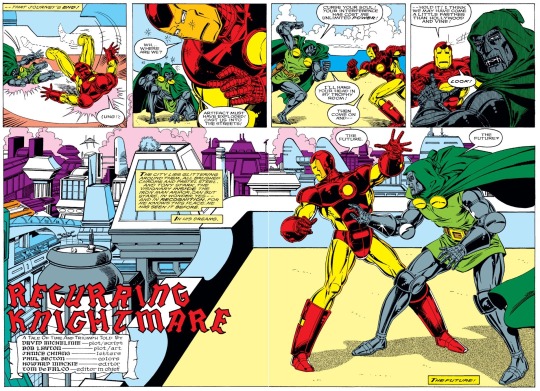
It turns out they are in London in 2093. Merlin brought them there. Tony still hates magic. And in the future, King Arthur is still there, except he is now a child, because he has been reborn. But he does remember Tony from Doomquest, at which point Tony kneels. Doom, of course, is not impressed. He asks why they have been brought to the future.
The answer is that things are going wrong in the future. If you do not personally remember United States politics in the 1980s, I need you to google the words "Strategic Defense Initiative" right now. I'll wait.
Back with me? Okay, so this is a future where Reagan's Star Wars program actually happened the way he wanted it to, and the satellites are still hanging around the Earth in the future and messing everything up, and Arthur and Merlin need Tony and Doom's help to stop them. Doom once again flies away with his jetpack, of course.
Tony is game to help, but he's not in an armor that can stay in space for long. This is when Merlin takes him and Arthur to the mall and Tony manages to get everything to upgrade his armor at Radio Shack. You see what I meant about this issue being weird.
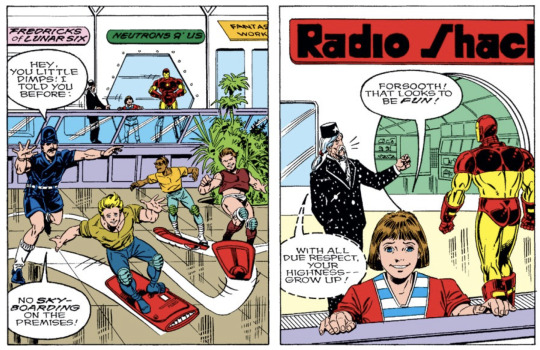
Tony is out in space trying to disarm the SDI platform, which is where he runs into his future descendant, Andros Stark, who is in armor you will probably recognize from Iron Man 2020. He is referred to as "the resurrected spawn of Iron Man 2020" so I assume he's actually directly related to Arno rather than a direct descendant of Tony; Wiki confirms that Arno is his grandfather. This is all from way before Arno was contemporaneous with Tony in canon. Anyway, he's fighting Tony.
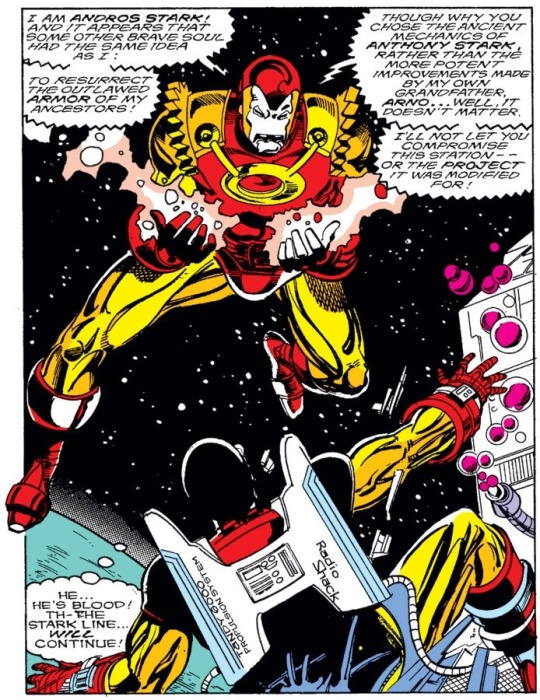
Oh, by the way, Future Doom exists. Future Doom would like to rule this future Earth and for some reason Andros would like to help him. Meanwhile, Present Doom finds out from Merlin that he can't leave except by magic and he can't leave without Tony, so he is reluctantly on Tony's side.
They need help from the Lady of the Lake, except the lake has been paved over and is now a parking lot. Merlin makes the lake come back and then of course they get Excalibur. Arthur is a kid, so he can't wield a longsword; Doom assumes he's going to take it because he is basically a king, and he's pretty grumpy when the sword picks Tony. Tony then uses Excalibur to destroy the space lasers, and I bet that is a sentence you never thought you would read. It's pretty cool. Tony concludes that magic has its good points. Tony stops Andros and Doom stops, uh, himself, and the world is saved and they get to go home. Also, Doom finds out Tony is Iron Man, but when Merlin sends them back he conveniently erases their memories, so neither of them remember anything about this and Tony's secret is still safe. And that's the sequel to Doomquest.
And if you think that's weird, wait until you see Legacy of Doom.
Iron Man: Legacy of Doom is a four-issue miniseries from 2008, also by Layton and Michelinie. Even though it's from 2008, it's set during a much more classic time in Iron Man, continuing on from where we left off in this Doomquest saga. We start with a framing story in 2008. Tony, who has Extremis now, is busy scrapping some of his older armors and reviewing his logs when he suddenly remembers that there was a whole thing with Doom that happened that he seems to have forgotten about until right now. So the whole thing is narrated by Tony in flashback.
Tony's in space fixing a satellite when a hologram of Doom shows up and summons him to Latveria. It's not really clear why Doom needs Tony's help in particular here, but Doom tells Tony that he's discovered that Mephisto would like to bring about the end of the world, which Doom finds, and I quote, "presumptive." So Doom has his Time Cube, and with it he takes Tony to hell.
(Yes, I promise this is relevant to Doomquest. There will be some Arthuriana shortly.)
Doom brings Tony to Mephisto, and it turns out it's a setup! Doom trades Tony for an item he wants from Mephisto, leaves, and Tony's going to be trapped in hell forever! Oh no! (I mean, he's not. But it's quite a cliffhanger.)
At the beginning of issue #2, we find out what the Arthurian connection is, which is that we learned that after the events of Doomquest, Morgan had been granted sanctuary by Mephisto in exchange for a shard of Excalibur that she had somehow stolen. Doom still wants Morgan's help with some magic -- he doesn't mention what it is here, but he says he needs someone of Pendragon blood, and that'd be her -- so he traded Tony to Mephisto in exchange for, I'm guessing, Morgan and the Excalibur shard.
I have probably mentioned this elsewhere, but Legacy of Doom #2 is one of my favorite issues of Iron Man ever, solely because of the next scene. We return to Tony in hell. Howard Stark is also in hell, and he is now a demon, and Tony has to fight him. Mephisto brings popcorn and watches. This is the one time in canon when Tony actually confronts his father, and okay, yes, it's a fistfight in hell and Howard is a demon, but that's comics for you. Howard spends several pages insulting Tony -- specifically insulting his masculinity, but that's a whole other essay -- until he finally insults Maria too, and that's when Tony fights back, because his mother taught him to be good. Honestly if you're a Tony fan I'd recommend this issue just for that scene.
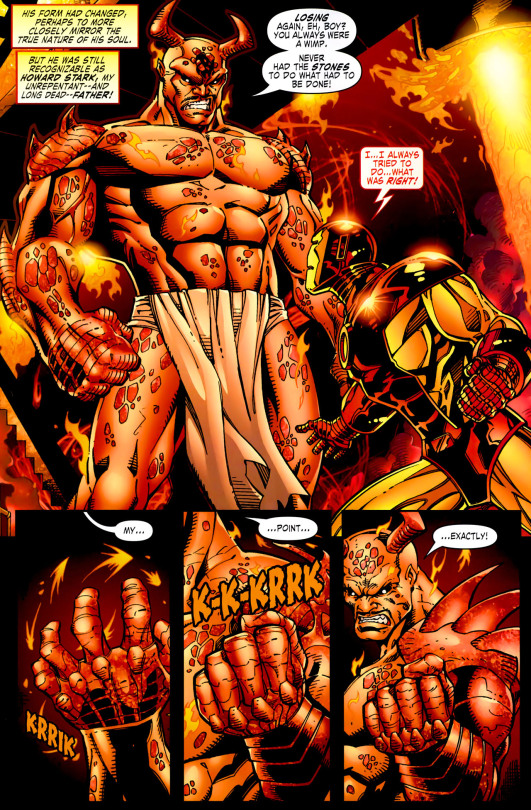
Anyway, we go back to the Doom and Morgan plot, and Morgan casts the spell Doom wanted, which was fusing the Excalibur shard with Doom's armor. Then Doom sends her back to Camelot rather than hell, because he's still mad that she never helped him get his mom out of hell like she said she would.
Tony freezes Howard with Freon -- yes, the same trick he pulled on the dragon back in Doomquest -- and tells him, "You're no father of mine." It is immensely satisfying.
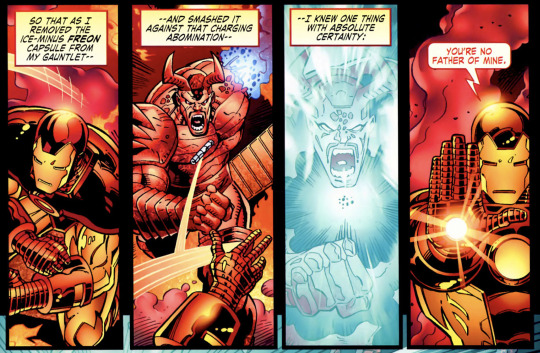
(I had been going to mention that I thought it was a shame that neither canon nor fandom seems to have really engaged with this confrontation, and I know canon never believes in narrative closure but fandom sure does -- and then, anyway, it occurred to me that since the framing story of Tony remembering this is set when Tony has Extremis, there's a very good chance that he no longer remembers remembering it. Goddammit, Marvel.)
(If I got to retcon one canon thing about Tony, I think "the entirety of World's Most Wanted" is up there. I mean, okay, a lot of things are up there, but WMW is definitely on the shortlist.)
Okay. Tony has now engineered his way out of hell, and he's back with Doom in Latveria. Doom has Excalibur. Doom would very much like to fight him. While wielding Excalibur. You get the sense that this is going to be bad. Another cliffhanger!
Legacy of Doom #3 opens with Tony destroying Doom's lab to buy time and running away from Doom and Excalibur. I should probably mention that Doom still doesn't know Tony is Iron Man (anymore), so he thinks he is dealing only with Iron Man, Tony Stark's lackey. Meanwhile, some scientists at SI think there's something weird going on with space. Meanwhile meanwhile, Tony is in a forest taking a breather when a mysterious old man walks up to him.
It's Merlin! Surprise! Merlin wants Tony's help to stop Doom from doing whatever he's doing with Excalibur. The sword makes you invincible and the scabbard makes you invulnerable, so Merlin sends Tony to Scotland on a fetch quest for the scabbard. Doom has now magically sent the sword in search of the scabbard, so the sword flies away to meet it and Doom follows. Turns out the thing that's wrong with space is a thing that's going to hit Earth at the exact place Tony and Doom are. What a coincidence! So Tony and Doom get trapped in a stone circle and fight some stone warriors and then Tony ends up with the scabbard. And by "ends up with," I mean it fuses to his armor. Next issue!
Legacy of Doom #4 is when things really, really get weird. A giant demon made of eyes (???) appears, and this demon is apparently what Doom had been preparing to fight (because it's mad that Doom stole one of its spellbooks), and now he can't, because the sword and the scabbard aren't together. Thanks, Shellhead.
That's when Merlin shows up and says all is not lost. They can defeat the demon... if they put the sword into the scabbard.
"But I'm the scabbard now!" Tony says, uncomprehending.
"Yes," Merlin says. "You are."
Then Tony gets it.

So, yes, Doom has to, um, penetrate Tony. With Excalibur. I love comics. I love comics so much.
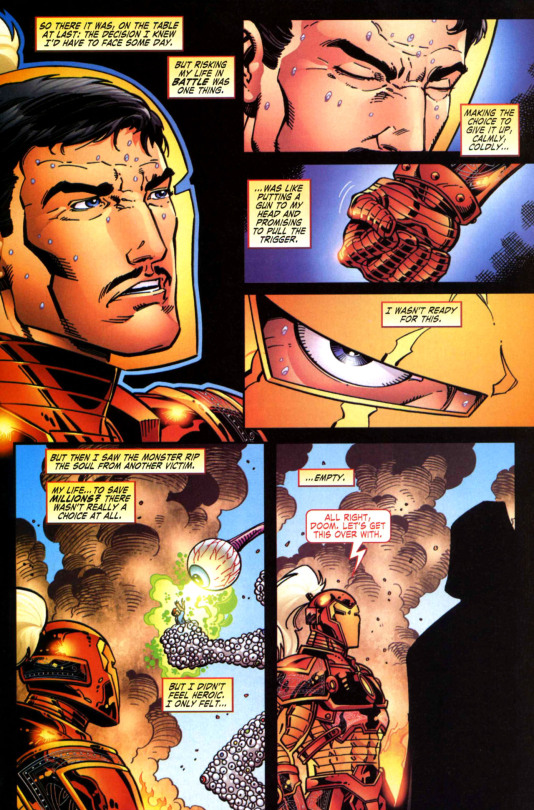
So that's a thing that happens.
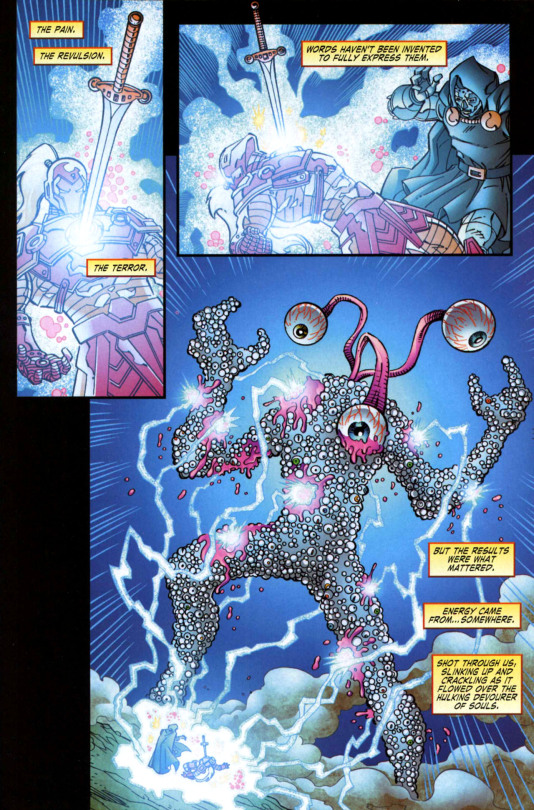
And then Tony flies off and, I guess, resolves to never, ever think about any of this again.
We head back to the framing story, in which Tony, now having remembered all of this, flies to Britain, buys the land the lake is on, and paves it over, presumably so it will be there for Merlin to bring back in Iron Man #250. The end.
Whew.
Okay, yeah, I know I didn't have to summarize the whole thing, but Legacy of Doom here really is one of my favorite Iron Man miniseries. And I just want to share the love. Please read it. It's great.
But the Arthuriana fun doesn't end there! In fact, now we get an Arthurian-themed arc that actually isn't in Iron Man comics. It's in Avengers! Iron Man is involved, though.
(There is also apparently a Morgan arc in Avengers #240. I actually haven't read it. It seems to be yet another Spider-Woman arc. I get the impression that this isn't really Arthuriana other than having Morgan in it fighting Jess, though, so it doesn't seem quite as relevant. Morgan also apparently has some appearances in FF, Journey into Mystery, and Marvel Team-Up, but those seem like more of just basic villainy. Also, probably not involving Tony.)
Kurt Busiek's 1998 Avengers run, volume 3, is in large part the kind of Avengers run that is a nostalgic love letter to older comics. Heroes are heroes and villains are villains and good triumphs over evil. The Avengers all live in the mansion and are BFFs. I love it. It does assume that you are already a fan of the Avengers, because it starts out by summoning pretty much everyone who has ever been an Avenger and is available to the mansion, and that is... a lot of people. Thirty-nine, by my count. Also, when the entire team is magically whisked away, we are treated to the following narration, as Steve disappears: "And Captain America's last thought, as the world goes white around him, and he with it -- is that Iron Man would hate this."

The narration doesn't tell you why Iron Man would hate this, or how Captain America would know that Iron Man hates this. This is not explained later on. But if you have read comics -- or if you have read the above summary of Doomquest -- you know that Tony is absolutely, one hundred percent, thinking, "I hate magic." And Steve knows it.
The reference is not relevant to the plot; if you don't get it, you'll be fine. But that's what I mean when I say this is a nostalgia run. There are definitely Easter eggs for people who have read a bunch of comics. Busiek does this a whole lot in his work -- there's a reason you can buy an annotated edition of Marvels -- and, yeah, it happens here too. Just know that there will be references you're not getting, if you're new to comics.
Anyway. So Busiek's run actually starts out with an Arthurian arc, #1-4, "The Morgan Conquest." The name is a dead giveaway. Yes, Morgan le Fay is back. Again. For once, Doom is not involved.
The Avengers are all back from their sojourn on Counter-Earth after fighting Onslaught -- don't worry about it -- and mysterious things are happening. There are a lot of monster attacks. So pretty much everyone who has ever been an Avenger is summoned to the mansion, at which point we learn from Thor about some mystical artifacts that are being stolen. (They are the Norn Stones and also the Twilight Sword. That sounds like something from a Zelda game, doesn't it?) The Avengers go to try to stop this, end up in Tintagel, and then they run into Mordred. He wants to capture Wanda, presumably for Magic Reasons. Morgan le Fay casts a spell on all of them, reshaping reality. Yes, all of them. Surprise!
So now all the Avengers are living in a medieval castle and/or town; Morgan is their queen, and thanks to the power of mind-control they are all basically living in Ye Olden Times. The Avengers are all some variety of knight, except for Wanda, who is chained up in the dungeon so Morgan can steal her magic and use it to fuel all this reality-warping.
Wanda calls for help, and that snaps Steve (Yeoman America!) out of the mind control (or altered reality or whatever you want to call it) pretty fast, because Steve's always been very good at resisting mind control, and then Steve promptly goes and snaps Clint out of it, because I guess Steve is also good at inspiring people to snap out of mind control. "Oh, man!" Clint says. "Not another alternate reality! Not again!" (I assume he's referring to Counter-Earth? Maybe?)
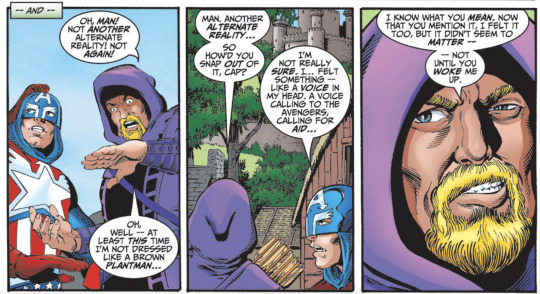
So Steve and Clint go around reassembling the Avengers and orienting them as to reality. They get Jan and Monica easily, but then Steve insists on trying to get Tony because, I guess, he likes Tony and would really like to hang around Tony, who is half-naked and asleep in his bedroom, and certainly I am reading nothing whatsoever into this. Clint tells Steve it's not going to work. Tony has historically been fairly susceptible to mind control; it was only pretty recently at this point that he'd been doing Kang's bidding in The Crossing. But the more serious impediment is that this is Tony Stark and he would obviously like to LARP being a knight forever and ever. Tony, therefore, does not believe Steve, and throws him and Clint out of his bedroom and into the barracks.
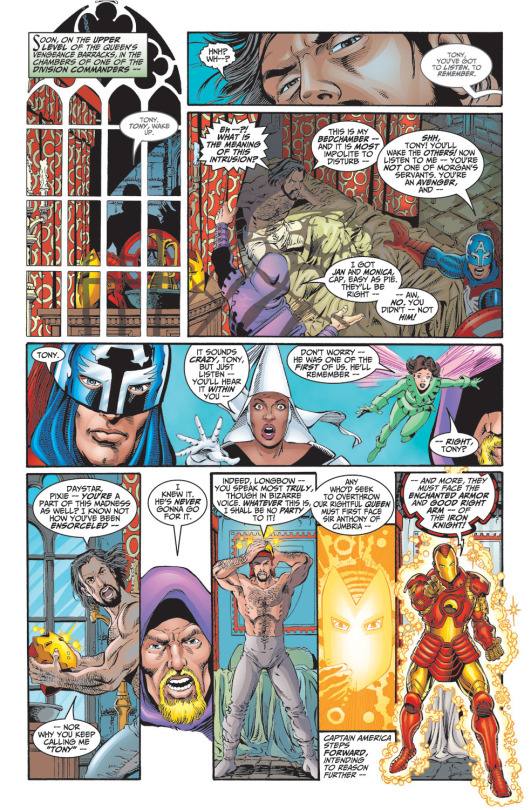
"Iron Man's a good guy, normally," Clint says. "But he's waaay too into his whole nobleman/lord of the manor trip. That spell musta hit him right where he lives!"

Clint speaks the truth, clearly.
Anyway, they go around and manage to make pretty much every Avenger in the room other than Tony snap out, and attempt to rebel against Morgan while Tony is stil fighting them because he is Still A Knight. There's a lot of punching, because some of the Avengers still aren't free; they weren't ones Steve found.
The day is saved when Wanda manages to channel Wonder Man and break free. This gives the Avengers a fighting chance against Morgan and the Avengers are all lending Wanda their power when Tony finally snaps out of it and is on the side of good.

Then they take Morgan down, go home, and attempt to figure out which of these thirty-nine people should be on the active Avengers team. Hooray.
But that's not the end of Morgan le Fay showing up to screw around with Tony's life! There's more to come! Not much, but there is one that I know of, and at least one more memorable reference.
(I haven't read all her appearances or anything, but one of them definitely involves Tony; I can't swear that he doesn't appear in any of the other books Morgan shows up in, but it'd be a cameo for him, because I only know of one more arc that she's in in a book that Tony stars in.)
In a few more years, we have now entered the part of Marvel Comics history where Brian Michael Bendis writes all the Avengers books at the same time for, like, seven years running. It was sure A Time. There were a lot of word bubbles.
And the thing about Bendis is, Bendis looooooves Doomquest. If you're familiar with the very end of his tenure at Marvel where he made Doom be Iron Man after Tony got knocked into a coma in Civil War II, you have probably figured out already that he likes Doom. But he also likes Doomquest, specifically.
I mean, if nothing else, the giant splash page in The Confession where Maleev redrew the climactic Doomquest fight while Bendis had Tony talk about how deeply meaningful to his understanding of the world this all was -- and how it allowed him to predict Civil War -- was probably a big clue, right?
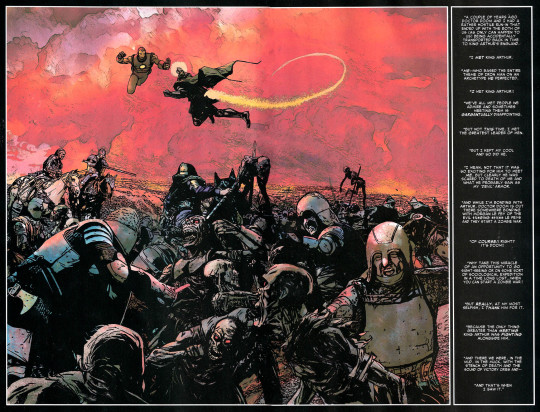
As far as I am aware, Morgan le Fay makes exactly one more appearance in Tony's life. And that's in Mighty Avengers vol 1 #9-11. Only one of those issues is named, so I'm going to assume the arc is named after it: Time Is On No One's Side.
You remember Mighty Avengers, right? The deal with the Avengers books at the time was that after Bendis exploded the mansion and made the team disband in Avengers Disassembled, the main Avengers book was no longer called just Avengers. Instead, the main Avengers book was New Avengers, and that was the only Avengers book. Then Civil War happened, Steve got killed, and New Avengers became the book about what was left of the SHRA resistance (i.e., Steve's side) after the war. So about halfway through New Avengers, Mighty Avengers starts up, and Mighty Avengers is about an extremely fucked-up and grief-stricken Tony Stark trying to run the official government-sanctioned Avengers team, with Carol's help. This is the comic with the arc where Tony turned into naked girl Ultron. You remember.
So, anyway, there's this Mighty Avengers arc where Doom is Up To Something (there are symbiotes and a satellite involved) and somehow Tony and the Avengers end up in Latveria, punching Doom. Also, by the way, Doom is visiting Morgan in the past because he likes her. The Avengers attacking his castle made him have to come back to the present, so he's kind of cranky. And he fights Tony, and in the course of the fight, his time platform explodes and sends Doom and Tony and also the Sentry to... the past.
This is one of those times where you should definitely look up the comics if possible because the way the past is visually indicated here is that it's colored with halftone dots the way you would expect old comics to be colored, although they have modern shading and color palettes. It's very charmingly retro.

So the three of them are stuck in New York in the past, and naturally they would like to leave. There's one person in this time who has a time machine and it is, of course, Reed Richards. Doom and Tony have a lot of banter in this arc; I think it's entertaining.
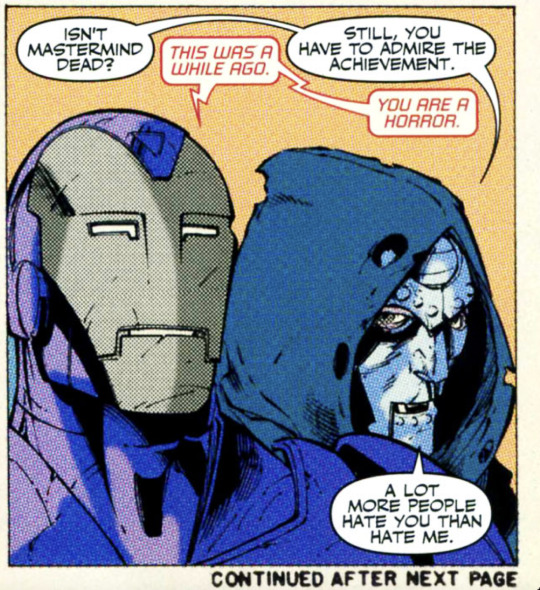
Sentry has to be the one to break them all into the Baxter Building because of that power he has where no one will remember him. So they do that, travel forward in time, and end up in Latveria in the present again except Doom is gone and also things are currently exploding where they are.
Doom, of course, has made a side trip to visit Morgan again and he asks her to help him build an army, because I guess this is what their relationship is like. So the rest of the Avengers are captured by what look to me like Mindless Ones and are in a cave in magic bondage, because comics. Jess comments that at least they aren't naked, because she too is remembering that memorable New Avengers trip to the Savage Land. Doom threatens Carol in some creepy sexist ways and eventually it turns out that Tony and the Sentry are fine and everyone kicks Doom's ass. Business as usual.
And the last page of the arc is Morgan alone, wondering where Doom is. So technically Morgan and Tony don't come face to face here, but I think she counts as being at least partially responsible for ruining Tony's day here. And then Secret Invasion happens and Tony has a very, very bad day.
There are a few more Morgan appearances after this, but, as I said, I don't think any of them involve Tony. She shows up in Dark Avengers, apparently, which was one of the post-Civil War Avengers titles I didn't read, and I know that recently, on the X-Men side of things, she's been in Tini Howard's Excalibur one, which I have only read a little of. No Tony there. Just a lot of Morgan and Betsy Braddock and Brian Braddock and the Otherworld.
If you are interested in Morgan's other appearances, you might like this Marvel listicle that is Morgan le Fay's six most malicious acts. I pulled some of the Darkhold backstory from their discussion, but it's not really focused on Morgan and Tony.
So there you have it! That's everything I know about Tony's love for King Arthur and every run-in I know about that he's had with Morgan le Fay! One of two terrible people in Tony's life named Morgan! Actually, I don't think we've seen Morgan Stark in a while. I wonder if he's alive. There should be a Morgan & Morgan team-up. I should probably stop typing and post this.
The tl;dr point is that you should all read Doomquest and its sequels, especially Legacy of Doom. They're great!
64 notes
·
View notes
Text
dommage
a greater amount than the enough [ ] depth of the Moss where 1 here and there thrown high [ ] the water was thirty-nine months [ ] a footbold to the scant and hardy In 2 searching it out from the confused mass we found enough 3 ( Though sometimes there is a small fire from the carriages, the place being so... ) 4 quite enough damage done. The Storm-Birds or Channelbill Cuckoos were feeding in the big fig-trees for hours 5 out in the grounds; lead stripped from the roof; enough 6 I have seen enough damage done by curl-leaf this morning to pay for spraying all the orchards within five miles. 7 freezing weather has passed and left its scars upon these exposed places. At any rate there was enough 8 sho’ been enough damage done at thata heap of it. Some o’ the houses all caved in. The Benedittis los’ everythin’ they owned. Dommage! With all them kids! 9 square enough / damage done 10 enough damage done by one flood 11 enough damage done to make doors 12 In his opinion, a distinctive enough damage 13 There’s been enough damage done already by me meddling. 14 and that it has given very and enough damage done in one hour’s the question-asking habit. 15 enough damage done now. All the same, I wonder why she doesn’t get rid of the horse. 16 and if this were not enough damage done, my eyeglass was 17
sources (not chronological; all within the near orbit, at least, of enough damage done)
1 preview snippet only, at Great Britain. Parliament. House of Commons. Committee on the Liverpool and Manchester Railroad Bill (1825) : 282 of 772 2 OCR cross-column misread, at “Drainage Operations in Holland,” in The Friend, a religious and literary journal 49:42 (Philadelphia; Seventh-Day, Sixth Month 3, 1876) : 329-330 note : OCR reads “foothold” as “footbold.” 3 ex Lewis Hopkins, “A Pearl River Camp. II.” in Forest and Stream, “A weekly journal of the rod and gun” 59:18 (November 1, 1902) : 350 4 ex Charles S. Pelham-Clinton, “The Royal Arsenal at Woolwich,” The Cosmopolitan 11:2 (June 1891) : 142-149 (146) 5 ex Sidney Wm. Jackson, “In the Barron River Valley, North Queensland. Field observations in the Tinaroo and Atherton scrubs, with photographs by the author.” The Emu : Official Organ of the Australasian Ornithologists’ Union, Vol. 8, Part 5 (extra), (1st June, 1909) : 233-283 (259) 6 ex J. S. Fletcher, The Cistercians in Yorkshire (London: Society for Promoting Christian Knowledge, 1919) : 318 Joseph Smith Fletcher (1863-1935) : wikipedia 7 ex L. R. Taft, “The diseases of Fruits” Report of the Michigan State Pomological Society (Proceedings of the Summer Meeting) 23 (1893) : 63-69 (at “The whole matter discussed,” 68) 8 ex North Adams (Massachusetts), Department of Public Works, Annual Report (1915) : 87 (snippet only) 9 ex Stella G. S. Perry, Palmetto : The Romance of a Louisiana Girl (1920) : 351 Stella George Stern Perry (1877-1956), Barnard College alum; her Online Books Page at same page (351), discussion of “concrete and steel safety stations,” raised above floodwater level; levees. 10 OCR cross-column misread at F. W. W., “Circumstantial Evidence,” The Mentor 21:11 (September 1921) : 1-5 (4) “The Mentor, A monthly magazine contributed to, edited and printed by inmates of the Massachusetts State Prison at Charlestown in the shadow of historic Bunker Hill. ¶ The Mentor is devoted to the interest of that great body of men and women who while in prison are earnestly seeking for a way out into the light of Reason, up the Path of Courage, to Success” 11 U.S. Congress. Senate. Committee on Appropriations, Hearings on “War Department Appropriation Bill, 1923,” Friday, April 21, 1922 (on rivers and harbors appropriations, here relating to the Ohio and Mississippi rivers) : 838 12 ex “Less Work for Mowing Away Hay... by an Iowa cattle feeder who feeds 200 tons of hay each year,” System on the Farm 6:3 (March 1920) : 192 13 snippet only, at The Northwestern Miller 118 (1919?) : 1038 14 ex George Bronson-Howard, God’s Man : A Novel (1915) : 430 George Bronson-Howard (1884-1922) : wikipedia; many items at archive.org “The author held a commission as captain of cavalry in the Chinese army...” (see his “The Door of the Double-Dragon,” The Popular Magazine 9:3 (September 1907) : 1-55 15 ex “Getting Ahead of Jack” [frost], The Fruit-Grower and Farmer 26:5 (March 1, 1915) : 162 16 ex Sumner Locke, Samaritan Mary (1916) : 120 (three copies at hathitrust, including U Alberta microform and two others) Helena Sumner Locke (1881-1917) : wikipedia; Australian Dictionary of Biography 17 “...shattered by the spring weather,” ex Maurice Baring (1874-1945, wikipedia), R. F. C. H. Q., 1914-1918 (1920) : 284 (snippet only; entire at hathitrust)
—
“Quite enough damage done for one day.”
ex Lady Diana Shedden (1898-1935? *) and Lady Aspley (1895-1966, wikipedia), ”To Whom the Goddess... — Hunting and Riding for Women (London, 1932) : 185
6 notes
·
View notes
Text
The very large, extended Bat-family

“Batmans Greatest Case”. Detective Comics # 1000. By Tom King, art Tony S. Daniel and Joëlle Jones.
As of April 2019, this is the latest Bat-family photo (disregarding the inconsistencies about the characters current suits and whereabouts and relationships...) But have you seen the earlier Bat-family portraits – and do you know all the people Batman has had as partners or protégés? If not, read on for a list of people (vigilantes or people permitted in the cave, so no police officers) that Batman has trained and/or worked with in Gotham.

Art by Norm Breyfogle (early 1990s).
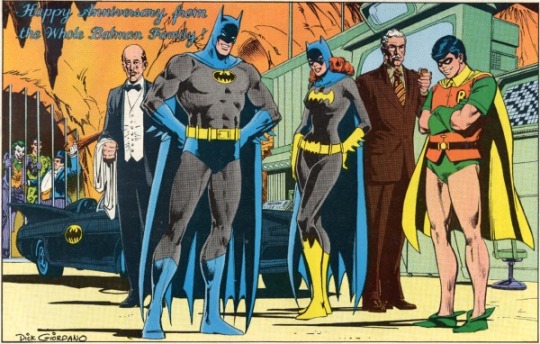
Art by Dick Giordano (late 1960s or 1970s´).
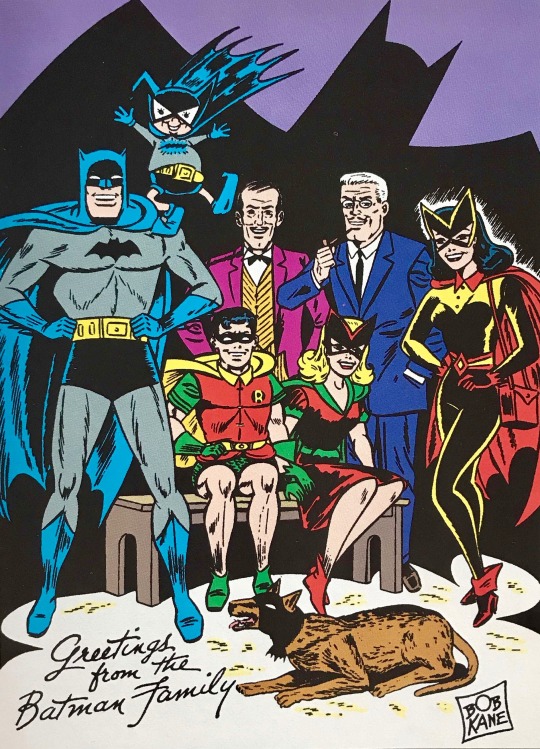
Art by Sheldon Moldoff (early 1960s).
(The date mentioned in the following list is the character’s first appearance in DC, it’s not always in connection with Batman.)

Dick Grayson (Robin, Nightwing, Batman, Agent 37). Cover date is April but the issue was released March 5, 1940 (source: heykidscomics.fandom.com)
Batman: Prelude to the wedding. Nightwing vs Hush. By Tim Seeley, art Travis G. Moore.
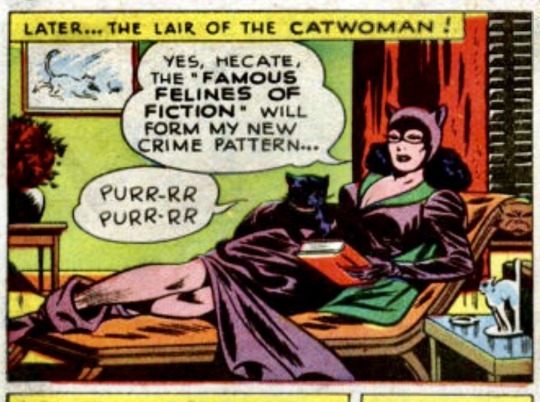
Selina Kyle (Catwoman). Spring, 1940.
”Claws of the Catwoman.” Batman # 42. By Bill Finger, art Charles Paris.

Basil Karlo (Clayface). June 1940.
Used to be a villain, but has worked with Batman’s team in Detective Comics recently.
Detective Comics # 942. By Steve Orlando and James Tynion IV, art Andy MacDonald.


Alfred Beagle/Pennyworth. April 1943.
Alfred’s first surname was Beagle. That Alfred was later explained as the Alfred of Earth-Two, the universe of the DC Golden age stories (though we have seen Golden age stories being canon in the main DC universe, too). On Earth-Two, Bruce and Selina married and had a daughter, Helena. Dick continued as Robin as an adult. Alfred was first called Pennyworth in November 1969.
”Here comes Alfred.” Batman vol 1 # 16. By Don Cameron, art Bob Kane, Jerry Robinson, George Roussos.
Nightwing vol 2 # 86. By Devin Grayson, art Patrick Zircher, Andy Owens, Sean Parsons.
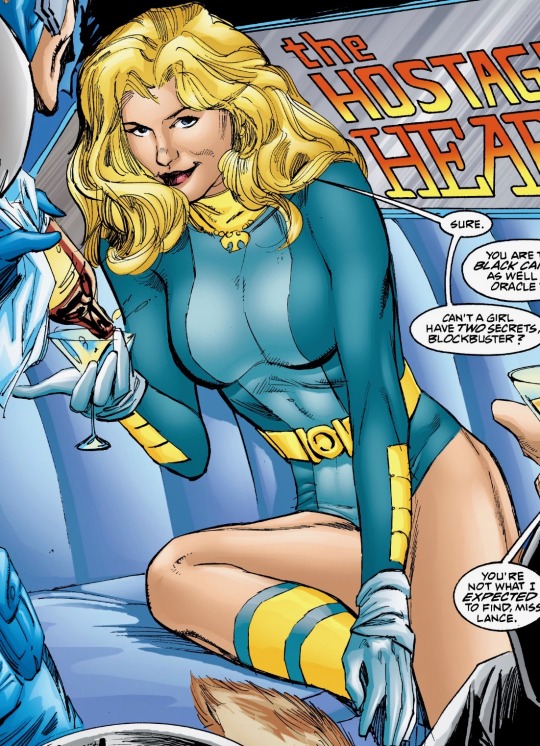
Dinah Drake Lance/Laurel Lance (Black Canary). August 1947.
Member of the Birds of Prey and Justice Leauge. The Golden age Black Canary was, at least for a while, considered the current Black Canary’s mother but I’m not sure what the story is after Flashpoint.
Birds of Prey # 22. By Chuck Dixon, art Butch Guice and Bill Sienkiewicz.
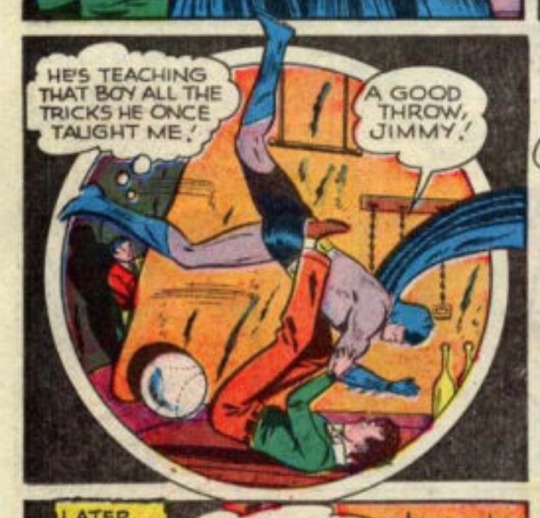

Jimmy. December 1948.
A blind boy that Batman trained in secret for one adventure, making Dick fear that he was going to be replaced.
”The Second Boy Wonder”. Batman # 50. Art Bob Kane, Lew Sayre Schwartz, Charles Paris.

Ace. June 1955.
”Ace, the Bat-Hound.” Batman # 92. By Bill Finger, art Sheldon Moldoff and Stan Kaye.

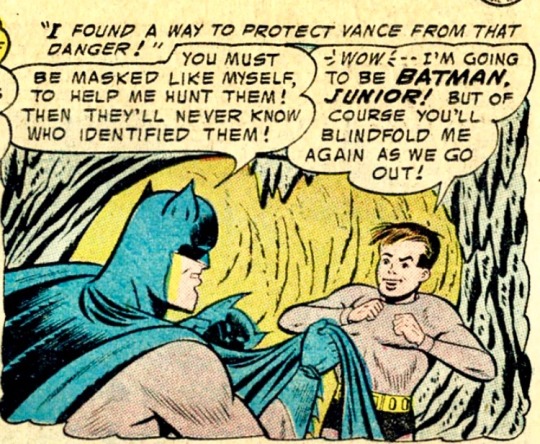
John Vance (Batman, Junior). May 1956.
A schoolboy who witnessed a crime. Since his parents were away, Batman blindfolded him and took him to the Batcave and put him in a suit to hide his identity while Batman went after the criminals.
“Batman, Junior.” In Detective Comics # 231. By Edmond Hamilton, art Sheldon Moldoff and Charles Paris.
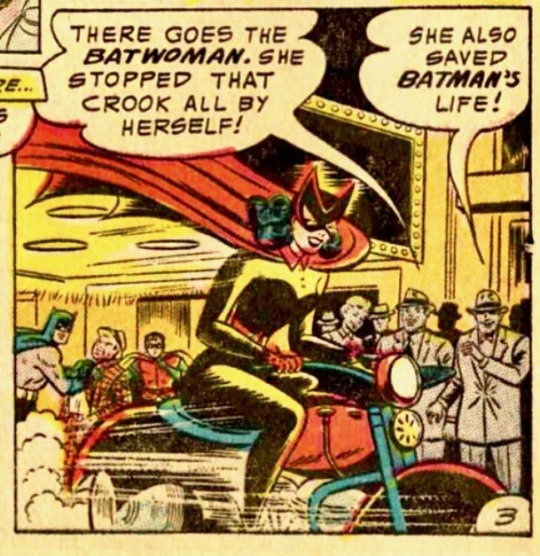
Kathy Kane (Batwoman). July 1956.
Kathy Kane has been re-installed as the original Batwoman but with a different backstory. She is related by marriage to Kate Kane.
”The Batwoman”. Detective Comics # 233. By Edmond Hamilton, art Sheldon Moldoff and Stan Kaye.
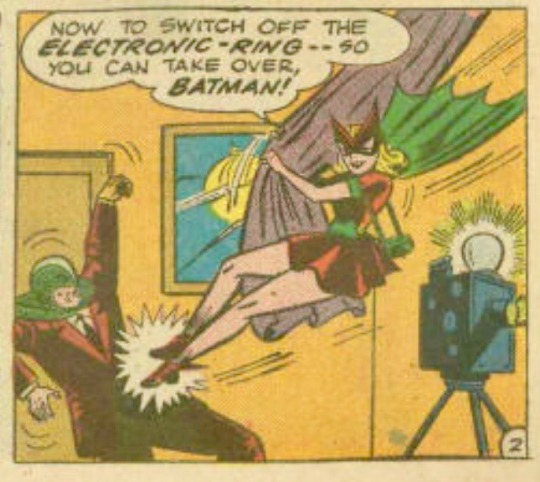
Betty Kane (Batgirl). April 1961.
Post-Crisis on Infinite Earths the original Batgirl was reimagined as Bette Kane. As far as I know, Bette was never Batgirl or worked with Batman. In different continuities, she has used the aliases Flamebird, Pleve and Hawkfire.
”Bat-Girl”. Batman # 139. By Bill Finger, art Sheldon Moldoff and Charles Paris.
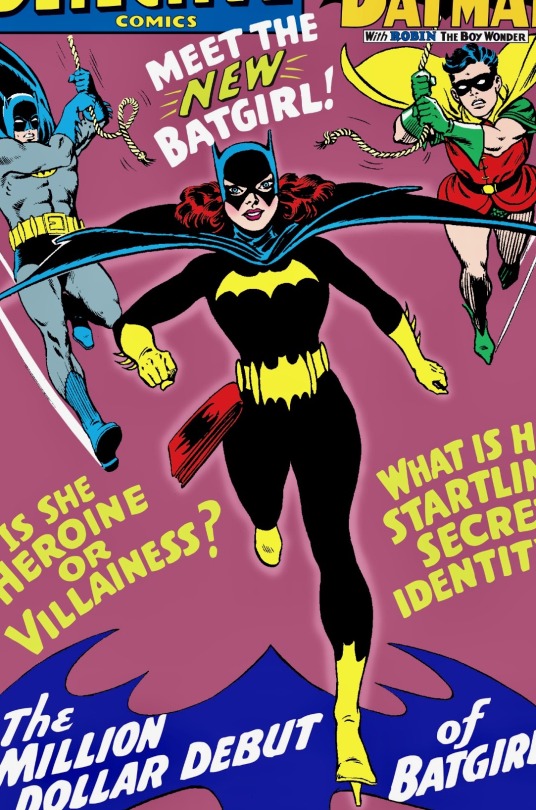
Barbara Gordon (Batgirl, Oracle). January 1967.
Detective Comics # 359. By Gardner Fox, cover art Carmine Infantino, Murphy Anderson, Ira Schnapp.
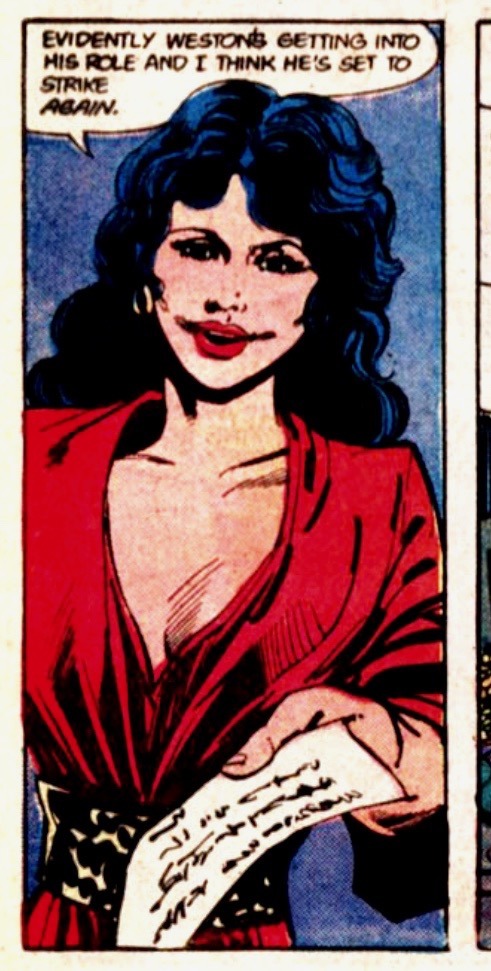
Julia Remarque/Pennyworth (Penny-Two, Tuxedo One). April 1981.
Alfred’s daughter. Pre-Crisis she was a journalist and for a while romantic interest for Bruce. After Rebirth, she was reimagined as a British reconnaissance agent who for a while coordinated the Bat-family’s work.
Batman # 395. By Doug Moench, art Tom Mandrake.
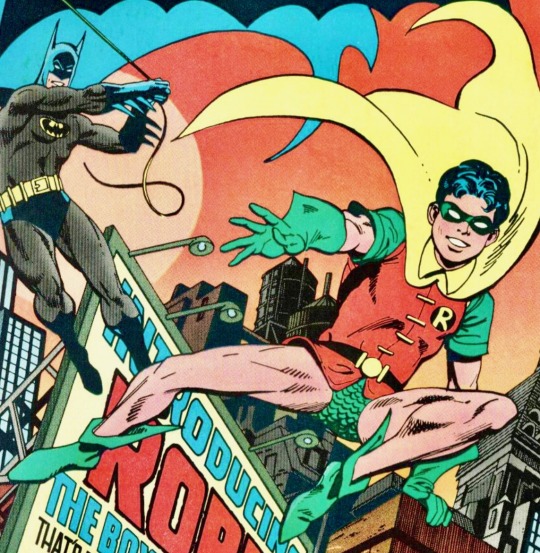
Jason Todd (Robin, Red Hood). March 1983.
Batman # 368. By Doug Moench, cover art Ed Hannigan, Dick Giordano, Anthony Tollin.
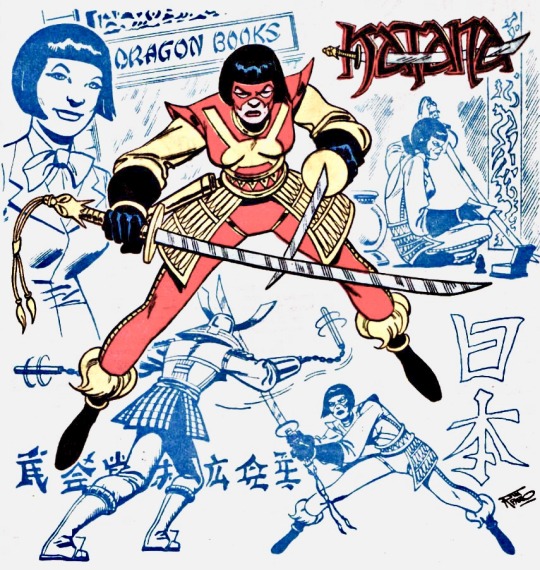
Tatsu Yamashiro (Katana). July 1983.
Sometime member of the Outsiders and the Birds of Prey.
Who’s Who: The Definite Directory of the DC Universe # 12. Art by Jim Aparo.

Onyx Adams (Onyx). January 1985.
Nightwing # 97. By Devin Grayson, art Mike Lilly and Andy Owens.
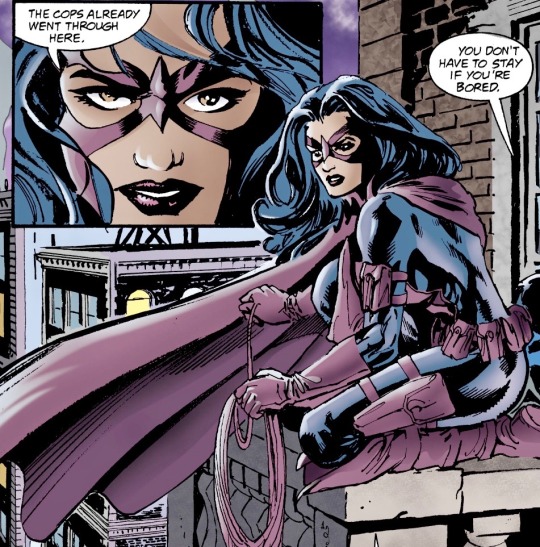
Helena Bertinelli (Batgirl, Huntress, Matron). April 1989.
When Helena Bertinelli was introduced she was based on Earth-Two Helena Wayne, daughter of Bruce and Selina Kyle, and who was wiped from existence by Crisis of Infinite Earths. The original Earth-Two Helena Wayne made her first appearance in November/December 1977; she was re-introduced in New 52 on Earth-2, one of the 52 universes in the new DC multiverse. Together with the Power Girl of Earth-2, she somehow ended up on Prime-Earth. Don’t ask me if/where she is now.
Nightwing/Huntress # 1. By Devin Grayson, art Greg Land and Bill Sienkiewicz.

Tim Drake (Robin, Red Robin). August 1989.
Robin vol 4 # 0. By Chuck Dixon, art Tom Grammet and Ray Kryssing.
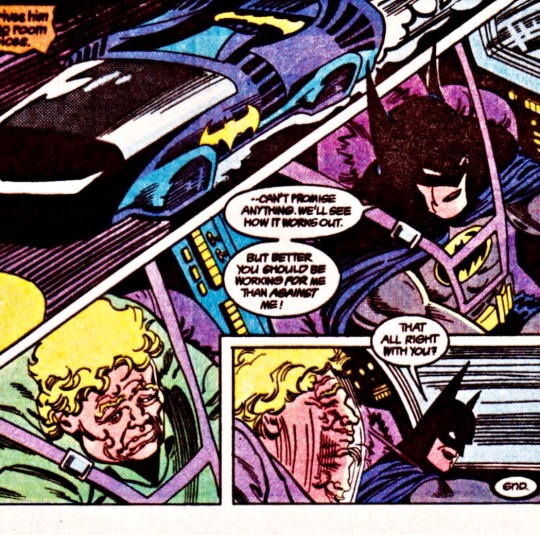

Harold Allnut. December 1989
Lived in the Batcave and served as technological aide; one of the things he designed was the fingerstripe Nightwing suit.
Batman # 458. By Alan Grant, art Norm Breyfogle and Steve Mitchell.
Nightwing vol 1 # 2. By Dennis O’Neil, art Greg Land and Mike Sellers.
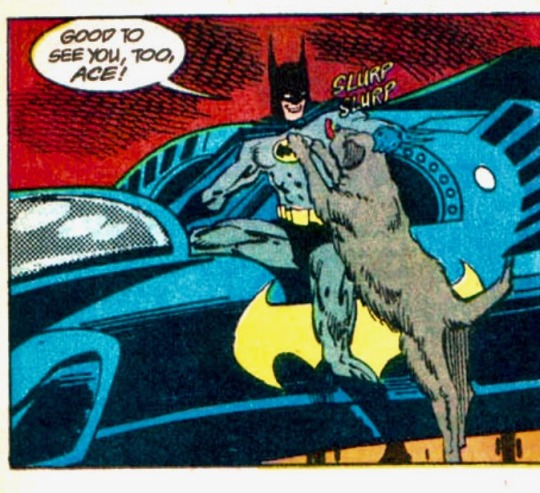
Ace. May 1991.
Batman # 465. By Alan Grant, art Norm Breyfogle and Steve Mitchell.

Stephanie Brown (Spoiler, Robin, Batgirl). June 1992.
Robin # 126. By Bill Willingham, art Damion Scott.

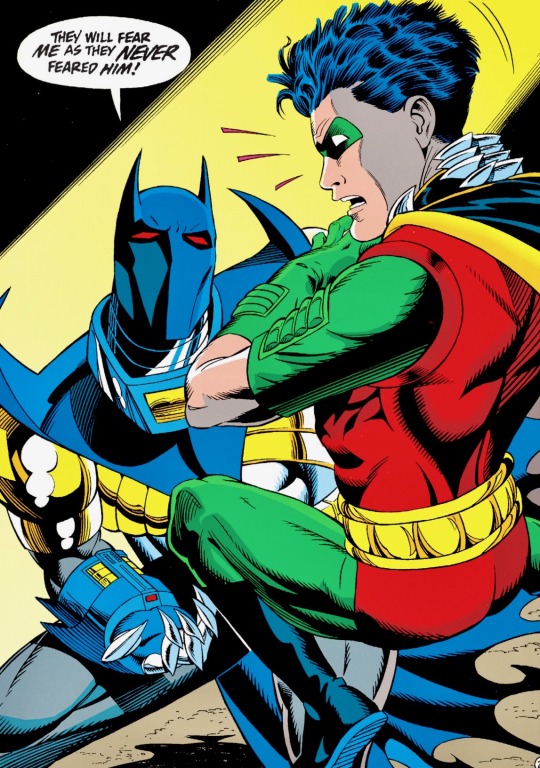
Jean-Paul Valley (Azrael, Batman). October, 1992.
Batman # 500. By Doug Moench, art Jim Aparo and Terry Austin.
Detective Comics # 668. By Chuck Dixon, art Graham Nolan and Scott Hanna.

Cassandra Cain (Batgirl, Kasumi, Black Bat, Orphan). July 1999.
Batman and Robin Eternal # 26. By Scott Snyder and James Tynion IV, art Scot Eaton, Carlo Pagulayan, Igor Vitorino, Marc Deering, Wayne Faucher, Jason Paz.
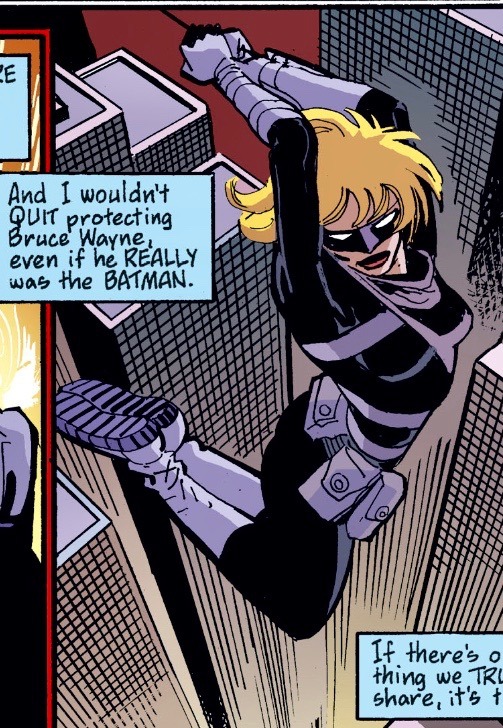
Sasha Bordeaux. (Black Kings Bishop, Black Queen). December 2000.
The 10 cent adventure. By Greg Rucka, art Rick Burnett and Klaus Janson.

Gavin King (Orpheus). October 2001.
Detective Comics # 797. By Andersen Gabrych, art Pete Woods and Nathan Massengill.

Kate Kane (Batwoman). June 2006.
Batman vol 3 # 7. By Steve Orlando and Tom King. Art Riley Rossmo.

Damian Wayne (Robin, Redbird). September 2006.
A reinterpretation of the unnamed child in the, at the time, non-canon graphic novel ”Batman: Son of the Demon” from 1987.
Batman and Robin vol 1 # 1. By Grant Morrison, cover art Frank Quitely.
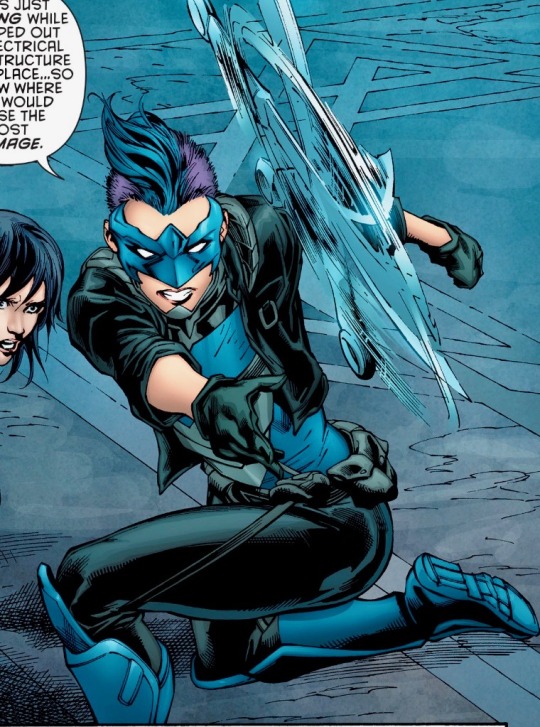
Harper Row (Bluebird). March 2012 (as an unnamed woman, September 2011).
Batman and Robin Eternal # 26. By Scott Snyder and James Tynion IV, art Scot Eaton, Carlo Pagulayan, Igor Vitorino, Marc Deering, Wayne Faucher, Jason Paz.
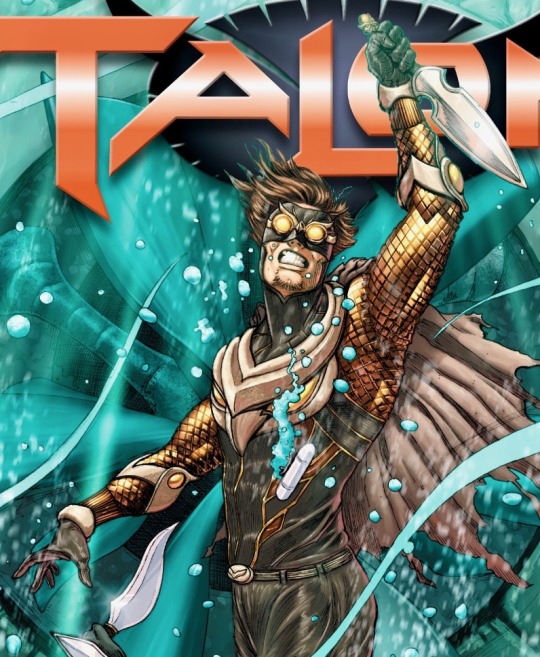
Calvin Rose (Talon). November 2012.
Talon # 5. By Scott Snyder and James Tynion IV, art Guillem March.

Luke Fox (Batwing). June 2013.
Batwing # 9. By Judd Winick, art Marcus To and Ryan Wynn.
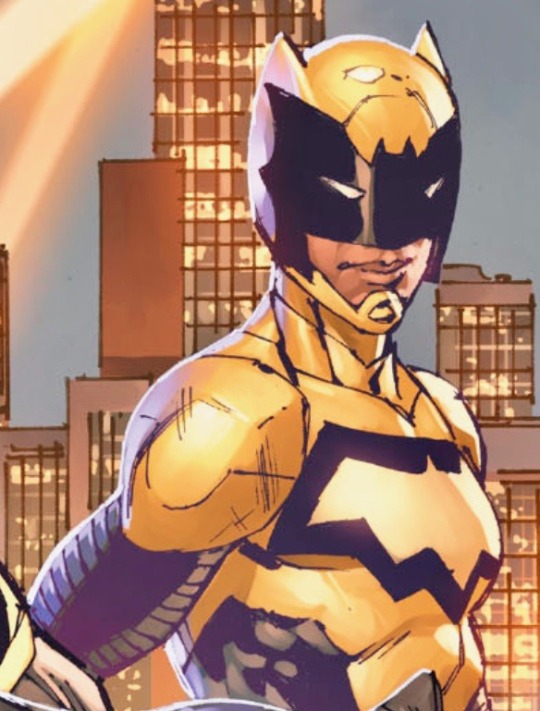
Duke Thomas (Lark, Signal). August 2013.
”Batman’s greatest case.” In Detective Comics # 1000. By Tom King, art Tony S. Daniel and Joëlle Jones.
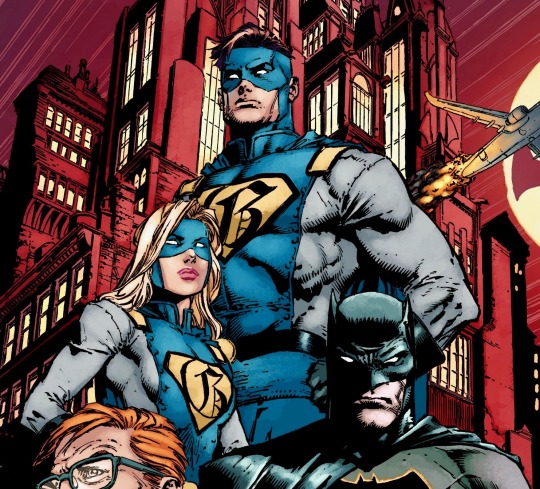
Claire and Henry Clover (Gotham Girl and Gotham). July 2016.
Batman vol 3 # 1. By Tom King, cover art David Finch and Matt Banning.
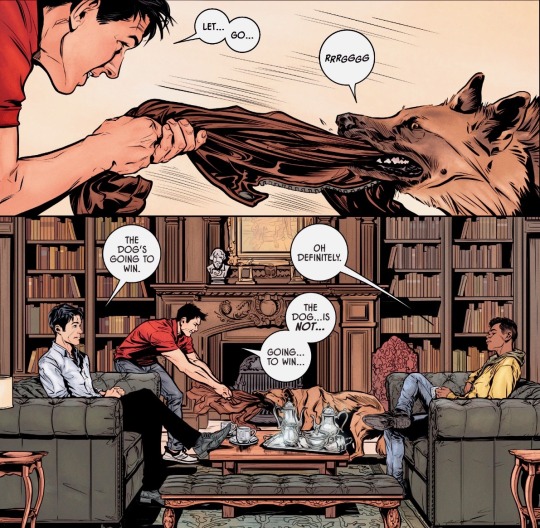
Ace. January 2017.
Batman vol 3 # 33. By Tom King, art Joëlle Jones and Jordie Bellaire.
123 notes
·
View notes
Text
Why I Think Fair Game Works
So we’re coming up on the midway point in this mini RWBY vol. 7 hiatus, and I have a serious addiction to Fair Game. With no more canon content coming out for another week (😭), I thought I’d provide some self-indulgent rambling in-depth analysis as to exactly why I think Qrow and Clover work so well together. I’ll be pulling off of what we have in the show so far (because I tend to base my ships off of canon context), but I’ll also be making some reasonable assumptions regarding Clover’s character since we don’t have a whole lot on him yet.
[Note: I’m not really trying to sway anyone with this post, so if you don’t agree or don’t like FG, feel free to scroll right on by and have a nice day. I’m all for discourse but that’s not the point of this particular post. Make your own and invite me to engage and we can have a convo.)
That being said, and without further ado, here are my top reasons for being Fair Game trash. Be forewarned, this is loooong. Damn thing turned into a dissertation.
Reason #1: Clover is a source of stability

One of the biggest criticisms I’ve seen aimed at Fair Game (aside from the more inane ones, which I will not dignify with an acknowledgment on this post) is that Qrow hates specialists. And people are right. It’s one of the first insights we get into his character in his volume 3 debut episode, right after the fact that he’s an alcoholic. I completely agree that if these two men had met in volume 3 or even 4, there is no way they would have gotten along. Clover is a soldier. A military man. He goes by the book and, in his mind, there’s not a lot of wiggle room when it comes to doing things the right way (see: his conversation with Robyn). He would have driven volume 3 Qrow up the wall, and not in a sexy way.
But the fact is, Qrow has been through a hell of a lot since then. He lost Ozpin twice (once to death and once to the lies Oz himself told), lost his way and sense of purpose because of it, almost died on multiple occasions, fell into deep emotional darkness, came under the influence of the Apathy, and had to finally acknowledge his own depression and poor coping mechanisms, or lack thereof, as a result. Shit like that changes you in deep and fundamental ways and, while I would have loved for a bit more in-show focus on this transition, I think RT gave us enough to infer the rest.
Thanks mostly to Ruby, Qrow is finally in a place where he is trying to heal for the first time since we’ve known him. He started the show as an impulsive– albeit manipulative and brilliant (see: him baiting Winter into a fight)– alcoholic who had no problem whatsoever with getting under people’s skin. The only relationships he really seemed to value were the ones he had with his nieces and with Ozpin, and everyone else could take a flying leap. Now I can’t deny that there was a certain charm to that. It’s one of the reasons I think he became such a fan favorite so rapidly; a lot of us can relate to that desire to not give a shit. But the underlying implications of that type of behavior are, I believe, pretty damn dark and serve as the earliest signs of Qrow’s depression and emotional isolation. Consider: his only functional relationships were with people who were incapable of really knowing him on a deeply personal level. Oz couldn’t because he was the one to give Qrow a purpose, thereby establishing a certain power imbalance in their relationship, no matter how close they were (I love Oz despite his mistakes before anyone comes after me for that statement and have nothing against Oz x Qrow, these are just my thoughts). And Ruby and Yang couldn’t, and still can’t, because they’re his damn nieces and being the adult in a relationship with kids means you maintain a certain distance between them and any insecurities or struggles you might have. Anything else is just not okay. He bungled that in volume 6 but he has clearly been trying to re-establish that supportive adult role in volume 7, which is amazing all by itself.
This brings us to Qrow’s emotional and mental state at the start of volume 7. Again, he’s in a place where he’s trying to heal. I don’t know how many people can relate, but that place is friggin’ terrifying because it’s the place where you have to stop lying to yourself about your problems and commit to dealing with them. But it also comes with a weird level of mental… stillness? Peace isn’t the right word, but when you’re not constantly fighting yourself anymore, you are able to breathe a little and that’s worth a lot to someone who has been trying to suffocate themselves for most of their lives. I think this has a lot to do with his shift in outlook. He’s less antagonistic because it no longer serves to feed the self-loathing monster inside him. Or rather, he’s trying to make sure he doesn’t feed it. The fact that he comes into Mantle, gets arrested for doing his job, and doesn’t immediately get in James’s face, or Winter’s for that matter, attests to the fact that he has changed. Qrow isn’t the one to call James out on the embargo or the state of things in Mantle. Instead, he steps into a role that we have never seen him in: the gentle voice of reason. He points out that James doesn’t need an entire military presence to build and launch the communications tower, and when James reveals his plans to tell the world about Salem, Qrow doesn’t outright disagree or go after him for it (as he certainly would have in earlier volumes). He simply points out that Oz spent every lifetime he had keeping that secret and then lets James explain his reasoning (flawed as it might be).
In short, all that outward anger he displayed in earlier volumes was most likely a manifestation of the self-hate storm he had brewing inside. Now that he’s decided to try to move away from that, he’s different. Of course he is. It would be completely unreasonable to expect otherwise.
Enter Clover Ebi. By sheer virtue of being who he is, Clover provides a source of stability for Qrow that he both sorely needs and has severely lacked up to this point in his life. Healing is an internal and independent process for the most part, and Qrow is going to have to sort out his issues on his own, but having someone in your life during that process who is solid is invaluable. And so far, Clover has been nothing but solid. He has been the one to pull Qrow back from bad old habits (self-deprecation and self-hate regarding his semblance). He’s been the one to take Qrow’s semblance in stride and even to get him to joke about the whole concept of having luck, good or bad, for a semblance. And so far? He’s done all of this with absolutely no strings attached. He’s not like Oz, who needed Qrow to be functional enough to carry out his spying missions, and he’s not like Ruby or Yang, who reasonably need Qrow to be solid for them because he’s their uncle. Clover is the first person who doesn’t need anything from Qrow, and so he is able to offer the type of emotional support that Qrow has never received from anyone else. They’re not even official battle partners, despite them being paired quite a bit. The lack of strings, of ulterior motives, of complicated and messy ties, and even of familial bonds, means that Clover can be the solid one. He can be a safe place where Qrow can fall apart and put himself back together if he needs to, because nothing is going to cave in if he does. Qrow won’t be putting too much weight on his nieces or on someone who relies on him for information and support. He can lean on Clover without having to worry about any repercussions.
Reason #2: Qrow is a source of disruption

Now for the fun flipside of my first point. While Clover provides a source of stability for Qrow, Qrow has the very real potential to provide a much-needed source of disruption for Clover, thereby balancing out what we have gotten of their relationship dynamic so far.
Being a military man, stringent structure and unconditional loyalty to his superiors are likely major aspects of Clover’s character. We have enough in the show so far to assume that’s accurate about him even if it hasn’t been blatantly stated.
Clover carries out his orders without fail, to the point of arresting a bunch of kids and Qrow in Mantle for operating outside of official parameters. His conversation with Robyn is also extremely telling. He doesn’t have a problem with what she wants; he has a problem with how she’s trying to get it. He doesn’t believe that the ends justify the means and, in that same vein, probably also believes that institutions are there for good reason. He is the epitome of lawful good.
Qrow, on the other hand, has never operated within official parameters. He was a spy, for god’s sake, and therefore is intimately familiar with the inherent grayness of the world. He’s not someone who is going to see things in black and white, and because of this, he could offer a sort of push back against Clover’s blind loyalty to Ironwood.
Not only is Qrow not in the military, and therefore not bound by its restrictions and dictates, but he has known James for a long time. He, more than anyone, is in the perfect position to call James out on his crap, and he’s probably the one with the best chance of actually getting through to him. Not with the same aggression and vehemence he displayed in volume 3, but with more of a tough-love approach. I fully expect this to happen at some point (and will be very sad if it doesn’t. I like James and want him to snap out of all this).
So how does this relate to Clover? Well, it forces him to acknowledge that, military or not, always trusting that the people above you are doing the right thing or the best thing is never a good way to go. He would have to step back and re-evaluate his general approach to life, which is the core of character growth. Clover never questions authority (that we’ve seen) whereas Qrow’s existence has always been in stark contrast to it. If anyone is going to act as a catalyst for Clover’s potential evolution from strict military man to a more free-thinking, free-acting individual, it’s going to be Qrow. And I think the pieces are set-up for that exact thing to happen.
Obviously, we’ll have to wait and see where CRWBY takes this one (if they take it anywhere) but the potential for growth from Clover is there because Qrow has come into his life. One of the best things couples can do is challenge each other, and these two are primed to do exactly that.
Reason #3: Opposites attract for a reason

We’ve all heard the phrase, right? Opposites attract. Sometimes I think this statement falls victim to a lot of misunderstandings so let me clarify what I mean by this. I don’t mean their chosen routes in life (rogue and spy vs. structured military man), or their semblances, or even their different combat styles. I’m talking about the complementary nature of their personalities.
Qrow has always been a bit impulsive. It’s been established that he sometimes doesn’t fully think things through, or if he does, he doesn’t care about the consequences and is willing to deal with them (see: his battle with Winter again). Don’t get me wrong. The guy is brilliant. He baits Winter knowing it will give him the opportunity to pick a fight with James as well and call him on his shit. But I’m pretty sure he also does this knowing full well that’s all he’s going to get: a fight. He’s not going to convince James not to bring the full Atlas military presence in for the Vytal Festival by shouting at him. He knows this and does it anyway. In his fight with Tyrian, you can see more than one instance where he’s planning his moves so his semblance has the chance to work on his opponent, but it’s at the risk of his own safety as well (see: the roof stunt). There are plenty of other examples throughout the show. Qrow runs off instinct and momentum.
Clover, on the other hand, strikes me as someone who exercises a bit more caution in his life. He thinks through a situation before he steps into it and overall just seems a little slower to take action. This is true in combat situations, as the whole mine mission was meticulously planned out beforehand. You can also see this approach mirrored in the way the Ace Ops work on the whole. Vine and Elm definitely don’t rush in when they encounter Grimm in the mine, and while Marrow and Harriet might be a bit faster to go after the main target, they don’t do it without a fully formed plan. It’s not foolproof, obviously. Marrow does cut off that piece of Dust with no one there (that he knows of) to catch it, but the point is still valid.
This tendency to go slow and feel his way is also true in Clover’s personal life. In the truck scene, you can see him watching Qrow while he talks, gauging his reactions, trying to find the best way to reach him. Nothing he says is mere chitchat. It’s all meant to pull Qrow into a conversation, which Clover tries to keep focused on Qrow himself. His opener might be Ruby but he ditches that line of thought as soon as Qrow gives him the opening to do so and shifts his attention to where he really wants it to be: getting to know Qrow.
Then you also have Qrow’s penchant for falling into dark mental places balanced against Clover’s good mood and playfulness; Qrow’s willingness to be a little more open with his emotions and Clover’s tight emotional control; the fact that Qrow feels things fully and deeply while I suspect that Clover might have emotional walls he hasn’t learned how to lower yet; Clover’s ability to follow orders and Qrow’s ability to question. And that’s all out of only 3-ish minutes of total interaction between them so far. I think as the volume goes, we’ll only get more insight on the ways in which they balance and round each other out.
Reason #4: Shared semblances

So this has been the biggest kicker for people so far, and I’ve seen it as a point both in favor of and against FG. Some people theorize that Clover’s semblance might have some balancing effect on Qrow’s, making it much safer for Clover to be around him than it is for others. Others think that it might be more of a trade-off: good luck part of the time and bad luck the other part (I’m in favor of this). And yet others seem to see Clover’s semblance as a negative thing for Qrow, somehow dampening his own semblance or countering it to the point that it’s mentally or emotionally detrimental for him. I personally don’t quite see the logic behind this given what we’ve seen so far, but I’ll just make my point and get out of this debate because the truth is that we still don’t quite know how their semblances function together.
What we do know is that they are two sides of the same coin, and as such, are not nearly as far apart as they might have seemed at first. They both carry around luck semblances, which I assume is pretty damn rare. Almost every other semblance we have seen has existed more in the practical realm (Yang’s damage absorption, Blake’s shadow self, Weiss’s glyphs, Ruby’s rose petal thing, Marrow’s ability to slow time, Tyrian’s ability to rip through Aura, etc. etc. etc.) And then we have these two who operate in the realm of chance, something intangible and completely unpredictable. They are fairly unique in the RWBY-verse in this sense, and uniqueness usually breeds a certain degree of separation.
A ton of theories are floating around about how Clover’s semblance has affected him throughout his life. I’ve posited a few myself. We obviously have no idea what the canon backstory for Clover is, and while I do think it’s pretty safe to assume that while Qrow has dealt with ostracization because of his semblance, Clover might have experience with some sort of idolization or even over-reliance (which can be damaging in its own right) because of his, there isn’t a whole lot we can speculate on without more information.
So where does that leave us? With the scene depicted above. Regardless of how their semblances might play off each other or what these two have suffered (or enjoyed) as a result of them, one thing is certain: they understand one another. Qrow may not know what it’s like to be able to draw good luck to himself, but he knows what it’s like when his semblance does work in his favor and screws over an opponent. Clover, by the same token, probably doesn’t understand what it’s like having to constantly watch out for misfortune, but he most likely does know what it’s like to have his semblance flip on him and give the edge to his opponent. Additionally, them both having such similar semblances means that learning to look for signs of each other’s being at work won’t be much of a stretch for them. They would be able to adapt pretty fast to working together. Note, I’m assuming their semblances function in the same way and that Clover has no more control over his than Qrow does because it just makes narrative sense.
This puts them in the unique position of being together in their semblances, even if they’re on opposite ends of the spectrum. Qrow has not exhibited any jealousy or bitterness towards Clover because of his semblance, and Clover sure as hell hasn’t put any distance between them out of concern for Qrow’s semblance. They get each other, and after only half a season, they have developed a level of comfort with one another that already allows them to joke about it. An inside joke that no one else could possibly understand. And that is some powerful shit for two people who have potentially (one person we know for certain has) been isolated in one way or another because of their semblances throughout their lives.
Reason #5: Clover is new
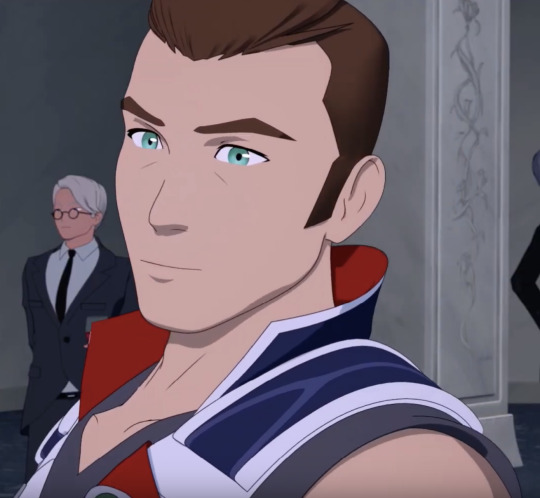
Okay, if anyone partial to a different Qrow ship has somehow made it through this monster of a post, you might want to skip this bit. Because I’m going to make an argument for why bringing in a new character to be Qrow’s love interest is actually a good idea. This is not to hate on I//ronqrow or S//nowbird or any other popular Qrow ship, but it might annoy the shit out of you so… fair warning. I’ll keep it brief, though.
I think Qrow getting involved with someone who he has no past connection to would be insanely good for him. When it comes to James or Winter or, really, anyone else who knew him before this volume, there is a lot of baggage there. And I mean a lot. At this point in his life, Qrow is dealing with enough of his own internal shit that throwing external interpersonal baggage on top of that probably wouldn’t help him in any way. Sometimes, you just need to start over somewhere (especially when you’re trying to pick up the pieces of yourself and figure out how they go together), and Clover offers Qrow the perfect opportunity to do that. There are no preconceptions that Qrow has to deal with, nothing he has to make up for or prove. Clover won’t be hovering over him anticipating a relapse or using his past behavior to interpret his current actions, or wondering why he’s changed, or holding things against him. He can figure out who he is now without the pressures of who he was hanging around his neck. And that, like so many other things these two have going for them, is unbelievably powerful.
Reason #6: They already have the nonverbal thing down

This one is more for funsies than anything, but come on. They’re already communicating non-verbally?
It took me a while to pinpoint that expression on Clover’s face but I finally got it: his brows don’t lower in annoyance or anger. They furrow: the universal sign of concern. What exactly he’s worried about, I’m not completely sure. It could be any number of things at this point, from a hint that he’s not totally supportive of this particular order he’s getting (bringing Robyn into custody) to a concern that he and Qrow might be approaching a clash point (not so far, though if Qrow is going to be the disruptive force Clover needs, that point is probably coming). Either way, this look speaks volumes. I’m just not entirely certain how to read it yet.
But in the interest of keeping up on the analysis, note his answer to James. It’s not a “yes sir” or a “whatever you say, sir”. He says “we’ll figure it out”. Qrow looks at him and only then does Clover shoot him that sideways glance thing. Is he making it clear that he means to include Qrow in this? That he wants Qrow’s help? That he knows they’re all in a crap situation but the Amity project is stalled and they need to try something so they should at least try this? They’re communicating something here and just because I don’t know what it is yet doesn’t mean this is any less significant in terms of their relationship. This kind of thing only happens when you click with someone and these two definitely click.
Bonus: They’re just so damn cute together
If you made it through that nonsense, congratulations! Have some Fair Game goodness as a reward. These two are adorable together and you will never convince me otherwise:
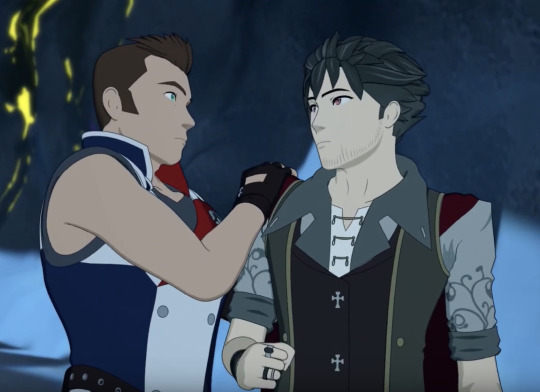


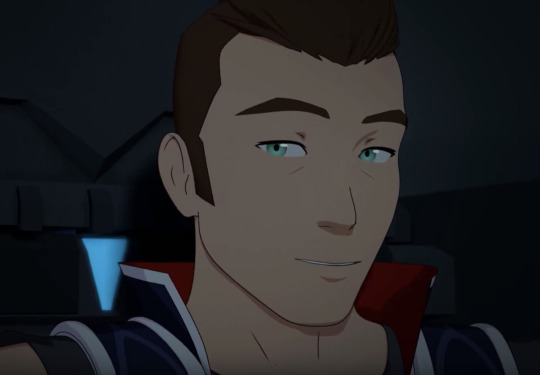


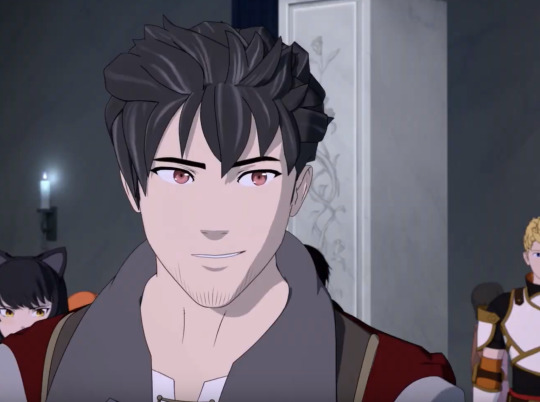

#fair game#qrow branwen#clover ebi#lucky charms#fairgame#rwby7#rwby#holy shit this became a thing#it's seriously a behemoth of a post#enter at your own risk#cute pictures at the end#analysis#maybe a little too much#i don't care this was fun#took me all afternoon but whatever#enjoy!!!
479 notes
·
View notes
Text
Sun Wukong's Buddhist Paradise
Some of my followers may be familiar with my past article in which I described Xuanzang's historical itinerary and discussed what a more realistic Journey to the West might be like. Towards the end, after the pilgrims return to China with the scriptures and the disciples (Sun Wukong, Zhu Bajie, and Sha Wujing) receive their elevation in spiritual rank, I stated: “They would thereafter leave to enjoy their divine lives in the Western Paradise.” But I’ve never really liked the idea that Monkey would forever abandon his people. This is especially true since his rebellion led to heaven decimating the monkeys and burning their cave (Wu & Yu, 2012, vol. 2, p. 31).
I think a better ending for this historical version would be for the “Victorious Fighting Buddha” to return to the Mountain of Flower and Fruit, where he transforms it into his own Pure Land (Jingtu, 淨土). The monkeys killed in years passed would be reborn there, and everyone would receive periodic lessons on the dharma between bouts of play. It would be a paradise even grander than when the Great Sage was at the height of his power.
Here is some information about pure lands from the Encyclopedia of Buddhism (Gomez, 2004):


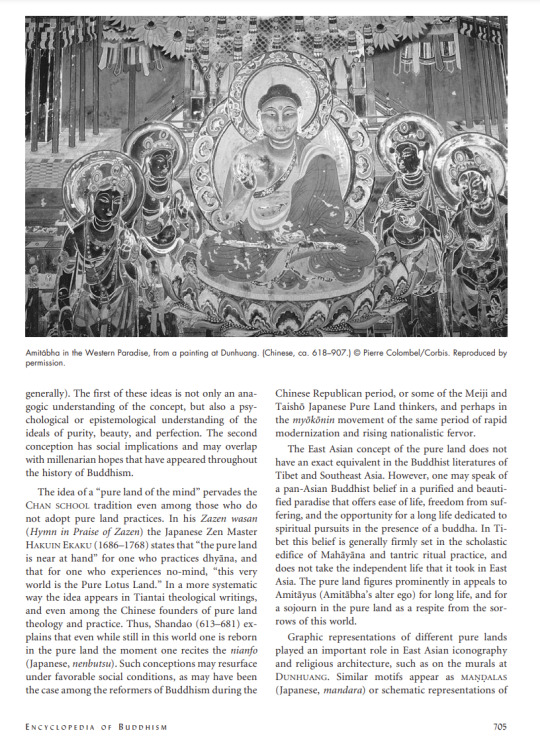
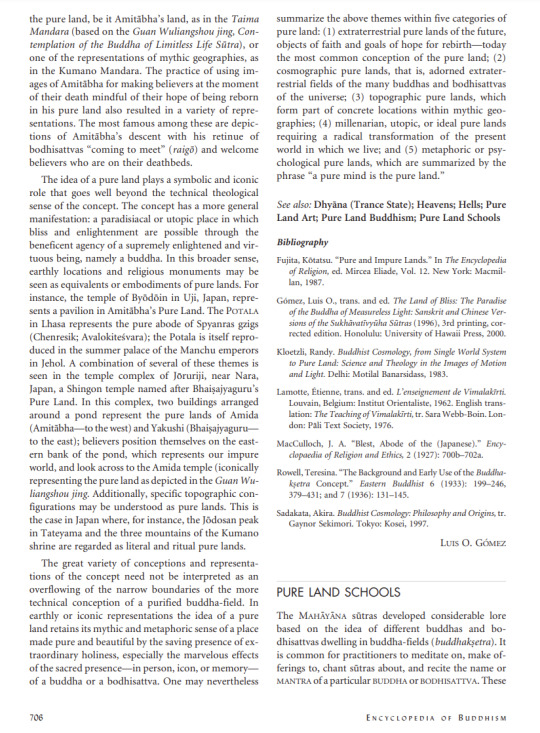
I love this circa 1700 Tibetan painting of Amitabha in his pure land of Sukhavati. Just imagine the Victorious Fighting Buddha sitting in Amitabha's place, and monkeys would take the place of the monks, protectors, and devas.

Sources:
Gomez, O. L. (2004). Pure Lands. In R. E. Buswell (Ed.), Encyclopedia of Buddhism (pp. 703-706) (Vols. 2). United Kingdom: Macmillan Reference, USA.
Wu, C., & Yu, A. C. (2012). The Journey to the West (Vols. 1-4). Chicago, Illinois: University of Chicago Press.
#sun wukong#monkey king#journey to the west#buddhism#Pure land#amitabha#Victorious Fighting Buddha#Buddha Victorious in Strife#Lego Monkie Kid#LMK#JTTW#dharma
85 notes
·
View notes
Text
2020 Music Recommendations
2020 – WHAT A SHIT YEAR! There was so much craziness in those 365 days – from politics to a pandemic. Music was often times one of those things we could take comfort in or use it as a tool to express a range of emotions. I’m always surprised when compiling these list (of which I’ve been doing for 20+ years now it seems) that no matter the state of the world, there is always an overabundance of great music to be discovered. 2020 musically, delivered - including surprising returns from some bands who’ve been rather quiet in the past years like Consolidated, Cabaret Voltaire, and Portion Control.
The majority of what I listen to is electronic based music, with techno-body music being my favorite and there was STILL PLENTY of that in 2020 from labels like Aufnahme+Wiedergabe, Fleisch, Bite, X-IMG, Sonic Groove, SOIL, and more. Occasionally something a little lighter like the ethereal shoe-gaze goodness of Mint Julep (“Stray Fantasies” was an amazing record), or the post-punk of House of Harm (wonderful new discovery this year with “Viscous Pastimes”) and Sure (you all slept on “20 years” in 2020) works its way in to my listening. I still find synth pop from the likes of Riki, Korine, Tanz Waffen and Wingtips wonderfully appeasing. The wave material from the likes of Handful of Snowdrops, Linea Aspera, Zanias, Hante., Minuit Machine and Replicant was perfect for those melancholy moods. I even dipped into some aggressive near metal stuff this year from the likes of Pudeur, ESA and Youth Code – perfect for those days of anger. Oh, and I was thrilled to see a lot of exclusive, unreleased and remixed Curve material surface this year – a band who embraces several genres (walls of guitar, shoe gaze, industrial) and moods.
This isn’t a top 10, top 25 or even a top 100. Instead, it’s an A-Z recommendation list encompassing many genres as those lines are getting more and more blurred. A good tune is a good tune, regardless of genre.
HIGHLY encourage you to get out there and seek out new music; Visit the record stores, go hear a new DJ, fire up Spotify or another streaming service, check out some new music via podcast, DJ mixes, label sites, online retailers, even Facebook. One of the best sources for discovering new music is BandCamp - who in 2020 with the pandemic started BandCamp Fridays in which the site waived its normal fees to assist artist impacted. Taking place, the first Friday of every month, those will continue in 2021. There’s a plethora of discoveries to be found out there. If you do the work, you’ll be rewarded ;) Speaking of Spotify – I made a playlist this year featuring plenty of the bands on my list. There’s at least a track or more from the artist who have a presence on Spotify. Sadly a few bands on this list aren’t on the platform, but check BandCamp and you can have a listen. Here’s the link: https://open.spotify.com/playlist/02kQJZE7uvJxwHJD8j8zrh?si=SHlP4mVRTuaRejh6So3Mig
As in years past I’m certain I missed a few things, ignored the hype on certain releases or just plain forgotten something. It’s a chore to compile this list, but I love to do it. There’s a ton of new pioneering music out there for sure waiting to be discovered and it’s the “what’s next” that keeps me a motivated music fan. There’s never a dull moment in speaking, writing, DJ'ing or promoting new music, so I’ll keep doing it and hopefully be a guide for you all ;). If it needs mention and I overlooked it - I may do an addendum in the next week or so. Anyways, got your notepaper and plenty of beverages ready? Don’t be a TL:DR (Too Long: Didn’t Read) fool. Read up. Enjoy the music of 2020!
Onwards with the list!!! :D
2+2=5 - “Hidden In Plain Sight “ (COUP)
Absolute Body Control - “1980/2020” 3xLP (Oraculo Records)
Agent 15 - “Voices In My Head” (Drone)
Ah Cama-Sotz - “New Skin for Old Tribals “ (Self-released)
Andi - “Corpse to Corpus” 12” (Aufnahme+Wiedergabe)
Arabian Panther - “The Way of the Pentinent” EP (SOIL)
Arnaud Rebotini – “Workout: This is a Quarantine EP6” (Self-released)
Autumns - "You Always Taught Me Better" LP (Detriti Records)
Benedek - “Mr. Goods” 12” (L.I.E.S.)
Blac Kolor - “Extinction” EP (Aufnahme+Widergabe)
Blacksmith - “Dominated” (X-IMG)
Blitzkrieg Baby - “Remixed” (Aufnahme+Wiedergabe)
Blush Response - “Void In” LP (Megastructure) - “Void Out” (Megastructure)
Body Beat Ritual - "Raw Dogs” EP (Pleasure Corp)
Body Divide - “Pleasure From Pain” (Squarewav)
Cabaret Voltaire - “Shadow of Fear” LP (Self-released)
Calvary Stone - “Hate Unit” (Soil)
Caustic - “The King of EBM” (Self-released)
Cervello Elettronico - “No Sides” EP (SquareWav)
Choke Chain - “Chain Tactics” (Self-released) - “Grave” (Self-released)
Chris Shape - “Shaped to Deform” (Unknown Pleasures Records)
Chrome Corpse - “Detecting Movement” Ltd. Edition 12" EP (Oraculo Records) - “Helmet Mounted Display” (Self-released)
Chrome Corpse / Decent News - “Split” (Self-Released)
Codex Empire - “Broken by Fear" Ltd. 12” (Horo) - “Protected by Rage” 12” (Aufnahme+Wiedergabe)
Cold Cave - “Waving Hands” (self-releaesed)
Comfort Cure - “Serpentine City” (Rec.Body.Ltd)
Consolidated - “Capitalism” (Self-released)
Crystal Geometry - “Samiam” EP (Sacred Court) - “Senestre” 2x12” (Sonic Groove)
Curve - “Blindfold EP - Bootleg EP Series 1” (Self-released) - “Curve Oddities Bootleg Series 3” (Self-released) - “Curve Oddities Bootleg Series 5” (Self-released) - “Horror Head Raw DAT Mixes Bootleg Series 4” (Self-released)
Cyan ID - “Blurred Revelation” (X-IMG)
Dive - “Where Do We Go From Here” Ltd. Ed Box set (Out Of Line)
E.L.I. - “Dying to Live” (SOIL)
E.S.A. - “Burial 10” (Negative Gain Productions) - “Eat Their Young / The Scorn” (Negative Gain Productions)
Einstruzende Neubauten – “Alles In Allem” (Potomak)
Evil Dust - “Desolation” (Crave Tapes)
Fatal Morgana - “The Destructive Remixes” 12" (Mecanica Records) - “The Final Destruction” 2LP (Mecanica Records)
Filmmaker - “Reinvent” 12” (Soil records)
Fixmer - "Invasion” 12” (Bite)
Fixmer/McCarthy - “Unreleased From the Archives" (Planet Rogue Records)
Foreign Policy - “Watching Existence” 12” (X-IMG)
Fractions - “Nite NRG” (Monnom Black)
Further Reductions - “Array” 12” (Knekelhuis)
Hakai – “No Flesh Shall Be Spared” 12” (Megastructure)
Halv Drom - “Slum Vatic” LP (Fleisch)
Handful of Snowdrops - “Asymetrical” (NanoGénésie®) - “Echoes -The Complete Cover Collection” (NanoGénésie®) - “The Four Winds” (NanoGénésie®) - “The Impossible Dream” (NanoGénésie®) - “Watch Me Bleed / Theme for Great Cities” (Self-released)
Hante. - “Fierce - Remixes & More” LP (Synth Religion)
HKKPTR - “Macht & Ohnmacht” EP (Aufnahme+Wiedergabe)
House of Harm - “Vicious Pastimes” LP (Avant!)
Human Performance Lab - “Impact Situation” 12" (Aufnahme+Wiedergabe)
Inhalt - “Simulation” 2xLP Remixes (Mechatronica)
Iron Court - “Etched Forseights” (Detriti)
Istigkeit & Angel Karel - “You A’Int No Punk, You Punk” (RND. Records)
IV Horsemen - “Compilation Vol. 1” (Self-released) - “Human Crash” LP (Fleisch)
Karger Traum - “III” LP (DKA Records)
Kenny Campbell - “Blackest Ever Buckfast” (Drone)
King Dude - “Full Virgo Moon” LP (Van)
KLACK - "Two Minute Warning” (Klackprodukt) - “Move Any Mountain” (Self-released) - “Catching Up with Klack” (Razgrom) - “Distancing” (Self-released) - “Move Any Mountain” (Self-released) - “Probably” (Klackprodukt)
Konkurs - “Terminal Stage" (Megastructure, X-IMG)
Kontravoid - “Live from the Void” (Self-released) - “Too Deep Remixes” (Fleisch)
Korine - “The Night We Raise” LP (Data Airlines)
Kris Baha - “Barely Alive” 12” (Emotional Especial) - “Starts to Fall” 12” (Power Station)
Kutkh Jackdaw - “Sweat & Thunder EP and remixes” (Dark Disco)
Lbeeze - “Induced Expressions” (Phormix Tapes)
Liebknecht - “Demos The H4AR 2020" (Self-released) - “Koln : Total Harmonic Noize remix” (Self-released)
Linea Aspera - “LP II” (Self-released)
Looky Looky - “Are You There Beach?” (Self-released)
Machino - “Ciudad Violenta” (X-IMG)
Maedon - “Escape To Berlin" (Sonic Groove)
Marc Ash - “Mirror Glaze Lavish" 12" EP (Fleisch)
Marina Aleksandra - “Animal Industrial Complex” (Randolph & Mort. mix)
Max Durante - “Fear and Desire” 12” (Aufnahme+Wiedergabe)
Mind | Matter – “Souvenirs Brises” (Intervision)
Mint Julep - “Stray Fantasies” LP (Western Vinyl)
Minuit Machine - “Don’t Run From the Fire” 12” (Synth Religion)
New Frames - “Outer Limits” 12” (Bite) - “RNF2” 12” (R Label Group) - “Stylized Fear” 12” (Haven)
Nordstaat - “Singularity Second Coming” (X-IMG)
NZ - “More Of Us” 12” ltd. (Infacted Records)
Objekt Clermont - "Zeitgeist” EP (Self-released)
Ofelia Ortodoxa - “Maleficio” (Soil)
Pablo Bozzi - “Last Moscow Mule” (Dischi Autunno) - “Walk on Wire” EP (Bite)
Phase Fatale - “Scanning Backwards” 2xLP (Osgut Ton)
Portion Control - “Head Buried” EP (Portion-Control.Net) - “Seed 1” EP (Portion-Control.Net) - “Seed 2” EP (Portion-Control.Net)
Pudeur - “Magie Noire” (Area Z)
Randolph & Mortimer - “Enjoy More” 7” (Self-released) - “Manifesto for a Modern World” 2xLP (Mecanica) - “They Know We Know They Lie” (Self-released) - “Union of the Faithful” (Self-released)
Reka X Imperial Black Unit - “Todo Avaricia” 12" EP (Fleisch)
Rendered - “Stone Cold Soul” CD (Audiophob)
Replicant - "Regression” (Self-released) - “Annihilation” (Self-released)
Rhys Fulber - “Diaspora” EP (Aufnahme+Wiedergabe) - “Resolve” (FR Recordings)
Riki - “Riki” LP (Dais Records)
Rommek - “Break The Tension” 12” (Leyla Records)
Salem Unsigned - “Blood Origin” (RND.r recorcds)
SARIN - “Moral Cleansing Remixed" (Bite)
Schwefelgelb - “Der Puls Durch Die Schläfen Instrumentals" (n-Plex) - “Der Puls Durch Die Schläfen" (n-Plex) - “Die Stimme Drängt” 12" (Cititrax)
SDH - “Against Strong Thinking" 12" (Avant!)
Size Pier - “Typhoon in Busan” (X-IMG)
Soft Crash - “Spitzkrieg” 12” EP (Bite)
Soj - “Land of Lovers and Hammers” (Infidel Bodies) - “Slow Burn” (Industrial Complexx)
Statiqbloom - “Asphyxia Remixed” (Synthicide)
Sure - “20 Years” LP (Weyrd Sun Records)
T_ERROR 404 - “Holographic Skull” (X-IMG)
Tanz Waffen - “Led Astray” (Self-Released)
Teatre - “Crime Imagery” (Self-released)
Terrorfakt - “Achtung 2020 Remixes” (SquareWav)
The Marquis - “Poison” (Self-released) - “Scab” (Self-released)
Trauma Phase - “Human Caused Disaster Response” (Detriti) - “The Origin of Social Disabilities” (Self-Released)
Unconscious - “Regnum Novum” (X-IMG) -"Slaves of System" LP (Detriti)
Unhuman - “Voices of Distress” 12” (Bite)
Various Artisits - “ASM II “ (Forkha) with: Chrome Corpse, Mind|Matter, The Undertaker’s Tapes, Evil Dust and more
Various Artist - “Meta Moto 4” (Meta Moto) with: Borsis Barksdale, Raw Ambassador, Filmmaker, Teatre and more
Various Artist - “Antikhrist Visions vol. II” LP (Industrias Mekanikas) with: Downwell, Delectro and more
Various Artist - “BOY Records – Timeless Technology 1988 – 1991" 4xLP (Mecanica) Retrospective box of the legendary Boy label releases.
Various Artist - “Crime Violente Vol.4” (Up North Records) With: Calvary Stone, Lbeeze, Meshes and more
Various Artist - “Dystopia in Action” 12” (X-IMG) with: Alpha & Necromante, Kris Baha, Human Performance Lab and more
Various Artist - “Ecdisis Vol 2” (Frigio Records) Snag this for the outstanding edit of Portion Control’s “Chew You to Bits”
Various Artist - “Murder 01” 12” (Murder) with: Codex Empire, Crystal Geometry, JK Flesh and more
Various Artist - “Northern Nightmares Vol.1” (Up North Records) with: Autumns, Cardopusher, Teatre, Hate Magnum Opus and more
Various Artist - “Northern Nightmares Vol. 2” (Up North Records) with: Notausgang, NGHTY, Violet Poison and more
Various Artist - “Sonic Groove: 25 Years 1995-2020" 2xLP (Sonic Groove) with: Orphx, Crustal geometry, Maedon, Rhys Fulber & Portion Control and more
Various Artist - “Uncanny Valleys Vol. 1” (Area Z) with: Chrome Corpse, Sarin x Imperial Black Unit, Celldod, IV Horsemen and more
Various Artist - “Uncanny Valleys Vol. 2” (Area Z) with: Ah Cama-Sotz, 3.14, MDS51 and more
Various Artist - “Valley of Tears vol 1" 12” (Soil) with: Imperial Black Unit, Fractions, Exhausted Modern and more
Various Artist - “Valley of Tears Vol. 2” 12” (Soil) with: SOj, Djedjotronic, Years of Denial and more
Various Artist - “Seven Years of Delirium" (Liber Null) with: Blush Response, NGLY, Zanias, Celldod, Phase Fatale and more
Various Artist – “Detriti Split 1” 12” split vinyl (Detriti) with: Black Sun Dreamer and Trauma Phase
Various Artist – “Detriti Split 2” 12” split vinyl (Detriti) with: Mind | Matter and Iron Court
Visceral Anatomy - “Modern Anguish” EP (Oraculo Records)
Visitor - “Technofossil” (Braid Records)
Wingtips - “Tears Of Pearls" (Self-released)
Youth Code - “Puzzle” (Self-Released)
Zanias - “Extinction” 12” (Fleisch) - “Harmaline” (Self-Released)
Zola Jesus - “Live at Roadburn” (Roadburn Records)
2 notes
·
View notes
Text
Episode 369
December 2022 Solicits
Comic Reviews:
DC
Batman vs. Robin 1 by Mark Waid, Mahmud Asrar, Jordie Bellaire
Dark Crisis: Worlds Without a Justice League – Wonder Woman by Tini Howard, Dan Watters, Brandon Peterson, Leila Del Duca, Michael Atiyeh, Jordie Bellaire
Flash: Fastest Man Alive 1 by Kenny Porter, Ricardo Lopez Ortiz, Romulo Fajardo Jr.
Batman: Knightwatch 1 by Joseph Torres, Erich Owen, Carrie Strachan
Marvel
A.X.E. Judgment Day 4 by Kieron Gillen, Valerio Schiti, Marte Gracia
Edge of Spider-Verse 3 by Dan Slott, Zack Davisson, Sanshiro Kasama, Nikesh Shukla, Mark Bagley, Paco Medina, Gerardo Sandoval, Sumeyye Kesgin, David Baldeon, Hikaru Uesugi, Abhishek Malsuny, Brian Reber, Andrew Crossley, Erick Arciniega, Israel Silva
Midnight Suns 1 by Ethan Sacks, Luigi Zagaria, Antonio Fabela
Image
Bone Orchard Mythos: Ten Thousand Black Feathers 1 by Jeff Lemire, Andrea Sorrentino, Dave Stewart
Least We Can Do 1 by Iolanda Zanfardino, Elisa Romboli
Silver Coin 14 by Pornsak Pichetshote, Michael Walsh
Dark Horse
Castle Full of Blackbirds 1 by Mike Mignola, Angela Slatter, Valeria Burzo, Michelle Madsen
Maskerade 1 by Kevin Smith, Andy McElfresh, John Sprengelmeyer, Giulia Brusco
Dynamite
Vampirella: Mindwarp 1 by Jeff Parker, Benjamin Dewey, Dearbhla Kelly
IDW
Star Trek: Lower Decks 1 by Ryan North, Chris Fenoglio
OGN
Supper Club by Jackie Morrow
Birdking by Daniel Freedman, Cristian Ortiz
Phenomena by Brian Michael Bendis, Andre Lima Araujo
Comixology
Census 1 by Marc Bernardin, Adam Freeman, Sebastian Piriz
AfterShock
The 06 Protocol 1 by Lee Turner, Cliff Richards
Ablaze
Lovecraft: Unknown Kadath 1 by Florentino Florez, Guillermo Sanna, Jacques Salomon
Mad Cave
Lower Your Sights
Vault
Revealer 1 by Michael Moreci, Tim Seeley
Ray’s OGN Corner: Ride On by Faith Erin Hicks
Additional Reviews: Kate, She-Hulk ep5, Cover, House of Gucci, Korra s3, Samurai Rabbit s2
News: Rosenberg and Williamson launching Substacks, Scarlet Witch by Orlando and Pichelli, Owl House s3, Mike Maihack doing a Spidey OGN from Abrams ComicArts, new Cullen Bunn book from Source Point, Paul Levitz Marvel comic, Constantine 2 with Keanu, Comcast Universal and Warner Bros.
Trailers: Babylon, Mr. Harrington’s Phone
Comics Countdown:
Bone Orchard Mythos: Ten Thousand Black Feathers 1 by Jeff Lemire, Andrea Sorrentino, Dave Stewart
X-Men Red 6 by Al Ewing, Stefano Caselli, Federico Blee
Batman vs. Robin 1 by Mark Waid, Mahmud Asrar, Jordie Bellaire
Superman: Son of Kal-El 15 by Tom Taylor, Cian Tormey, Scott Hanna, Matt Herms, Federico Blee
Do A PowerBomb 4 by Daniel Warren Johnson, Mike Spicer
Daredevil 3 by Chip Zdarksy, Rafael de Latorre, Matt Wilson
There’s Something Wrong With Patrick Todd 3 by Ed Brisson, Gavin Guidry
Dark Spaces: Wildfire 3 by Scott Snyder, Hayden Sherman, Ronda Pattison
Birdking Vol 1 by Daniel Freedman, Cristian Ortiz
Captain Marvel 41 by Kelly Thompson, Alvaro Lopez, Juan Frigeri, Jordie Bellaire
Check out this episode!
1 note
·
View note